

Champaner & Pavagadh Archaeological Park Panchmahal
- About Place
About the Place: A UNESCO Heritage site, Champaner and Pavagadh are often clubbed together as one of the most engaging historical attractions of Gujarat. Pavagadh stands on top of the hill that looks over the sprawl of monuments at the base in Champaner. The duo makes a rich heritage site dotted with forts, mosques, monuments, tombs, arches, temples, step-wells and fortresses from 8th to 14th century. Today, throngs of pilgrims ascend Pavagadh to worship at the important Kalikamata Temple, dedicated to the goddess Kali, who sits atop the summit. Champaner is the only unchanged Islamic-Mughal city over the centuries, offering an authentic flavour of architecture of the era. Juxtaposed to this is the Kalika Mata Temple on the Pavagadh Hill, where thousands congregate during Navratris.
At the heart of Champaner, is the Citadel, whose most impressive features are its 16th-century monumental mosques (no longer used for worship), with their beautiful blending of Islamic and Hindu architecture. The huge Jami Masjid, just outside the Citadel’s east gate, boasts of a wonderful carved entrance porch that leads into a lovely courtyard surrounded by a pillared corridor. The prayer hall has two tall central minarets, further superb stone carving, multiple domes, finely latticed windows and seven mihrabs (prayer niches) along the back wall.
Other beautiful mosques include the Saher ki Masjid, behind the ticket office inside the Citadel, which was probably the private royal mosque, and the Kevda Masjid, 300m north of the Citadel and about 600m west of the Jami Masjid. Here you can climb narrow stairs to the roof, and higher up the minarets, to spot other mosques even further out into the countryside – Nagina Masjid, 500m north, with no minarets but exquisite geometric carving, particularly on the tomb next to it, and Lila Gumbaj ki Masjid, 800m east, on a high platform and with a fluted central dome. The twin minarets resembling factory chimneys, about 1 km west, adorn the Brick Minar ki Masjid, a rare brick tomb.
Brief History: Pavagadh became the capital of the Chauhan Rajputs around 1300, but in 1484 was taken by the Gujarat Sultan Mahmud Begada, after a 20-month siege; the Rajputs committed jauhar (ritual mass suicide) in the face of defeat. Following his capture of Pavagadh, Sultan Mahmud Begada turned Champaner, at the base of the hill, into a splendid new capital. But its glory was brief: when it was captured by Mughal emperor Humayun in 1535, the Gujarati capital reverted to Ahmedabad, and Champaner fell into ruin.
Attraction at Champaner - Pavagadh
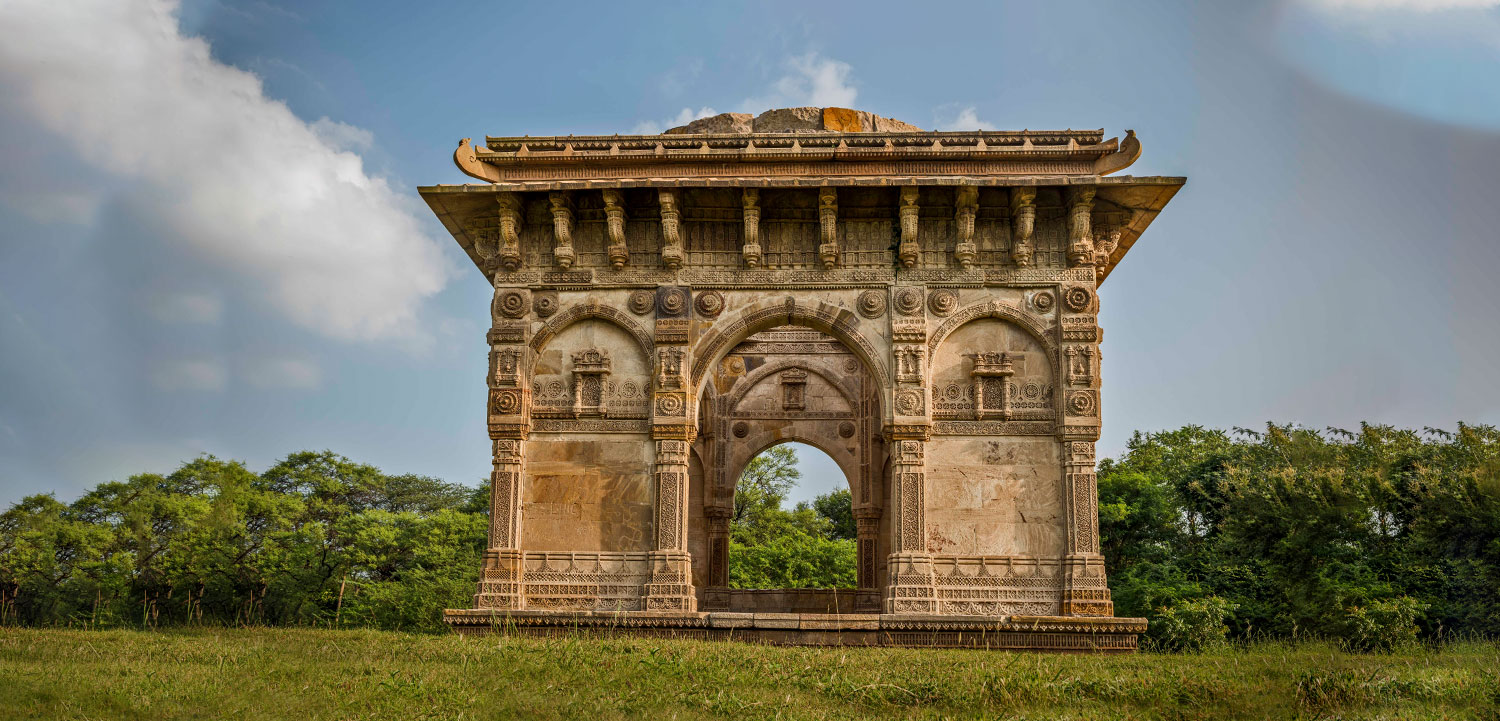
All Days Open
Photo Gallery
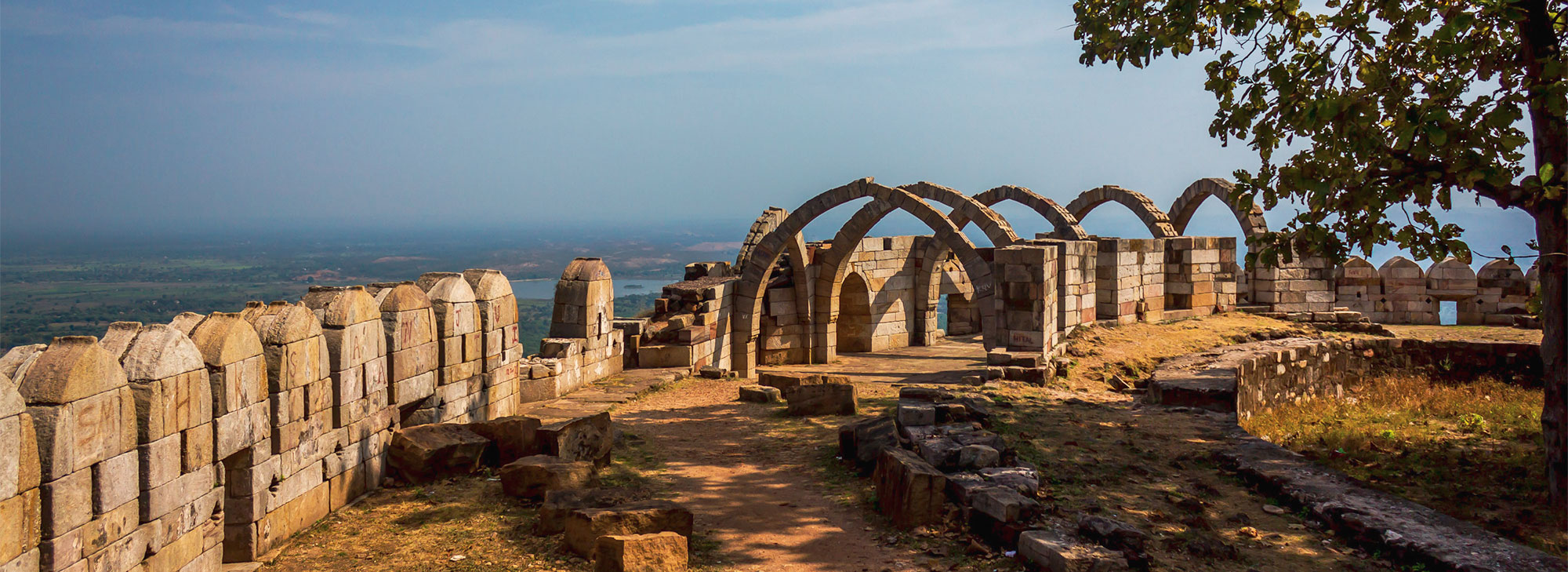
Video Gallery
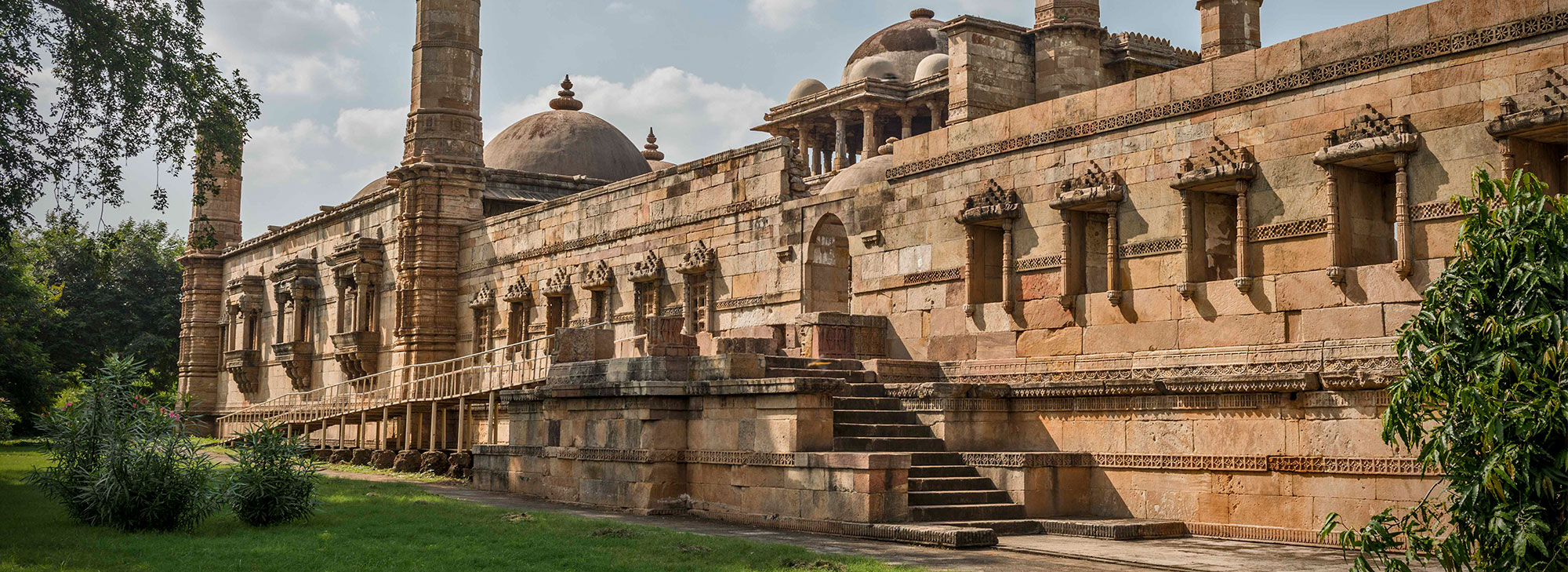
How to get there

Nearby Attractions
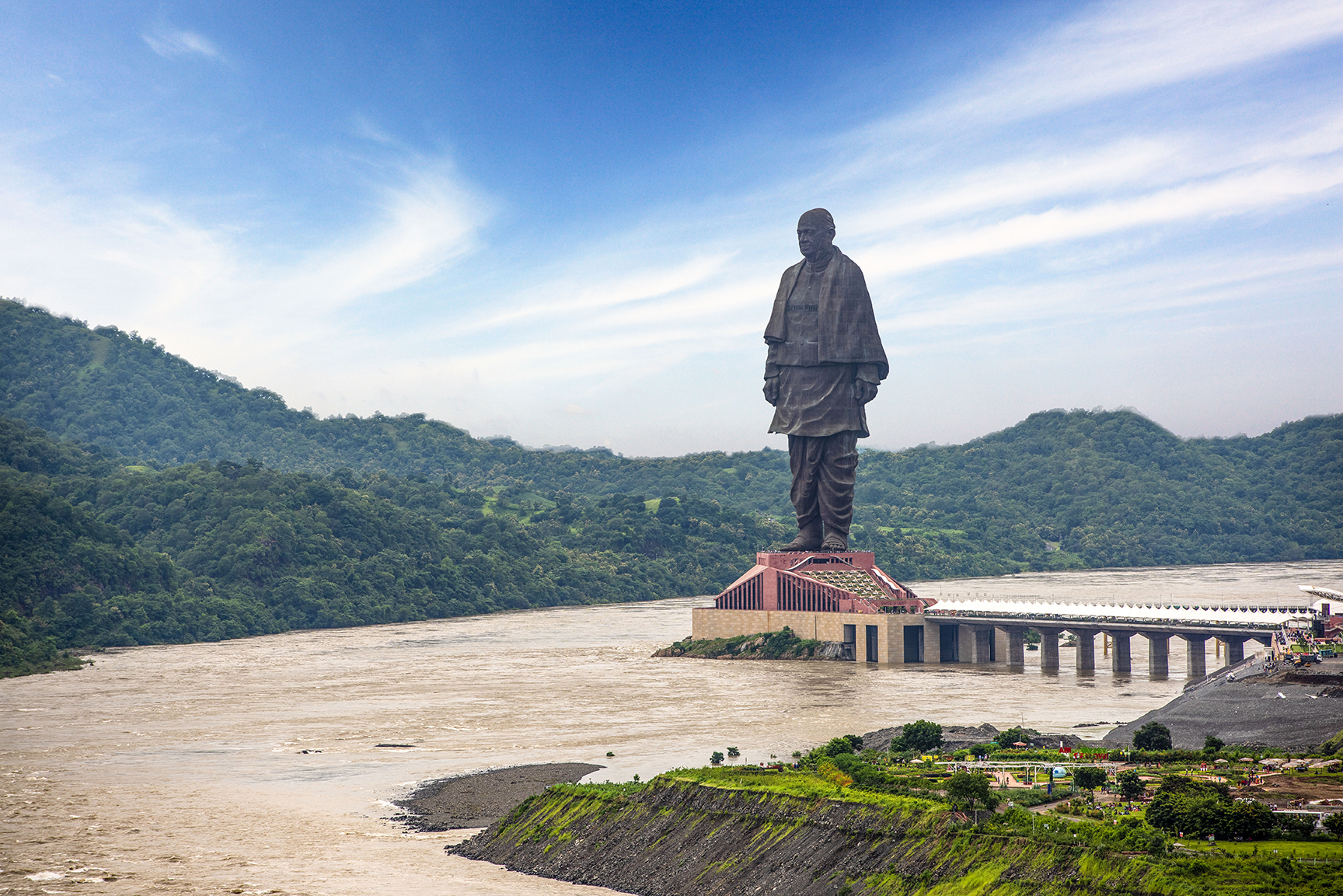
Where To Stay

Registered Tour Operators
Aspirations tours & travels, bhargv holidays private limited, destinations unlimited, registered tourist guides, naman ramaiya, pratvi dilipbhai joshi, related experiences.
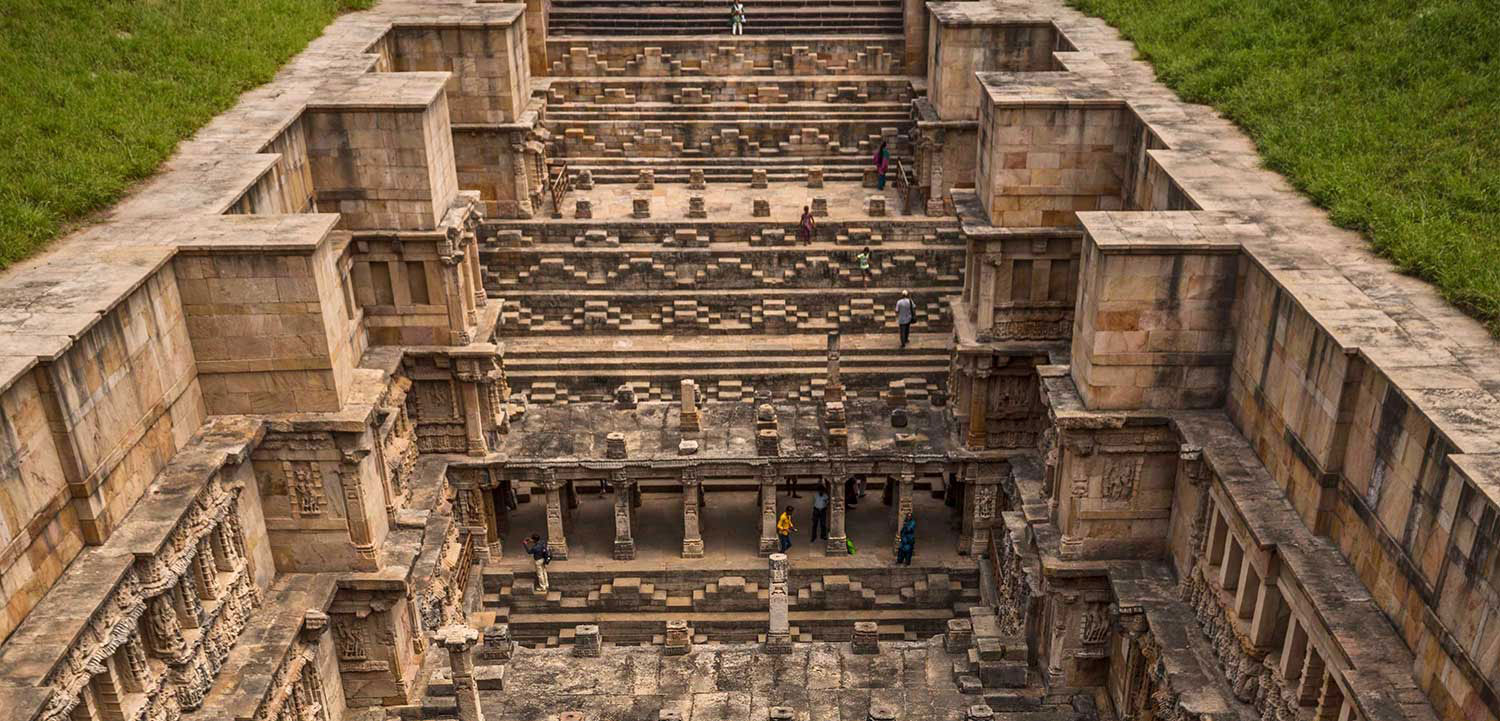
Hotel Champaner Macchi ,Pavagadh

Services & Amenities

Deluxe Ac Room

NON AC Room
Property policies.
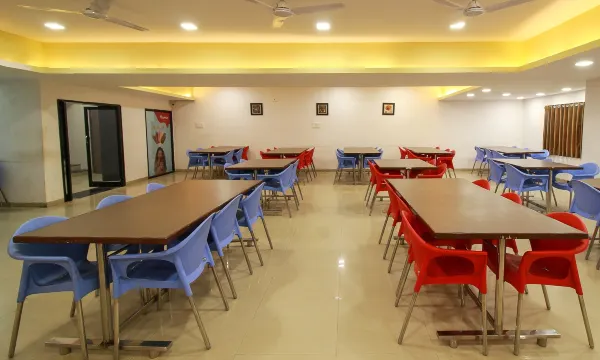
Frequently Asked Questions
How much does it cost to stay at hotel champaner macchi ,pavagadh, what is the closest airport to hotel champaner macchi ,pavagadh, what are the check-in and check-out times at hotel champaner macchi ,pavagadh, does hotel champaner macchi ,pavagadh provide airport transfer services, what amenities and services does hotel champaner macchi ,pavagadh have, does hotel champaner macchi ,pavagadh have a swimming pool, does hotel champaner macchi ,pavagadh have fitness amenities, does hotel champaner macchi ,pavagadh provide wi-fi, does hotel champaner macchi ,pavagadh have non-smoking rooms, does hotel champaner macchi ,pavagadh have a restaurant, about this property, popular hotels, popular attractions, explore more.

Southeast Asia
North America
- Central & South America
- Australia & South Pacific
- Middle-East
- Solo Travel
- Zodiac Travels
- Wellness & Spas
- Family Travel
- The Conscious Traveller
- Accessories
- Points and Miles
- Manushi Chhillar
- Quick Style
- Rajkummar Rao
- Chefs Himanshu Saini & Neha Mishra
- Poorna Jagannathan
- Guru Randhawa
- Edition 2023-24
- Edition 2022-23
- Edition 2021-22
- T+L Experiences
- Web Stories
Destinations
Discover The Many Facets of Champaner: Gujarat's Best-Kept Secret
#discovertheundiscovered: gujarat is home to many historical gems, and the architecturally-rich champaner is one of them..
By: Upasana Sarangi Published: Jan 28, 2021 07:00 AM IST
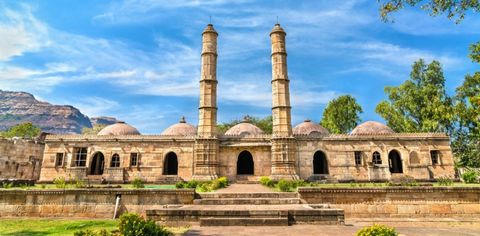
#DiscoverTheUndiscovered: Gujarat is home to many historical gems, and the architecturally-rich Champaner is one of them. Here’s how you can make the most of your trip to this mystical land. By Upasana Sarangi
Champaner is a small city in the Panchmahal district, sitting 40 km away from Vadodara , the cultural capital of Gujarat. King Vanraj Chavada of the Chavada Dynasty established this majestic land of rich historical heritage. The place was later converted into an archaeological park and has been looked after by the World Heritage Site since 2004.
View this post on Instagram A post shared by Bespoke India Holidays (@bespokeindiaholidays)
The city is peppered with 23 religious heritage sites that have been restored and ornamented. Champaner reflects the secular principles of architecture from the Mughal Era. The designs are a blend of both Hindu and Islamic construction styles. It brings out the aesthetic potential and is a visual delight for visitors. Here are a few sites that deserve a spot on your itinerary when exploring Champaner.
Pavagadh Hill and Fort
The name Pavagadh, when loosely translated, means the fire hill because it was a site of volcanic eruptions about 500 million years ago. The fort located on the top is a charm worth experiencing. The Pavagadh Fort, built in the early 14th Century, is a history lover’s paradise. You can witness the structures that were used for water retention, agricultural, military and religious purposes. The area also has ropeway facilities, which transport tourists from Pavagadh Hill to Manchi Haveli.
- Jami Masjid
Jami Masjid is one of the most exquisite mosques in western India. With the pillars being intact and the structure in complete symmetry, this mosque is a striking specimen of sustainable construction. The mosque also exhibits modern architectural designs, which help in successful water conservation. It is a place where culture and knowledge intertwine, beautifully.
View this post on Instagram A post shared by Aman Channa (@pixcellence_by_aman.channa)
Helical Stepwell
Climbing down the stairs of a 16th-century well can be an outstanding experience. It is a unique stepwell that was built along the wall of the well’s shaft and is wide enough for comfortable movement. If you are looking for some unique Instagrammable content, this is your spot.
- Kalika Mata Temple
This 10th-century temple has been standing tall, long before the development of Champaner. You can use the ropeway or walk the five-km-long track along the woods. The elevation is steep, but for travellers fond of climbing, it will be an enchanting experience. The caretakers light the temple up during festivities adding grandeur to the entire structure. In this temple, you will find a chowk, two altars and the idols. They invite devotees throughout the day since it stays open from early in the morning till late in the night.
View this post on Instagram A post shared by Ketan Doshi (@ketan_photo)
The Champaner Heritage Resort , with its plush décor and garden, is an ideal pick for a luxurious stay. They arrange picnic lunches, excursion and cycling facilities on request. They also provide regal dining experiences with authentic Gujarati delicacies.
You can also look at other stay options like Mountain Heritage Resort and Champaner Hotel by Gujarat Tourism.
Getting There
Vadodara is the closest airport to Champaner. The city is also well-connected through railways and roads.
The best time to visit Champaner would be from October to March.
Related: Gujarat’s Patan: A Must-Visit Place To Learn About India’s Rich Heritage & Architecture
- Champaner Heritage Resort
- King Vanraj Chavada
- Pavagadh Fort
Upasana Sarangi
Related stories.

Georgia May Be Getting Its First National Park — And It Has More Than Just Scenic Trails
By Caroline Eubanks

The Ideal 10-Day Kashmir Itinerary For Those Seeking Peace, Nature, And Culture
By Priya Pathiyan

Secrets In Stone: Uncovering Hindu Symbolism At Angkor Wat, Cambodia
By Punita Malhotra

Exploring Japan: A 10-Day Itinerary Packed With Fun And Adventure For First-Timers
By Sharon Alphonso

Ring In Summer With A Splash: The Best Water Parks In And Around Mumbai
By Yashita Vashishth

Visit This French Museum Displaying 1,000 Chandeliers Dating Back To The Middle Ages
By Siobhan Reid

Embrace The Susegad Vibe Along Goa's Most Beautiful Places
By Shalbha Sarda

Timing Is Everything: Discover The Best Time To Visit Rajasthan For The Ultimate Itinerary

Must-Have Thai Souvenirs: Ruang Khao Siam Sapphire, PAÑPURI, And More
By Tipapa Chandarasrivongs
Subscribe to our newsletter to get the latest on travel, stay & dining.
You’re all set
Thank you for your subscription.
Hotel Champaner
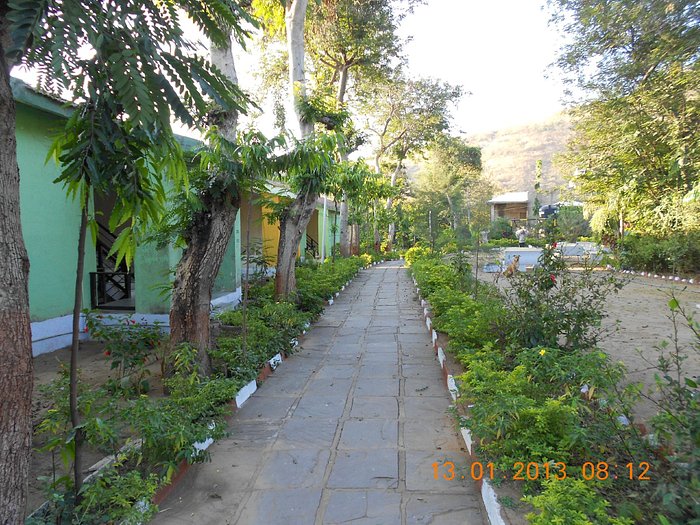
View prices for your travel dates
- Excellent 7
- Very Good 8
- All languages ( 20 )
- English ( 19 )
- Italian ( 1 )
" Go Luxury Delux Room - I like room number 505 "

" take upper floor rooms in winter and below rooms in summer... "
" Too good location "

" Choose rooms on higher side. it will give better view from gallery. "

" pls get a room backside for the superb view "
Own or manage this property? Claim your listing for free to respond to reviews, update your profile and much more.
HOTEL CHAMPANER - Reviews
- Search Search Search …
- Search Search …

How to Visit Champaner Pavagadh, Gujarat
Champaner Pavagadh made it onto our list of places to visit in Gujarat because it was added to the UNESCO list of Indian sites in 2004. It’s listed as an outstanding blend of Hindu-Muslim architecture. The sites date back to a regional Capital City built in the 16th century that now represents cultures that have disappeared. UNESCO also referenced that the Champaner Pavagadh Archaeological Park remains a place of worship and continuous pilgrimage for Hindu believers. Here’s how to visit Champaner Pavagadh.
THIS POST MAY CONTAIN COMPENSATED AND AFFILIATE LINKS MORE INFORMATION IN OUR DISCLAIMER
This site is a gloriously quiet, empty site, with amazingly little graffiti and has spectacular detail on stone carving. Go before it gets too busy! On our trip, we saw six other people visiting. This might be a UNESCO World Heritage site in India, but its location and challenges getting there mean that you’ll likely have the place to yourself! Here’s how to visit Champaner Pavagadh.
Taking a Tour of Champaner Pavagadh
Although we were based in Vadodara for our visit, it’s also possible to visit Champaner Pavagadh as a day trip from Ahmedabad , or you can now take a guided tour from Ahmedobad – using a Ministry of Tourism approved guide. Here is the best option.
EASIEST WAY TO VISIT

Take a Tour to Champaner Pavagadh
It’s an easy day trip from Ahmedabad to visit Champaner Pavagadh, and you’ll get to see all the temples and buildings in air conditioned comfort. Head out for a fabulous time – but book early.
Entry Fees to Champaner Pavagadh
Entry fees are 10 INR for Indians and 250 for Foreigners (Children up to 15 are free). Still photography is free. Ticket offices open at 8 am. If you do get there earlier, the fences are low enough to climb over – and of course pay for the ticket later.
Getting to Champaner Pavagadh
Getting to Champaner Pavagadh seemed like an easy option. We’d be based in the city of Vadodara . We planned to take a local bus to the UNESCO ruined site and have a wander around. Of course, nothing is EVER that simple in India
All the Gujarat tourism websites tell you that it’s possible to get a bus, but that it’s better to take a private car. Only one other reference that we found indicated taking a bus. They cunningly failed to mention details and that’s becoming my pet hate. I wasn’t too surprised when we arrived at the bus station (opposite the train station) this morning and couldn’t find any details in English. Or anyone who spoke more English than “No, no bus, take a taxi”. If you know which bus and how to get there, please do post details!
Arranging a Car to Champaner Pavagadh
Our hotel ( the Hampton Inn ) could arrange a car for us. We’re using Hilton Honors points to have two nights of luxury here before they expire. However, the smallest and cheapest car wasn’t available. The cost would now be 1700 INR for 8 hours and 80 kilometers. Plus 10 rupees per kilometer after that.
“So how much is that?” I asked, – oh wait, they said. It would be 1900 INR because we’d need the package that was 120 kilometers. Champaner Pavagadh was 100 kilometers. Oh and also plus tax.
We walked back to the railway station, frustrated with being unable to get a straight answer. From there we picked up a cab, driven by Ragi, from the taxi rank. It cost us 1500 INR all-inclusive, apart from the 110 INR toll for the road.
How to Go From Vadodara to Champaner Pavagadh
It takes an hour or so in the car to cover the 50 or so kilometers to Champaner Pavagadh. In terms of layout, it’s a little like Annaradhapura in Sri Lanka. Which of course isn’t useful if you’ve never been there. Let me explain more.
The Layout of Champaner Pavagadh
The Champaner Pavagadh site is actually (in its base form), in two parts. There’s the bit that’s on the hill at 830m above sea level. That’s Pavagadh, where pilgrims head up to the Kalika Mata Temple. Then there’s Champaner, the ruins of an old walled town, citadel, and its surrounding mosques and buildings.
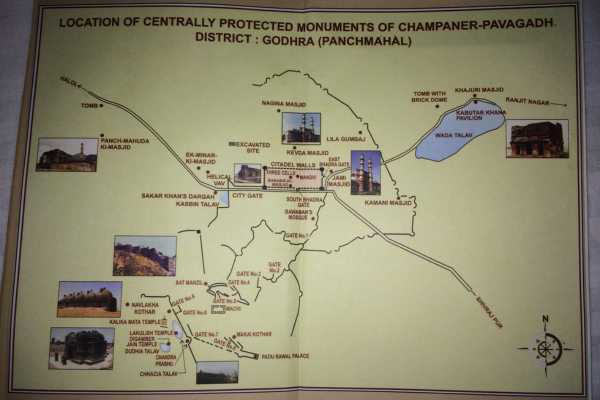
Pavagadh has several plateaus on the way to the top – and there’s a road so far up, followed by a cable way, and then a final 1 kilometer walk to the top, where you’ll find the Kalika Mata Temple. We didn’t visit this part, we concentrated on Champaner.
The IAS Heritage Guide to Champaner-Pavagadh
The Indian Archaeological Society publishes a heritage guide, which you can purchase from the ticket offices (at the Shahar-Ki Masjid or the Jami Masjid) for 100 INR.

These guides are not on display and you will have to ask for them, but they’re worth it. They might have guides for other locations on display, so if you’re reading this ahead of time, pick one up ahead of time, it will help you plan your time here.
The sites are spread over a pretty big area. You can see some idea of the distance from this view of the Jami Masjid from the roof of the Kevda Masjid.

Getting Around Champaner Pavagadh
If you’ve taken the local bus, then you’ll more than likely end up hiring a local auto-rickshaw to get around, or it will be a long slog even just to see the main sites. You could of course hop on one of the shared autos, if you’re OK with sitting on the roof, or hanging off the back and getting up close and personal with everyone else.
Ragi drove us around to the specific sites – although we walked between the Kevda Masjid and the Nagina Masjid – it’s about 800 meters each way – as there were huge thorns both on the ground and in the bushes along the side of the “track” – because it’s not enough of anything to be a road!
The Best Map of Champaner Pavagadh.
In the heritage guide is a useful map – the only one we found in days of searching, so here it is again.
You’ll notice a distinct lack of roads on this map because most of those squiggles are actually the old city walls. The road from Vadodara is the one that heads to Halol, so you enter first of all past the Ek-Minar-Ki-Masjid on your left and the Panch-Mahuda-Ki Masjid on your right. But you likely won’t spot them.
Signage here is lacking and the sites themselves are well hidden and well off the road (and that’s a good thing!). Having Ragi drive us made all of that easy. Even if the weather hadn’t been so hot, this would have been a long hike around.
More on How Champaner is Laid Out
The sites that are on the north side of the road are the ones in Champaner and MOST of the sites on the south side of the road are on the Pavagadh Hill.
The Best Order to see Champaner Pavagadh Sites
Having been around the sites, I’d recommend seeing them in the following order.
- Shahar-Ki Masjid
- Three Cells
- Kabutar Khana Pavilion
- Khajuri Masjid
- Kevda Masjid
- Nagina Masjid
- Jami Masjid
- Sakar Khans’s Tomb
- Ek-Minar-Ki Masjid
(the final two because they’re on the way back to Vadodara, there are great views to Pavagadh and a glorious sense of peace at Ek-Minar).
Shahar-Ki Masjid – Champaner Pavagadh
We started at the Shahar-Ki Masjid, just inside the gates to the Citadel and behind a gate with a small ticket office attached. This is a quiet sleepy place, there won’t be guides hanging around to see if they can take your money, so don’t forget to buy the Archeological Society guide – or read up on the sites before you get there.

This is a glorious site – if the sky is clear, then you’ll see Pavagadh in the background, it was the private mosque for the royal family. There are five mihrabs (prayer recesses) in the back wall and the entrance arch is flanked by two gloriously carved minarets.

Mandiv – Customs House
As you leave the mosque, turn left out of the gate and take a short walk – at the end of this lane – on your right, is the old Mandiv or Customs House. There’s not much left.

Leaving the Mandiv behind, and heading back towards the mosque, on the right-hand side, behind a small kissing gate are the Three Cells or Chor Kothardi – built to house prisoners sometime between 1459 and 1511. There’s again not much to see and it’s pretty stinky inside.
Khabutar Khana Pavilion and Khajuri Masjid – Champaner Pavagadh
The pavilion stands on the edge of a small lake, opposite the ruins of the Khajuri Masjid. There are holes in the upper section for pigeons and some pleasant views over the water and surrounding countryside. The ruins of the Masjid are literally just a few arches. If you’re walking.. don’t bother coming out here.
Kevda Masjid – Champaner Pavagadh
Driving back past the Jami Masjid (trust me, leave it till later) and veering off to the right, the lane that leads to the Kevda Masjid was hidden between two shacks and a tractor. Ragi had to ask a local if it was the right track, but it was worth it when we got the kilometer or so down the narrow, bumpy thorn infested track.
There’s a basic cenotaph in front of this mosque.

The mosque is rectangular with a two-storied prayer hall.

Two minarets on either side of the entranceway are spectacularly carved. The central dome is collapsed but don’t let that stop you.

There’s a small stone spiral staircase in each of the minarets Only one was open to the bottom when we visited. You’ll need a torch or a cell phone flashlight to see your way up and down. There were no spider webs or bats or anything nasty to worry about.
On the first floor, you can walk out onto the roof, walk around the collapsed dome area, but you can also go higher.
Right to the top of the minarets. And it’s worth it.
The view from the top is lovely. Not only do you see the minarets of the Jami Masjid, but you’ll get a sense of the scale of the ruins.

Nagina Masjid – Champaner Pavagadh
Leaving Kevda, we walked 800 meters or so to Nagina Masjid (follow the track around behind Kevda walking fully behind it, and just walk until you find Nagina). There was some shade, but not a great deal.
The cenotaph in front of this mosque is spectacular.

The carving on both the columns and the edging around the collapsed dome is exquisite.

Nagina looks a little unfinished, because the minarets are stopped at the second level, but again, the carving is incredible.

Inside there are three mihrabs and 80 columns supporting the roof. There is again a spiral staircase that you can take up to the first floor and also to the top of the minarets too.
While it is possible to climb out onto the roof, the only word I understood from the locals was “heart attack”, so we didn’t and just waved at them instead.
It’s a hike back to Kevda where the car is and then the main attraction.
Jami Masjid – Champaner Pavagadh
The Islamic style of architecture flourished here in Gujarat for about 250 years from the 14th century, the Jami Masjid here at Champaner is the best example of the final period of time. The design of mosques took some time to materialize, but generally follows the same themes:
There is generally an open quadrangle. This is enclosed on three sides by covered cloisters that are connected to the prayer hall.

The prayer hall has arched mihrabs or prayer recesses in the back wall, which indicate the direction of Mecca.
Minarets were often added later. In Gujarat a special feature was added, the clerestory, in the center of the prayer hall, to bring in air and light.
The Jami Masjid is the most imposing and spectacular building in Champaner, that’s why you should leave it until (almost) last.

I got stuck in the entrance way, because the carving was wonderful. Nigel dragged me through with a “don’t just stop here.” You know when you walked through the great gate at the Taj Mahal? He said. It’s almost the same when you walk through the entrance way here. ” And yes. It was. It’s spectacular.

The Muluk Khana at Jami Masijd
There is a separate screened off entrance – the Muluk Khana that was reserved for Royal Ladies.
There are glorious mihrabs.

Carvings on the ceiling.

There are 172 pillars to hold up the domes and ceiling.

It is spectacular.

Leaving Jami Masjid and taking the road back towards Vadodara we head for our penultimate stop, Sakar Khans Tomb.
Sakar Khans’ Tomb – Champaner Pavagadh
This is the largest tomb structure in the old city – there’s not much to see. It’s square, covered with a large dome. There are open arches on each side and floral motifs decorate each side. There are views of Pavadgah behind the tomb.

Ek-Minar-Ki Masjid – Champaner Pavagadh
Our final stop in Champaner is here. It’s off the road to the right, down a small lane. There is a sign at the roadway, but it’s pretty overgrown. When we get there, two guys are sat in the shade another pulls up on a motorbike with his lunch. If we thought the rest of Champaner was sleepy, then this takes the biscuit.
There’s a cursory glance at our tickets and more of a surprised look that we’re actually here. Because there’s not much here.
Just the one minaret, with spectacular carving.

There are five stories on the minaret, the lower is square, the first has eight sides, the second and third have sixteen and the top is circular.

A tank. And – says the guide, “evidence of a well”.

Yup. That looks like evidence to me.
UNESCO Sites to Visit in India
If you like visiting UNESCO World Heritage Sites, then you’ll love our guides to India’s best World Heritage sites
- Champaner Pavagadh, in Gujarat
- The Taj Mahal in Agra
- The Ajanta Caves
- Ellora Caves
- Khajuraho’s Temples
- Humayun’s Tomb, Delhi
- The Hill Forts of Rajasthan
- The Darjeeling Hill Railway
- Qutub Minar in Delhi
- The Mahabodhi Temple in Bodhgaya
- Mamallapuram
Travel Tips for Exploring India
- Considering travel insurance for your trip? World Nomads offers coverage for more than 150 adventure activities as well as emergency medical, lost luggage, trip cancellation, and more.
- Get online immediately with an eSIM for India
- Protect your data – use a VPN in India – use this coupon to get 3 months free.
- Book the best tours and guides in India on GetYourGuide or Klook
- Find the right accommodation for you via Booking.com
- Book Trains and Buses in India with 12goAsia
Final Thoughts on Visiting Champaner Pavagadh
What it does leave us with, as we take our leave of Champaner. Is an incredible sense of peace. Of what I think a UNESCO site should be. Maintained and not destroyed or Disneyfied by the desire to churn through as many tourists as possible – like the Shilin Stone Forest in China for instance.
We’ve spent perhaps 3 hours pottering slowly around Champaner, plus an hour each way in the car, it’s been a relaxed and lovely view into the history of this glorious place, there’s definitely something to be said for the UNESCO sites that are off the beaten track!
We receive a fee when you get a quote from World Nomads using our affiliate links. We do not represent World Nomads. This is not a recommendation to buy travel insurance.
ASocialNomad is a participant in the Amazon Services LLC Associates Program, an affiliate advertising program designed to provide a means for sites to earn advertising fees by advertising and linking to amazon.com, amazon.co.uk, and amazon.ca. Amazon and the Amazon logo are trademarks of Amazon.com, Inc. or its affiliates. As an Amazon Associate, I earn from qualifying purchases .
Sarah Carter
Leave a comment cancel reply.
Your email address will not be published. Required fields are marked *
Save my name, email, and website in this browser for the next time I comment.
4 thoughts on “ How to Visit Champaner Pavagadh, Gujarat ”
- 4 comments
This is some of my favourite architecture on your trip, so far. Amazing!
It is truly stunning and the more so because it was empty. Wait until you see Sanchi… And Khajuraho oh and the Golden Temple!
Thanks for this fantastic blog post. Really helped me plan my day yesterday, and it was great.
Two bits of info back:
1. The public bus leaves from the ST Bus Stand slightly north of the railway station, across the road in a big shopping centre. Hourly from near stands 16/17/18, first bus at 6am. It turns up and they shout Pavagadh! Pavagadh! Pavagadh! And you have to rush, buy tickets once on board. Ask at counters to confirm time and ask people near stands to find someone else going. Cost 50 rupee. On return, I used a shared taxi (Baroda! Baroda! Baroda!) cost 100.
2. Best map I found was Google Maps. You can download areas for offline use now. The major temples in this post are all on there. GPS is invaluable for quickly navigating around. It’s about 1km between each temple – I walked round the main 5 or so really easily with no car or rick.
I did Champaner at 7.30am (super peaceful up the minarets, great country views) then did Pavagadh after. Was fine.
Thanks Francis! I’ll put that into the blog and credit you. I guess we didn’t get up early enough and were at the wrong bus station! Glad you enjoyed it and the peace of the place!
Privacy Overview
Winter is here! Check out the winter wonderlands at these 5 amazing winter destinations in Montana
- Travel Destinations
How To Visit Champaner Pavagadh, Gujarat
Published: September 7, 2023
Modified: January 3, 2024
by Molli Hatch
- Plan Your Trip
- Travel Guide
- Travel Tips
How to Visit Champaner Pavagadh, Gujarat
Introduction.
Located in the Indian state of Gujarat, Champaner and Pavagadh are two historically significant towns that hold immense cultural and archaeological importance. These twin towns are known for their rich heritage and attract visitors from around the world. Champaner is a UNESCO World Heritage site and Pavagadh is a sacred hill where devotees flock to pay homage to the goddess Kalika.
Champaner Pavagadh offers a unique blend of natural beauty, historical treasures, and religious sites. The region is dotted with ancient monuments, forts, temples, and archaeological sites that date back to the 8th century. Whether you are a history enthusiast, a nature lover, or a spiritual seeker, Champaner Pavagadh has something to offer for everyone.
In this guide, we will take you on a journey to explore the wonders of Champaner Pavagadh and provide you with essential information to make your visit a memorable one. From transportation options to accommodation choices and must-visit attractions, we’ve got you covered.
So, get ready to immerse yourself in the rich history, breathtaking landscapes, and spiritual fervor that await you in Champaner Pavagadh.
Getting to Champaner Pavagadh
Champaner Pavagadh is well-connected to major cities in Gujarat and the rest of India. Here are the different modes of transportation you can choose from to reach Champaner Pavagadh:
- By Air: The closest airport to Champaner Pavagadh is Vadodara Airport, which is approximately 50 kilometers away. Vadodara Airport is well-connected to major cities in India, including Delhi, Mumbai, and Bangalore. From the airport, you can hire a taxi or take a bus to reach Champaner Pavagadh.
- By Train: The nearest railway station to Champaner Pavagadh is Vadodara Junction, which is well-connected to major cities in India. From Vadodara Junction, you can take a local bus or hire a taxi to reach Champaner Pavagadh, which is around 45 kilometers away.
- By Road: Champaner Pavagadh can be easily reached by road as well. The towns are well-connected to nearby cities and towns through a network of well-maintained roads. You can drive to Champaner Pavagadh or hire a private cab. State-run buses also ply regularly between Champaner Pavagadh and Vadodara.
Once you reach Champaner Pavagadh, you can explore the region on foot or hire a local guide to make the most of your visit. The town is compact and can be easily covered on foot, allowing you to immerse yourself in the historical and cultural charm of the place.
Exploring Champaner Pavagadh
Champaner Pavagadh offers a unique blend of history, spirituality, and natural beauty. As you explore this fascinating destination, here are some highlights you wouldn’t want to miss:
- Champaner Fort: Start your journey by visiting the magnificent Champaner Fort, which dates back to the 16th century. The fort is a perfect example of Indo-Islamic architecture and offers stunning views of the surrounding landscapes. Explore its intricate carvings, ornate gateways, and well-preserved structures as you delve into the history of the region.
- Archaeological Park: Step back in time as you wander through the sprawling Archaeological Park. This vast complex is home to various ancient structures, including mosques, temples, stepwells, and tombs. Admire the intricate craftsmanship and marvel at the architectural brilliance that still stands tall.
- Champaner Heritage Walk: Embark on the Champaner Heritage Walk, a guided tour that takes you through the town’s narrow lanes, ancient buildings, and historical sites. Learn about the town’s fascinating history, folklore, and legends while soaking in the vibrant atmosphere.
- Kalika Mata Temple: Pay a visit to the revered Kalika Mata Temple, located atop the Pavagadh Hill. This sacred Hindu temple attracts devotees from far and wide who come to seek blessings from the goddess Kalika. The temple offers panoramic views of the surrounding valleys, making it a truly awe-inspiring experience.
Apart from these key attractions, you can also enjoy activities like trekking on the Pavagadh Hill, exploring the Jama Masjid, and taking a cable car ride to soak in the scenic beauty from above. Don’t forget to indulge in the local cuisine, which offers a delightful blend of Gujarati flavors and influences from the region’s rich history.
Exploring Champaner Pavagadh is like stepping into a captivating tale of bygone eras. Whether you are a history buff, a devotee seeking spiritual solace, or simply a traveler enchanted by natural beauty, this destination will leave an indelible mark on your heart and mind.
Major Attractions in Champaner Pavagadh
Champaner Pavagadh is home to a plethora of attractions that showcase the rich history and cultural heritage of the region. Here are some of the major highlights that you should include in your itinerary:
- Champaner Fort: The imposing Champaner Fort is a must-visit attraction in Champaner Pavagadh. This UNESCO World Heritage site is a magnificent example of Indo-Saracenic architecture. Explore the intricate carvings, decorative elements, and impressive fortifications as you step back in time.
- Pavagadh Hill: A visit to Champaner Pavagadh is incomplete without exploring Pavagadh Hill. This sacred hill is believed to be the abode of the goddess Kalika and is a popular pilgrimage site. Take a trek to the hilltop to visit the Kalika Mata Temple and enjoy panoramic views of the surrounding landscapes.
- Archaeological Park: Discover the rich archaeological treasures of Champaner Pavagadh at the Archaeological Park. This vast complex houses numerous historical structures, including mosques, temples, stepwells, and tombs. Marvel at the intricate craftsmanship and architectural splendor as you stroll through the park.
- Champaner Heritage Walk: Immerse yourself in the history and culture of the town by taking the Champaner Heritage Walk. This guided tour takes you through the narrow lanes, ancient buildings, and historical sites of Champaner. Learn about the town’s fascinating past and listen to intriguing stories and legends.
- Jama Masjid: Visit the Jama Masjid, the largest mosque in Champaner, known for its exquisite architecture. Admire the intricate carvings, beautiful domes, and minarets as you soak in the spiritual ambiance of this sacred place.
These are just a few of the major attractions in Champaner Pavagadh. The region is filled with hidden gems waiting to be explored and each site offers a unique glimpse into the rich history and cultural tapestry of the area. Spend time in this historical wonderland and let the stories of the past unfold before your eyes.
Visiting the Pavagadh Hill
The Pavagadh Hill, located in Champaner Pavagadh, is a significant pilgrimage site and a natural marvel that attracts visitors from all over. Here is everything you need to know about visiting this iconic landmark:
1. Ascending the Hill: To reach the top of Pavagadh Hill, you can choose from two main options. The first is a strenuous but rewarding trek that takes you through lush green forests and ancient steps carved into the hill. The second option is to take a cable car ride from the foothills, which offers a convenient and scenic way to reach the top.
2. Kalika Mata Temple: At the summit of Pavagadh Hill, you will find the revered Kalika Mata Temple. This ancient temple dedicated to the goddess Kalika is of great religious significance. Take some time to explore the temple complex, admire the elaborate architecture, and soak in the spiritual atmosphere. Don’t forget to catch the mesmerizing panoramic views of the surrounding valleys from the temple premises.
3. Pilgrimage and Festivals: Pavagadh Hill is considered a sacred place by devotees who undertake a pilgrimage to seek the blessings of the goddess Kalika. The hill is especially crowded during Navaratri, a nine-night festival dedicated to the worship of the goddess. Witness the fervor and devotion of thousands of pilgrims as they participate in religious rituals and celebrations during this auspicious time.
4. Natural Beauty: Apart from its cultural and religious significance, Pavagadh Hill is also a natural marvel. As you ascend the hill, you will be greeted with breathtaking views of the surrounding landscapes, dense forests, and verdant valleys. The serenity and tranquility of the hill make it an ideal place for nature lovers and photographers.
5. Safety Measures: While visiting Pavagadh Hill, it is important to prioritize safety. It is advisable to wear comfortable shoes and carry drinking water during the trek. If you choose the cable car option, be mindful of the departure and return timings. Respect the religious sentiments of fellow visitors and maintain cleanliness.
Whether you are a pilgrim seeking spiritual solace or a traveler in search of natural beauty, a visit to Pavagadh Hill is truly an enriching experience. Soak in the divinity, admire the architectural marvels, and immerse yourself in the untouched serenity of this sacred hill of Champaner Pavagadh.
Visiting the Champaner Fort
The Champaner Fort, located in Champaner Pavagadh, is a historical marvel that showcases the grandeur of the bygone era. Here is all you need to know about visiting this magnificent fort:
1. Historical Significance: The Champaner Fort holds immense historical importance as it dates back to the 16th century. It stands as a testament to the rich heritage and architectural brilliance of the region. The fort is a combination of Hindu, Jain, and Islamic architectural styles, reflecting the diverse cultural influences of the time.
2. Architecture and Structures: As you explore the Champaner Fort, you will be mesmerized by its impressive architecture and well-preserved structures. The fort encompasses elaborate gateways, intricate carvings, and magnificent palaces, showcasing the artistic excellence and craftsmanship of ancient times. The Jama Masjid, Kevada Masjid, and Sikandar Shah’s Tomb are some of the key structures within the fort complex.
3. Exploring the Fort Complex: Take your time to wander through the sprawling fort complex and immerse yourself in its historical ambiance. Marvel at the intricate details, pass through the imposing gateways, and soak in the panoramic views of the surrounding landscapes. The fort offers a captivating insight into the reign of the Champaner rulers and the architectural magnificence of the era.
4. Photography and Views: The Champaner Fort provides ample opportunities for photography enthusiasts to capture stunning shots. The mix of architectural elements, intricate carvings, and scenic views make for captivating compositions. Don’t miss the chance to capture the panoramic vistas of the surrounding landscapes from different vantage points in the fort.
5. Safety and Guidelines: When visiting the Champaner Fort, it is important to follow safety guidelines and respect the historical significance of the structures. Be mindful of the designated paths, avoid touching or climbing on the ancient structures, and do not litter. Additionally, carry water and wear comfortable footwear, as the fort complex involves walking on uneven terrain.
Exploring the Archaeological Park
The Archaeological Park in Champaner Pavagadh is a treasure trove of historical wonders, offering visitors a fascinating glimpse into the rich heritage of the region. Here’s what you need to know about exploring this expansive park:
1. Architectural Marvels: The Archaeological Park is home to a plethora of ancient structures and monuments, each showcasing exquisite craftsmanship and architectural brilliance. From ancient temples and mosques to stepwells and tombs, the park is a treasure trove of diverse architectural styles and historical significance.
2. Historical Significance: As you wander through the park, you’ll come across remnants of the glorious past, dating back to the 8th century. These architectural marvels bear testimony to the historical and cultural evolution of Champaner Pavagadh. Take your time to explore each site and soak in the stories and legends associated with them.
3. Mosque of Champaner: One of the prominent structures within the Archaeological Park is the grand Jama Masjid or the Mosque of Champaner. This majestic mosque is known for its elaborate carvings, intricate lattice work, and stunning architectural details. Step inside to experience the serenity and spiritual ambiance of this sacred place.
4. Kevada Masjid: Another significant structure within the park is the Kevada Masjid, renowned for its unique blend of Hindu and Islamic architectural elements. The mosque stands as a symbol of religious harmony and architectural brilliance. Admire the ornate decorations and fine carvings that adorn its walls.
5. Stepwells and Tombs: The Archaeological Park is also home to ancient stepwells and tombs that offer a peek into the architectural and hydraulic engineering prowess of the past. These structures are not just architectural marvels, but also served as important water sources during their time.
Experiencing the Champaner Heritage Walk
The Champaner Heritage Walk is a guided tour that takes you on a journey through the narrow lanes, ancient buildings, and historical sites of Champaner Pavagadh, offering a captivating glimpse into the town’s rich history and cultural heritage. Here’s what you can expect from this immersive experience:
1. Historical Narrative: The Champaner Heritage Walk is not just a stroll through the town; it’s a storytelling experience that brings history to life. Accompanied by knowledgeable guides, you’ll learn about the town’s founding, the reign of the Champaner rulers, and the subsequent influences of various dynasties.
2. Architectural Gem: As you walk through the narrow lanes, you’ll encounter exquisite architectural gems that showcase the diverse influences of Hindu, Islamic, and Jain cultures. From intricately carved doorways and ornate facades to majestic palaces and ancient temples, the architectural splendors of Champaner will leave you spellbound.
3. Hidden Treasures: The Champaner Heritage Walk allows you to explore the lesser-known nooks and crannies of the town, uncovering hidden treasures along the way. Discover the charm of ancient stepwells, explore the remnants of forgotten structures, and listen to intriguing stories about the town’s past that are often missed by casual tourists.
4. Cultural Insight: Beyond the architectural wonders, the heritage walk provides a deeper understanding of the region’s cultural tapestry. Discover the vibrant local traditions, witness the influence of different communities, and experience the warm hospitality of the people of Champaner Pavagadh.
5. Photography Opportunities: The Champaner Heritage Walk offers plenty of opportunities for photography enthusiasts to capture stunning shots. From capturing the intricate details of ancient structures to capturing candid moments of local life, every step of the walk presents a unique photo-worthy moment.
Visiting the Kalika Mata Temple
The Kalika Mata Temple, located atop the Pavagadh Hill in Champaner Pavagadh, is one of the most revered and important Hindu temples in Gujarat. Here’s what you need to know when visiting this sacred pilgrimage site:
1. Religious Significance: The Kalika Mata Temple holds immense religious significance, dedicated to the fierce form of the goddess Kali, known as Kalika Mata. Devotees believe that visiting the temple and seeking the blessings of the goddess brings prosperity, protection, and fulfillment of desires.
2. Ascending the Hill: To reach the Kalika Mata Temple, you have two options. The first is to take a challenging but rewarding trek up the steps that wind through the hills, surrounded by natural beauty. The second option is to take a convenient cable car ride that offers panoramic views of the surroundings as you ascend to the temple.
3. Temple Architecture: The Kalika Mata Temple boasts exquisite architecture and intricate carvings, reflecting the rich cultural heritage of Gujarat. The temple is adorned with beautiful idols and sculptures, showcasing the craftsmanship of ancient artisans. The sanctum sanctorum houses the idol of Kalika Mata, with devotees offering prayers and seeking blessings.
4. Spiritual Experience: Visiting the Kalika Mata Temple is a deeply spiritual experience. The serene atmosphere and the devotion of the fellow worshippers create a sense of tranquility. Participate in the religious rituals, listen to the chanting of hymns, and let the divinity of the temple envelop you.
5. Panoramic Views: The Kalika Mata Temple offers breathtaking panoramic views of the surrounding valleys and landscapes. Take a moment to admire the natural beauty spread before your eyes, capturing the serene atmosphere and picturesque surroundings.
Enjoying the Cable Car Ride
One of the most thrilling experiences in Champaner Pavagadh is the cable car ride that takes you from the foothills to the top of Pavagadh Hill. Here’s what you need to know to make the most of this exciting adventure:
1. Scenic Beauty: The cable car ride offers breathtaking panoramic views of the surrounding landscapes as you ascend to the top of Pavagadh Hill. Enjoy the lush greenery, rolling hills, and the winding paths that lead to the temple complex. It’s a chance to marvel at the natural beauty and capture stunning photographs along the way.
2. Convenient and Time-Saving: Taking the cable car is a convenient and time-saving way to reach the top, especially for those who may not be able to undertake the strenuous trek. The cable car operates at regular intervals, providing a hassle-free way to enjoy the scenic journey and ensuring that you have more time to explore the attractions on Pavagadh Hill.
3. Thrilling Experience: The cable car ride itself is an exhilarating experience, offering a bird’s-eye view of the surrounding area. As you glide above the treetops and the rugged terrain, you can feel the adrenaline rush and the sense of adventure. It’s an experience that adds an extra layer of excitement to your visit to Champaner Pavagadh.
4. Accessibility: The cable car is accessible to people of all ages and physical abilities, making it a suitable option for families, older adults, and individuals with mobility challenges. It allows everyone to enjoy the beauty of Pavagadh Hill without the physical exertion of a trek.
5. Safety Measures: It’s important to adhere to safety guidelines while enjoying the cable car ride. Follow the instructions of the staff, remain seated throughout the journey, and keep any personal belongings secure. Be aware of any weight restrictions and capacity limits for each cable car cabin.
Exploring the Jama Masjid
The Jama Masjid in Champaner Pavagadh is an architectural marvel that reflects the rich cultural heritage of the region. Here’s everything you need to know about exploring this magnificent mosque:
1. Historical Significance: The Jama Masjid holds immense historical and religious significance. It was built during the rule of Sultan Mahmud Begada and is considered one of the finest examples of Indo-Islamic architecture in Gujarat. The mosque stands as a testimony to the glorious past of Champaner Pavagadh.
2. Architecture and Design: The Jama Masjid showcases a beautiful blend of Hindu and Islamic architectural elements. The mosque features intricate carvings, delicate lattice work, and stunning domes. The minarets and the main prayer hall are adorned with exquisite details, adding to the grandeur and elegance of the structure.
3. Spiritual Ambiance: Stepping into the Jama Masjid evokes a sense of tranquility and spirituality. The serene atmosphere and the rhythmic chants of prayers create a peaceful ambiance. Visitors are welcome to sit and reflect, or join the worshippers during prayer times, experiencing a connection to the divine.
4. Photography Opportunities: The Jama Masjid offers ample opportunities for photography enthusiasts to capture the intricate architectural details and the serene ambiance. Capture the intricate carvings, the play of light and shadow, and the majestic domes to immortalize the beauty of this historical masterpiece.
5. Cultural and Historical insights: Exploring the Jama Masjid provides insights into the rich cultural tapestry of Champaner Pavagadh. The mosque stands as a symbol of communal harmony and religious tolerance, perfectly blending different architectural influences. Take the time to learn about the historical significance of this religious site and its place in the local community.
Trying Local Cuisine in Champaner Pavagadh
Exploring Champaner Pavagadh is not just about immersing yourself in its rich history and architectural wonders, but also about indulging in the flavors of its local cuisine. Here’s a guide to trying the delectable local dishes that will tantalize your taste buds:
1. Gujarati Thali: When in Gujarat, experiencing a traditional Gujarati Thali is a must. These elaborate meals showcase a variety of vegetarian dishes, including vegetable curries, lentils, pickles, and freshly-baked bread. Make sure to savor the flavors of locally-sourced ingredients and the burst of spices that define Gujarati cuisine.
2. Khaman Dhokla: Champaner Pavagadh is known for its delectable Khaman Dhokla, a savory snack made from fermented chickpea flour. It’s steamed and garnished with mustard seeds, curry leaves, and a generous drizzle of tangy chutneys. The soft and spongy texture, combined with the tangy and slightly sweet flavor, makes it a favorite among locals and visitors alike.
3. Fafda and Jalebi: Fafda and Jalebi is a popular combination in Gujarat and a must-try in Champaner Pavagadh. Fafda is a crispy snack made from chickpea flour, served with spicy chutneys or yogurt. Jalebi, on the other hand, is a sweet treat made from fermented batter, fried until golden and soaked in sugar syrup. Indulge in the contrasting flavors of sweet and savory with this classic combination.
4. Theplas: Theplas are a staple in Gujarat and a delicious treat to try in Champaner Pavagadh. These thin, spiced flatbreads are made from whole wheat flour, flavored with fenugreek leaves, and served with a dollop of ghee or yogurt. Pair them with pickles or curries for a wholesome and satisfying meal.
5. Local Snacks: Don’t miss out on the local snacks that are unique to this region. Savor the flavors of dishes like Sev Usal, Khandvi, and Handvo. These snacks offer a delightful blend of textures and flavors, from spicy and tangy to sweet and savory.
Accommodation Options in Champaner Pavagadh
Champaner Pavagadh offers a range of accommodation options to suit different preferences and budgets. Here are a few options to consider for your stay in this captivating destination:
1. Heritage Hotels and Resorts: Experience the charm of bygone eras by staying at a heritage hotel or resort in Champaner Pavagadh. These accommodations are often restored historical buildings that offer a unique blend of luxury, comfort, and cultural ambiance. Enjoy modern amenities while immersing yourself in the rich heritage of the region.
2. Budget Hotels and Guesthouses: For budget-conscious travelers, there are several affordable hotels and guesthouses available in Champaner Pavagadh. These accommodations provide comfortable rooms, basic amenities, and a convenient base for exploring the town and its surroundings.
3. Homestays and Farmstays: Immerse yourself in the local culture and hospitality by opting for a homestay or farmstay experience. Stay with a local family or on a working farm to gain an authentic insight into the daily life, traditions, and cuisine of the region. This is an excellent option for those seeking a more immersive and personalized experience.
4. Tents and Camping: For adventure enthusiasts and nature lovers, camping options are available in the vicinity of Champaner Pavagadh. Set up tents amidst lush greenery, enjoy bonfires under the starry sky, and wake up to the sounds of nature. This option allows you to truly connect with the natural beauty of the area.
5. Nearby Accommodations: If you prefer to stay in a larger city and visit Champaner Pavagadh as a day trip, you can find accommodation options in nearby cities like Vadodara or Ahmedabad. These cities offer a wide range of hotels, guesthouses, and serviced apartments to suit various budgets and preferences.
Tips for Visiting Champaner Pavagadh
Visiting Champaner Pavagadh is an exciting and enriching experience. To make the most of your trip, here are a few tips to keep in mind:
- Plan Your Visit: Champaner Pavagadh has several attractions to explore, so plan your itinerary in advance to make the most of your time. Consider the opening and closing hours of various sites and allocate sufficient time to fully experience each place.
- Be Mindful of the Weather: Check the weather forecast before your visit and dress accordingly. Champaner Pavagadh experiences hot summers and mild winters, so pack sunscreen, hats, and light clothing for the summer months, and carry a light jacket or shawl for cooler evenings.
- Stay Hydrated: Carry a water bottle with you and stay hydrated, especially during the summer months. There are limited water and food options available at some sites, so it’s advisable to carry snacks and drinks with you.
- Wear Comfortable Footwear: Exploring Champaner Pavagadh often involves walking and climbing steps, so wear comfortable footwear to ensure a pleasant experience. Avoid high heels or sandals with minimal support.
- Respect Local Customs: Champaner Pavagadh is a place of religious and cultural importance. Respect local customs and traditions. Dress modestly and be mindful of any specific rules or regulations at religious sites.
- Carry Cash: It’s advisable to carry sufficient cash with you, as some smaller establishments and vendors may not accept card payments. ATMs are available in nearby towns, but it’s best to have cash on hand for small expenses.
- Engage Local Guides: To enrich your understanding of the history and significance of the sites, consider hiring a local guide. They can provide valuable insights, share interesting stories, and help you navigate through the attractions.
- Take Care of Your Belongings: While exploring Champaner Pavagadh, keep a close eye on your belongings and avoid carrying valuable items. It’s advisable to use a secure bag and keep your belongings close to you at all times.
- Follow COVID-19 Guidelines: Due to the ongoing pandemic, it’s important to adhere to the COVID-19 guidelines issued by the government and health authorities. Practice social distancing, wear masks, and follow any specific safety protocols in place at the attractions.
By keeping these tips in mind, you can have a smooth and enjoyable visit to Champaner Pavagadh, immersing yourself in its history, culture, and natural beauty, while respecting the local traditions and preserving the sanctity of the sites.
Champaner Pavagadh in Gujarat, India, is a destination that offers a captivating blend of history, spirituality, and natural beauty. From the ancient ruins of Champaner Fort and the Archaeological Park to the pilgrimage to the Kalika Mata Temple and the thrilling cable car ride to Pavagadh Hill, there are experiences to enthrall every visitor. Exploring the narrow lanes, savoring the local cuisine, and learning about the rich cultural heritage through the Champaner Heritage Walk are activities that provide a deeper understanding of the region.
As you roam through Champaner Pavagadh, you’ll be transported back in time, immersing yourself in the grandeur, architectural brilliance, and spiritual fervor that still resonate in this UNESCO World Heritage site. The diverse range of accommodation options caters to different needs and budgets, ensuring a comfortable stay during your visit.
Whether you are a history enthusiast, a nature lover, or a spiritual seeker, Champaner Pavagadh offers a memorable journey. Follow the tips provided to make the most of your visit, respecting the local customs and embracing the cultural heritage of this extraordinary destination.
So, come and discover the treasures of Champaner Pavagadh – a land that holds tales from the past and promises a captivating present. Immerse yourself in the beauty, spirituality, and heritage of this enchanting place, and let the magic of Champaner Pavagadh leave an indelible mark on your heart and mind.

- Privacy Overview
- Strictly Necessary Cookies
This website uses cookies so that we can provide you with the best user experience possible. Cookie information is stored in your browser and performs functions such as recognising you when you return to our website and helping our team to understand which sections of the website you find most interesting and useful.
Strictly Necessary Cookie should be enabled at all times so that we can save your preferences for cookie settings.
If you disable this cookie, we will not be able to save your preferences. This means that every time you visit this website you will need to enable or disable cookies again.
A Solo Female Travel Blog
My Guide To Champaner – The Ancient City Of Gujarat
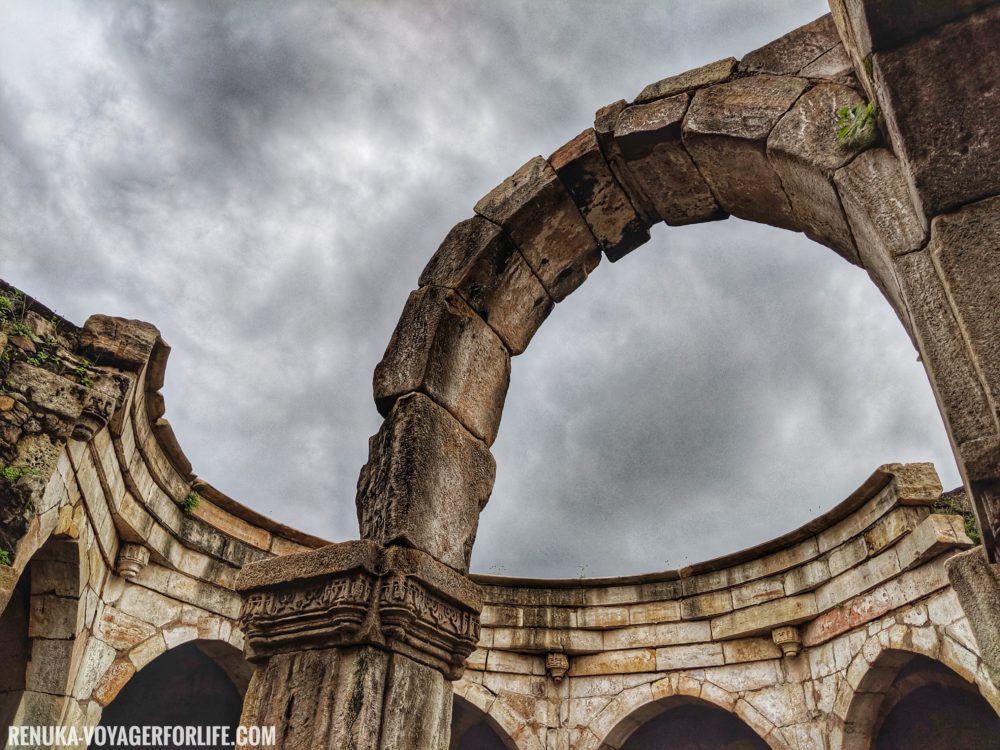
Champaner is a historic city in Gujarat. It’s an offbeat travel destination for inquisitive travellers. My travel guide is going to help you know the city, its heritage places, things to do, how to commute locally and where to stay in Champaner.
Ah, Champaner! Why did I even consider Champaner ? To be honest, I never thought of it until I saw this ad by Gujarat Tourism where Amitabh Bachchan is shown marveling at the historic sights of Champaner. I was hooked on instantly! I didn’t have to think much. I booked my tickets pronto. Travel should be like that – like a bubble that blows beautifully in the air, but doesn’t disappear.
So, Champaner was kind of a surprise, which landed in my lap. I had no plans to visit Gujarat this year. I had been to Kutch in 2015, and it was one of my most fabulous solo trips in India.
You can read My Guide To Kutch – Top 5 Experiences and get inspired to experience Gujarat .
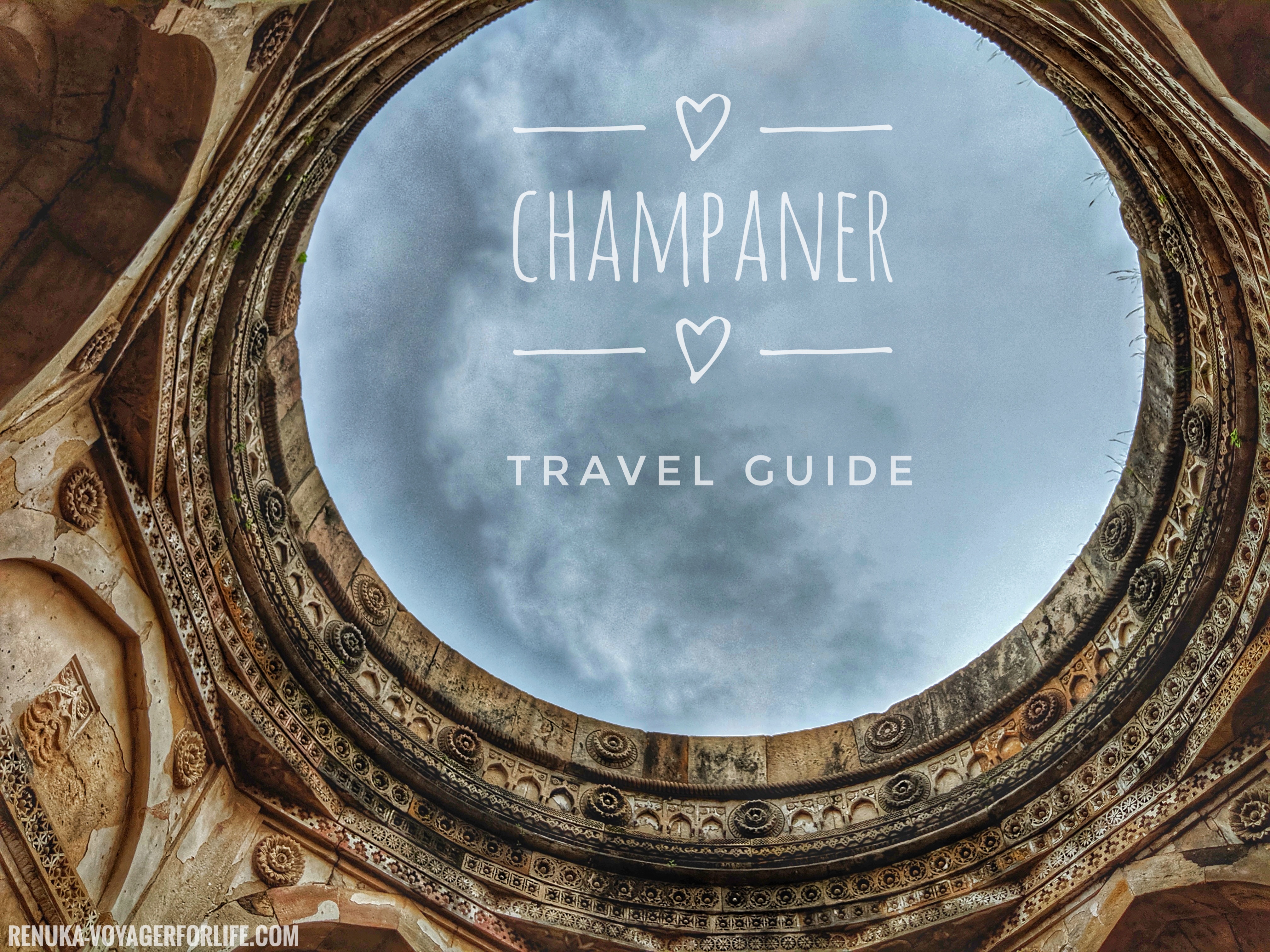
Champaner is awe-inspiringly historic. Also, Champaner-Pavagadh Archaeological Park is a World Heritage Site by UNESCO. A few interesting facts that you should know about Champaner are:
- Champaner’s original name was Muhammadpur, and it was the capital of the Sultanate of Gujarat for a short period of time.
- Champaner is as old as the 8th century.
- It was named Champaner by the king after the name of a general Champa aka Champaraj .
So yes, if you love history and architectural heritage, Champaner is a great find for you. But, that’s just one aspect of it. Champaner is not just a heritage destination. It’s also a place for nature and countryside enthusiasts like me. There’s so much of lushness and many rural charms to revere.
My Guide To Champaner – Things To Do & See
The Masjids on the Halol-Pavagadh Road
There’s something so fascinating about all the ancient mosques of Champaner. The first Masjid that you will come across on the Halol-Pavagadh Road is Ek Minar Ki Masjid , which, as the name suggests, is a mosque with just one pillar. It’s unique in its own way, and its beauty is enhanced by the backdrop of mountains.
Other masjids that I visited were Jami Masjid, Shaher ki Masjid, Kevada Masjid, Bawaman mosque and Kamani Masjid . There are so many mosques and temples that you might want to skip a few, which is fine. There was something different about visiting sites like Kamani Masjid and Kevada Masjid, as they were quite deserted and exuded a bit of eeriness. And, it was quite adventurous on my part to visit them alone. It gets a little difficult to reach these sites during the monsoons.
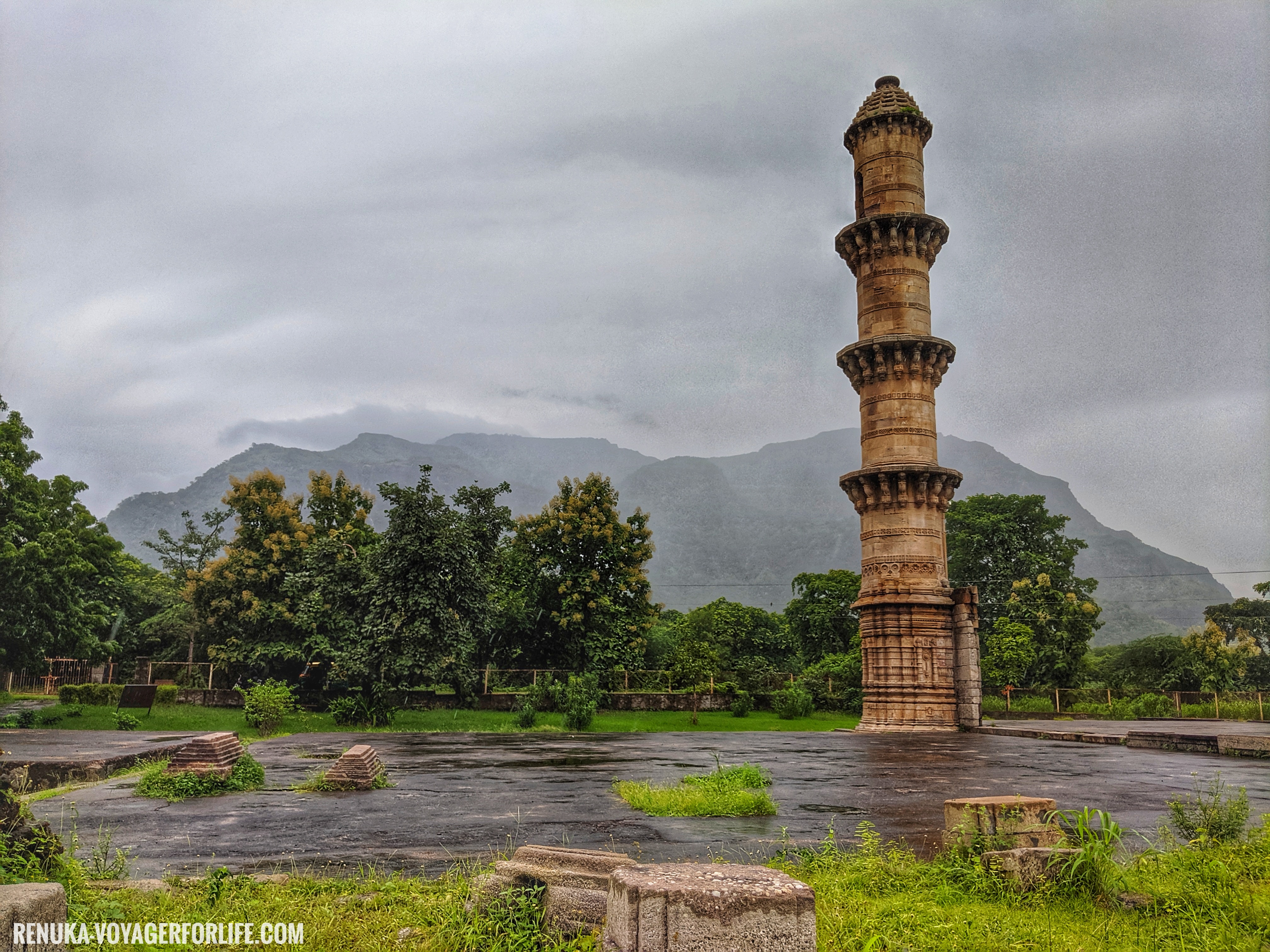
You need to pay just one entry fee of INR 40 to visit all the sites that come under Champaner-Pavagadh Archaeological Park. You are not allowed to take selfie sticks inside the premises of a mosque, so make sure you have someone to take your pictures.
There is no entry fee for sites like Ek Minar ki Masjid, Bawaman Mosque and Kamani Masjid.
Vadatalav Lake and Kabutar Khana Pavilion
After you have had your share of heritage sites of Champaner, head towards Vadatalav, which is a huge lake along with a hill view. There’s also an abandoned site called Kabutar Khana just across the road. It’s a place to just enjoy the surrounding views and the quietness. You will hear a lot of peacocks, but there’s a rare chance that you will see them.
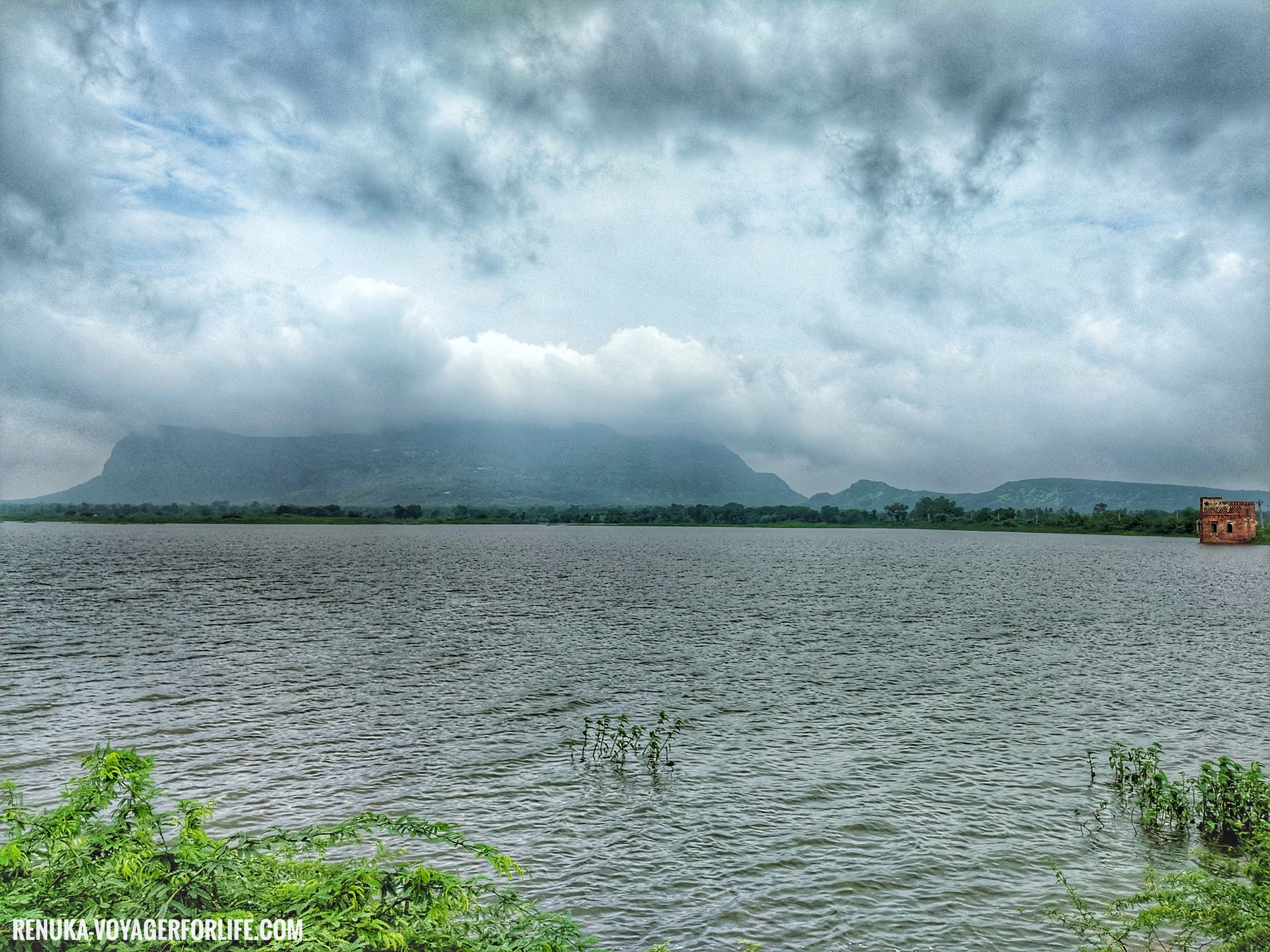
The settlement inside the fort walls
I find it really interesting to see people living inside the old fort walls. The Champaner-Pavagadh Archaeological Park is a huge settlement along with the ancient sites. It reminded me of Lakhpat – an abandoned world at the edge of Kutch . There are homes, shops, temples, schools and farms inside the heritage park. Walking inside the rundown fort walls is quite an experience, as it’s so full of wild vegetation. You do bump into the locals once in a while, but it’s mostly deserted and quiet.
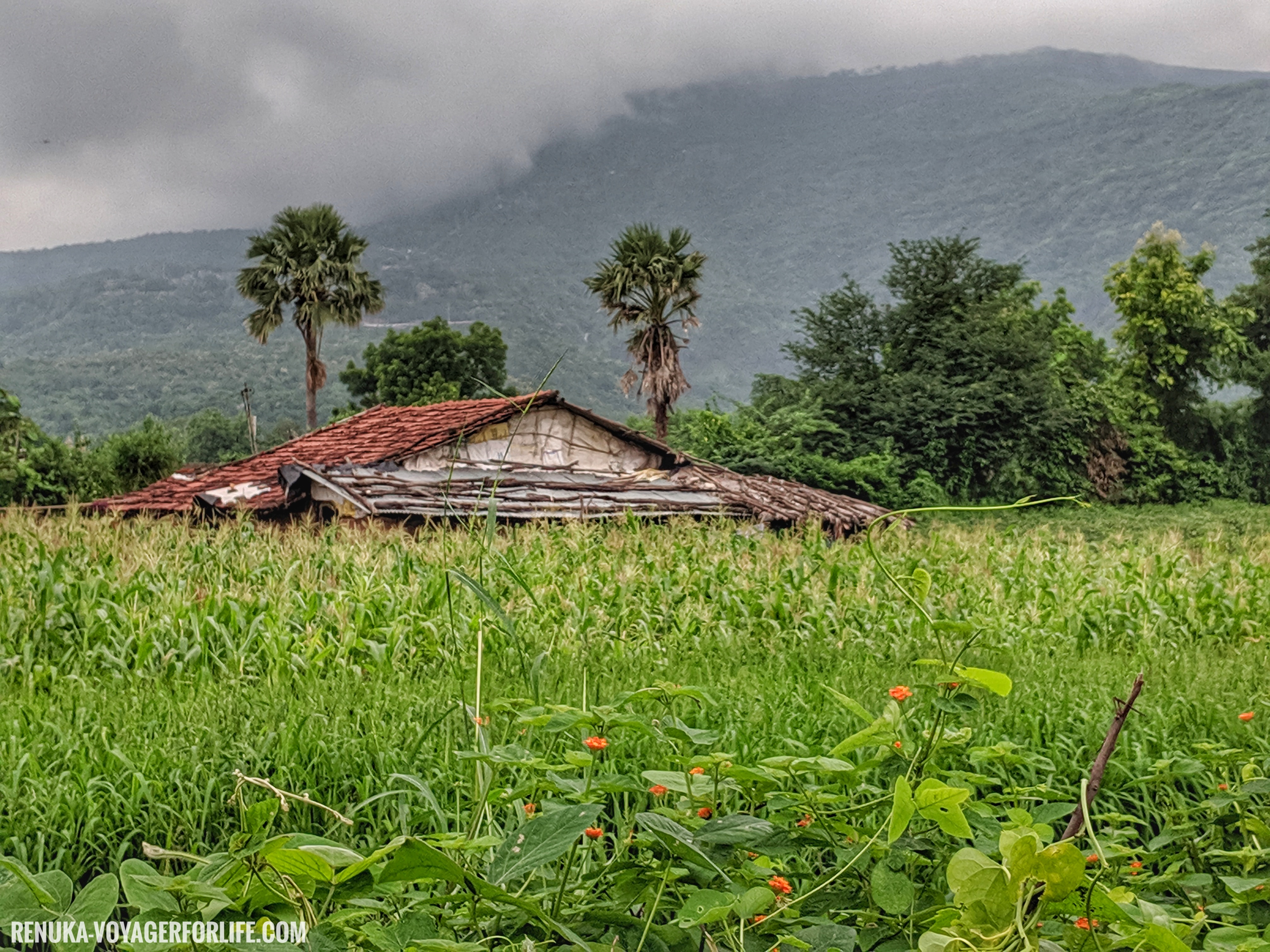
The city of Champaner – its vibe, the new-age cafes
While you explore the ancient treasures of Champaner, don’t forget to check out the new Champaner – the city life, the markets and the modern cafés of Champaner. Although there are not many modern eateries in Champaner, there are a few to please your appetite. I made repeated visits to Rooftop Café and Tea Post . I loved the vibe of these places. The food and the brew were good, too.
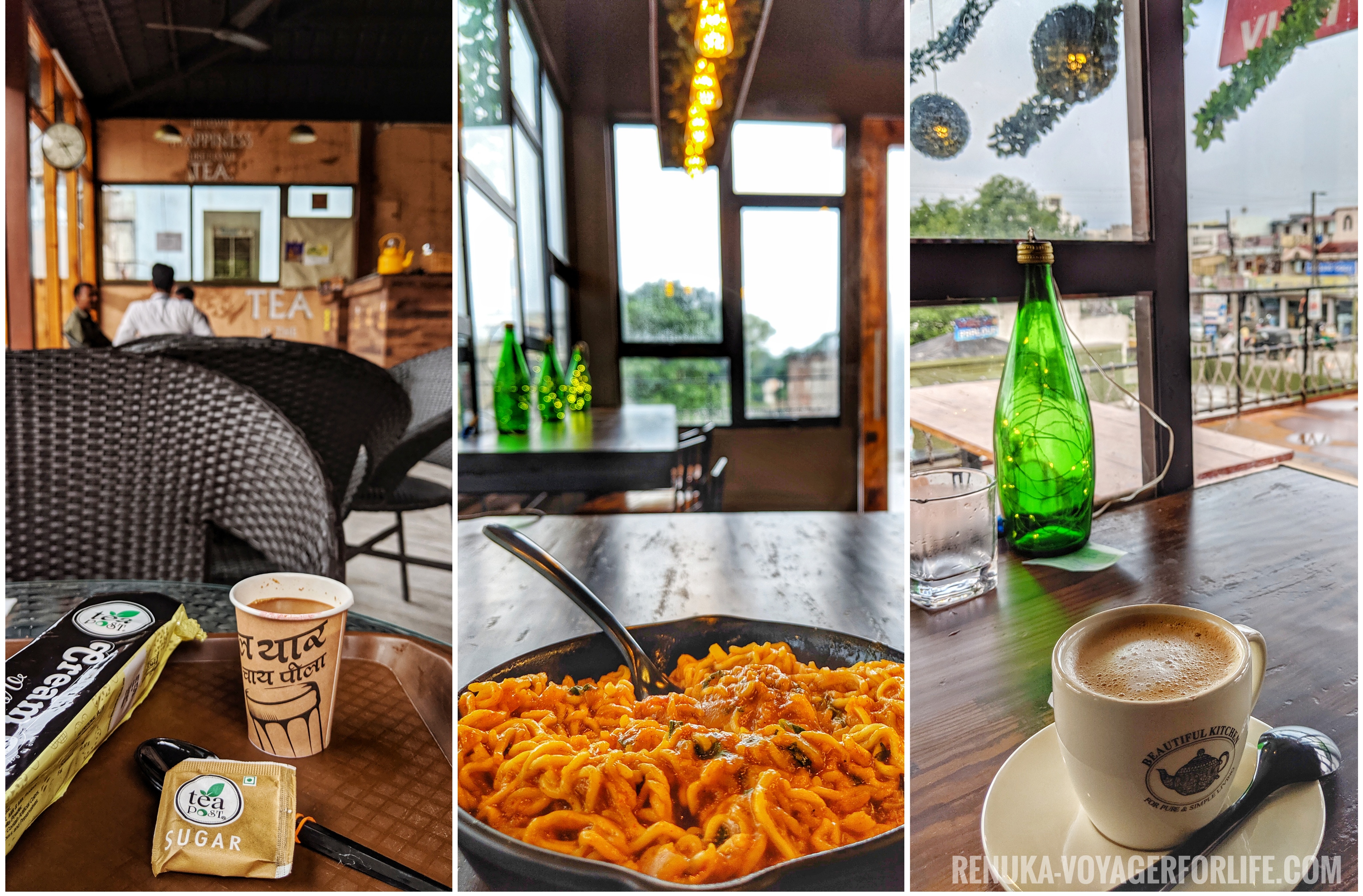
The Pavagadh Hill and the temple
Pavagadh Hill is an obvious highlight of Champaner. It’s also significant because of the temple on top of it, which is visited by many pilgrims. There are Govt. buses available to take you up to a certain point, after which you can trek or travel by ropeway to reach the peak.
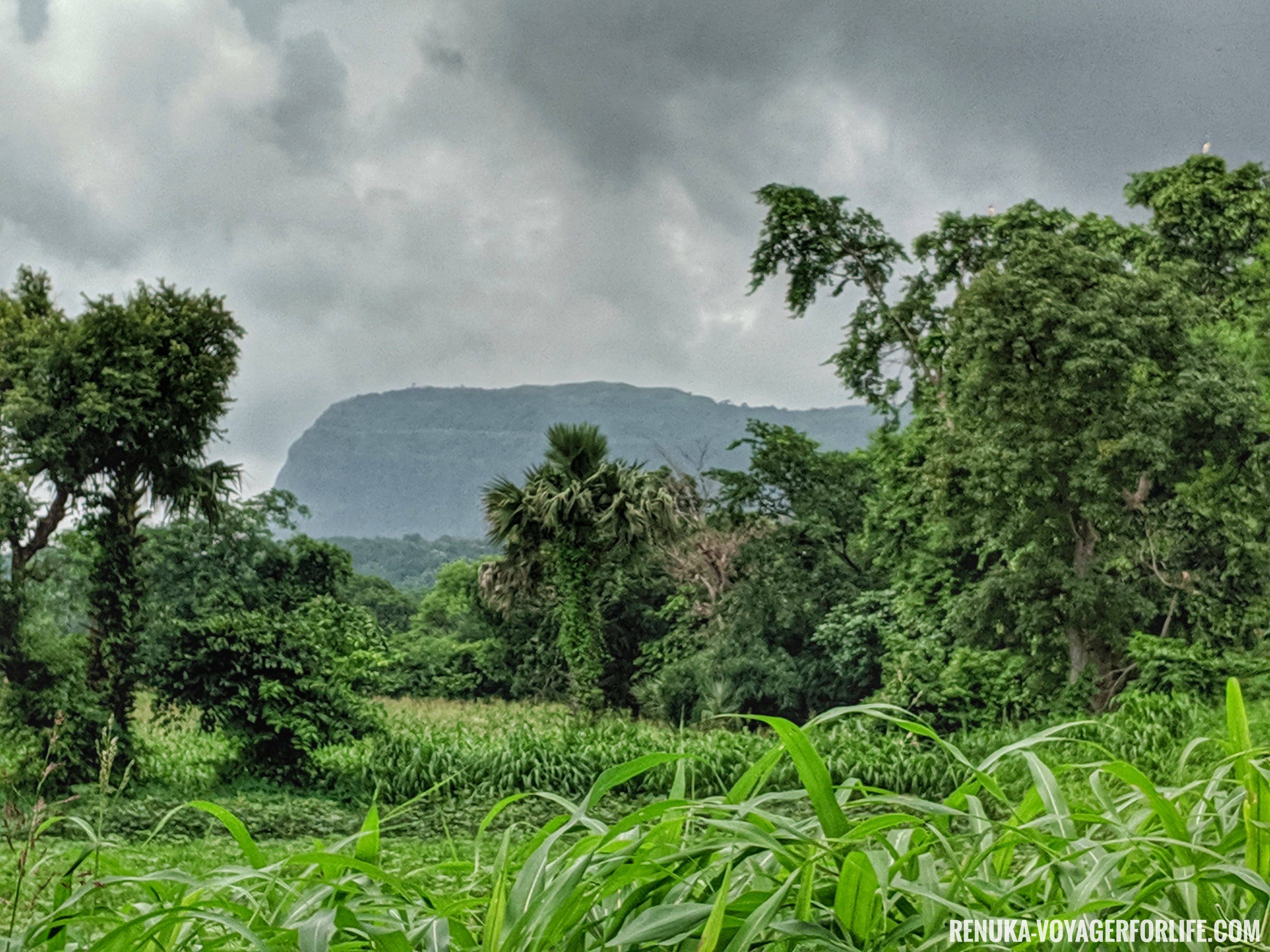
Hotels in Champaner
I stayed at OYO’s Hotel Balaji Inn, a modest guest house at Halol-Pavagadh Road. I got a really good deal of INR 1965 for 3 nights. I’d say it was a decent option in terms of budget and safety. All the historical sites were within 6-8 km from the hotel. Also, the city of Champaner, the markets and the restaurants were at close proximity.
I also stayed at Champaner Heritage Resort , which is in a charming village called Bhamaria, located almost 15 km from the main city.
I mostly commuted by autos – shared and private. It’s quite easy to find shared autos in Champaner, and they are very cheap. Also, it’s a good idea to take Chhakra rides, which is one of the best ways to take in the essence of rustic Gujarat.
How to reach Champaner?
There are two ways to reach Champaner – You can either take an overnight train from Mumbai. However, the Champaner railway station is quite deserted. There’s no public transport easily available for you to reach your hotel. You should ideally pre-book your cab with the hotel that you are staying at. Alternatively, you can reach Halol-Pavagadh Road via road (NH 48), which should take around 8 hours.
Disclaimer: This post has affiliate links. If you make a booking through these links, I will earn a small commission at no extra cost to you. Thank you for your support!
Is Champaner your kind of a place?
Enjoyed this post? Subscribe to receive ‘new posts’ straight in your inbox!
- Kale by LyraThemes.com.

5 (1 Rating)
The Mysteries of Champaner
By rahuldev rajguru, last updated: 07 jun 2023.
In the enchanting tapestry of Gujarat's landscapes, there exists a hidden jewel that has patiently awaited its moment in the spotlight. Amidst undulating hills and verdant valleys, a region of mesmerizing allure quietly beckons, veiled from the view of the general public. Astonishingly, even among Gujaratis, including myself, the captivating history woven into the fabric of this unassuming destination remains a well-guarded secret. Once a resplendent capital of Gujarat, this hidden gem radiated grandeur and significance, etching its name indelibly in the annals of Gujarat's storied past.
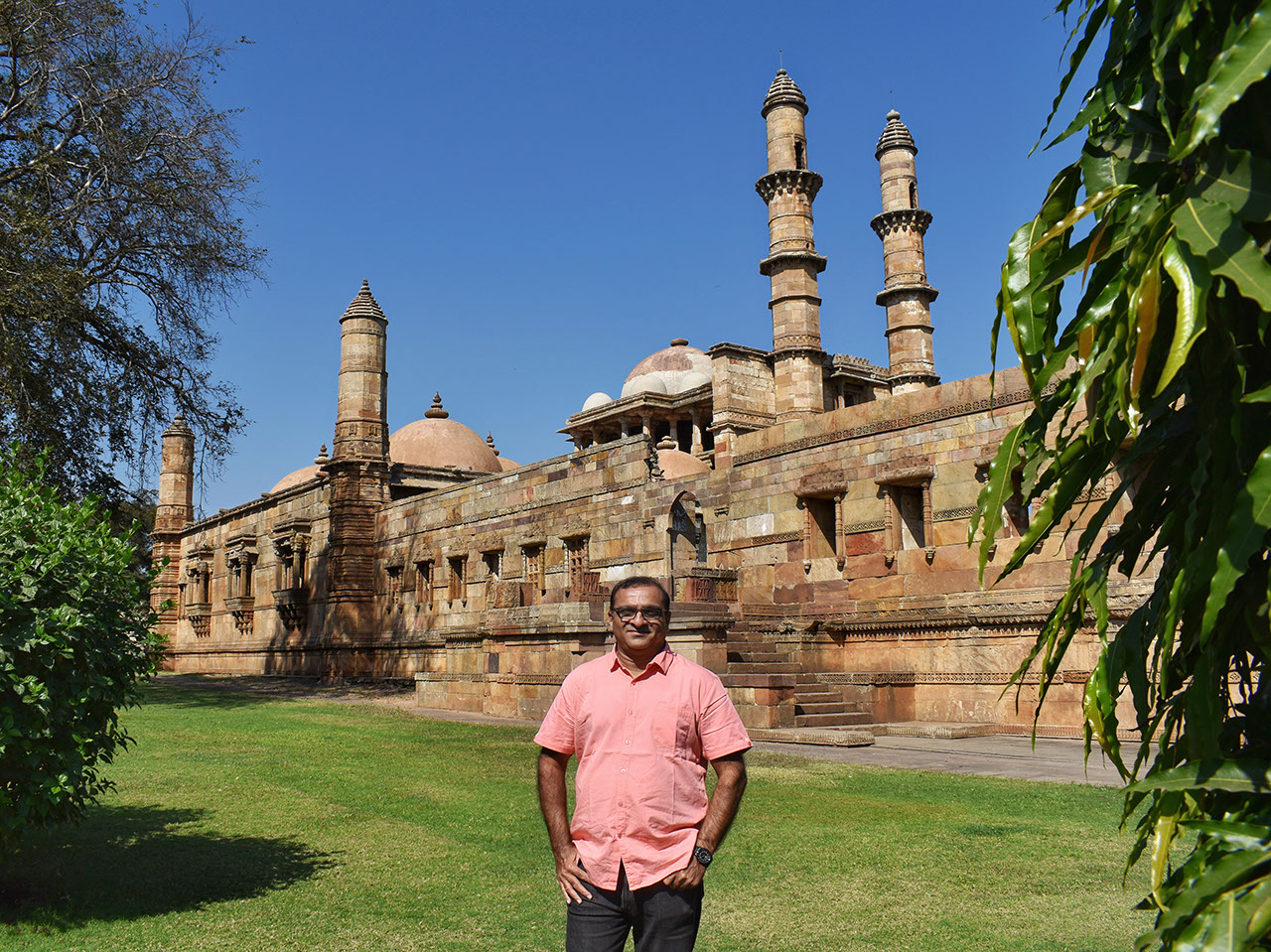
It's me posing in the gardens of the Champaner UNESCO World Heritage Site
An enchanting tale of Champaner's history
The name "Champaner" itself holds a fascinating history that traces back to ancient times. Legend has it that the town derived its name from a tribal chieftain known as Champa Bhil. He was a valiant warrior and a revered figure among the Bhil community, an indigenous group that inhabited the region. He was also a minister during the rule of Vanraj Chavda from the Anhilwad dynasty in the 8th century (746 - 806 CE). Another intriguing theory suggests that the name Champaner has its roots in the Sanskrit word "Champa," which refers to the fragrant Champa flower. Pavagadh hills surrounding Champaner consist of reddish-yellow stones which is one of the oldest rock formations in the country. The pigmentation of the rocks are often compared to "champa" flowers that resemble the flames of fire. The region is abundant with these exquisite flowers, known for their intoxicating scent and vibrant colors.
Between the 10th and 15th century, various dynasties, including the Solankis, Chauhans, Khichi Rajputs and Fateh Ravals, ruled over Champaner during this period. These dynasties held sway over the region and contributed to its cultural and architectural development. Hence, here you will find a touch of architecture that you could see in Modhera Sun Temple , Rani ni Vav (built by Solanki Chalukyas ) and Laxmi Vilas Palace in Vadodara . The Sultan of Ahmedabad, Nasiruddin Mahmud Shah conquered Pavagadh Fort in 1484. He also conquered Idariyo Gadh in Idar , one of the toughest fortresses in Gujarat . He was known as Mahmud Begada for conquering two 'Gadh', the toughest fortresses on the mountain. In Gujarati, "Begada'' refers to someone who has conquered two Gadhs.
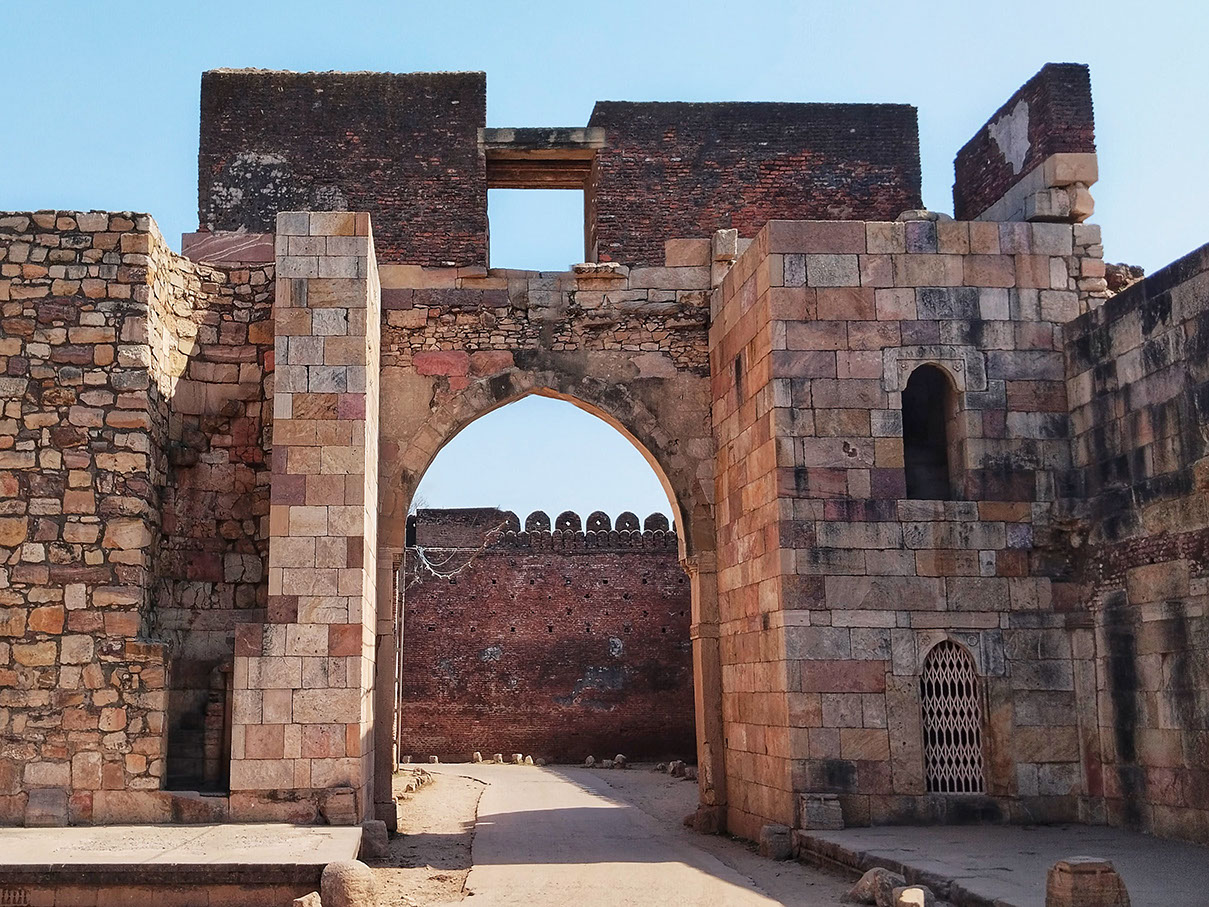
One of the resurrected gates of Pavagadh Fort in Champaner
Mahmud Begada established Champaner as the capital of Gujarat Sultanate and renamed it to "Muhammadabad" after himself. He had a vision to develop a city in Gujarat that is equivalent to the holy Mecca. Under his rule, Champaner flourished and experienced a golden age of prosperity, with the construction of magnificent structures and the blending of Islamic, Hindu and Jain architectural styles. A major economic force in Gujarat, Champaner had 52 bazaars (markets) where merchants from across the world traded. Champaner is believed to be the last surviving ancient city with islamic architecture that predates the mughal era.

During the 16th century, the Mughal Empire, under Emperor Humayun, sought to expand its territories and influence in India. Humayun, in his campaign against Gujarat, besieged Champaner in 1535 and looted the coffers. Champaner gradually declined in significance and fell into a state of neglect. The once grand structures began to crumble, and the town lost its prominence.
The Marathas later ruled Champaner, as did the British for a short time, but it could never regain its ancient glory. British colonial officers during the 19th century discovered the ruins of Champaner which subsequently led to the excavation. Excavation efforts were led by a prominent British archaeologist, James Burgess. Under his guidance, systematic excavations began, unearthing the hidden treasures and structures buried beneath layers of time and neglect. The efforts extended over several decades. Today, the Champaner-Pavagadh Archaeological Park showcases the fruits of these excavations, allowing visitors to wander through the ancient ruins and marvel at the remnants of the town's former splendor. As a result, UNESCO in 2004 declared Champaner-Pavagadh Archaeological Park a World Heritage Site, recognizing its exceptional cultural and historical value.
The forgotten world of whispers and antiquity
Stepping foot into the realm of Champaner was like crossing the threshold into a forgotten world. The air was heavy with the whispers of antiquity, and my eyes were immediately drawn to a magnificent tapestry of ancient fortifications that stretched as far as the eye could see. Their weathered surfaces revealed the passage of time, adorned with tales etched in every crack and crevice.
The towering bastions, once guardians of Champaner's glory, now stood as silent witnesses to the passage of empires. Amongst the ruins and remnants, a few brave fragments had withstood the test of time. A resurrected entry gate stood defiantly beckoning me to step closer and immerse myself in the ancient tale it held.
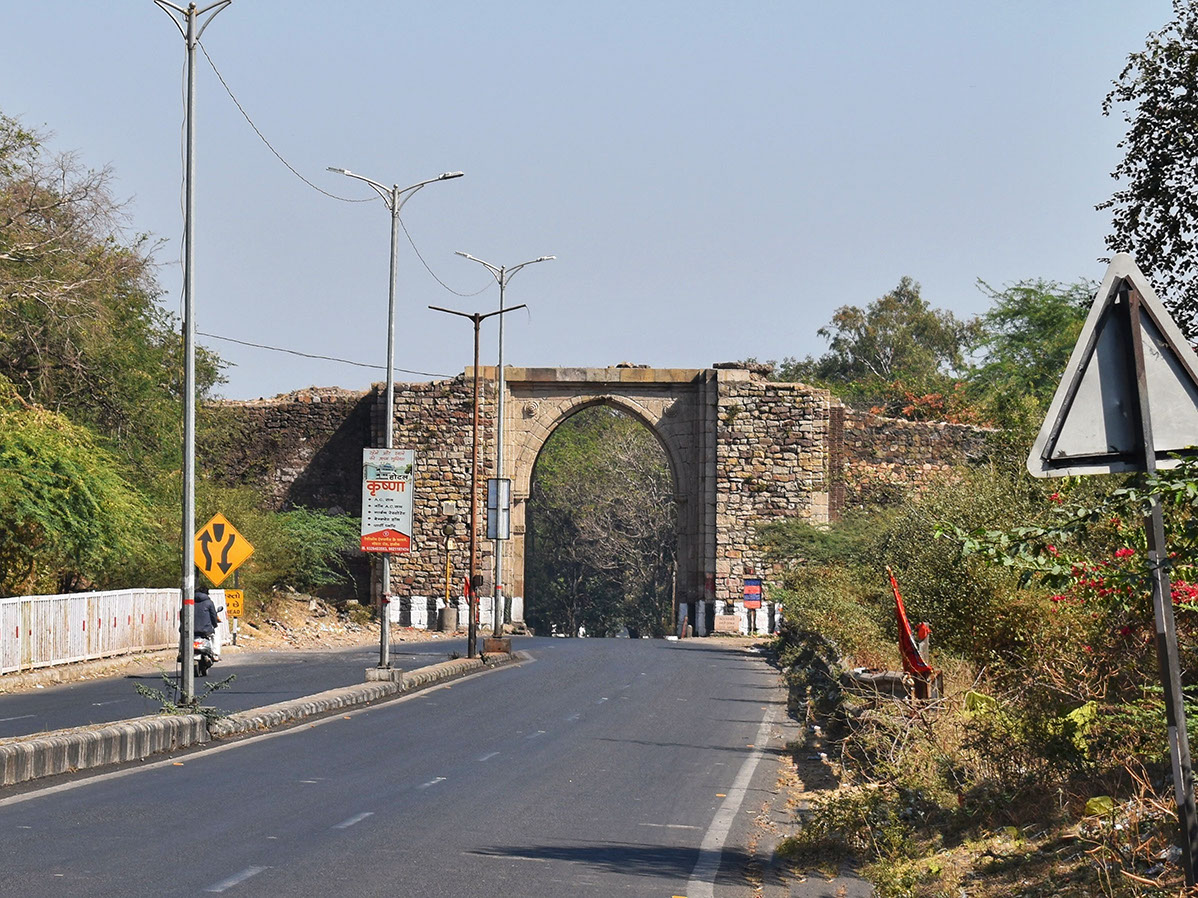
The gate to Champaner's ancient fort lies in ruins
Passing through the gate, I felt as if I had been transported back in time to the heyday of Champaner, when its walls were bustling with life and its fortifications standing tall.
Saher-ki-Masjid: A fusion of serenity and architectural splendor
As soon as you cross the first gate in Champaner's old city and enter the zig-zag streets, you reach Saher-ki-Masjid. Here you can purchase tickets for various monuments and start your heritage walk to Champaner.
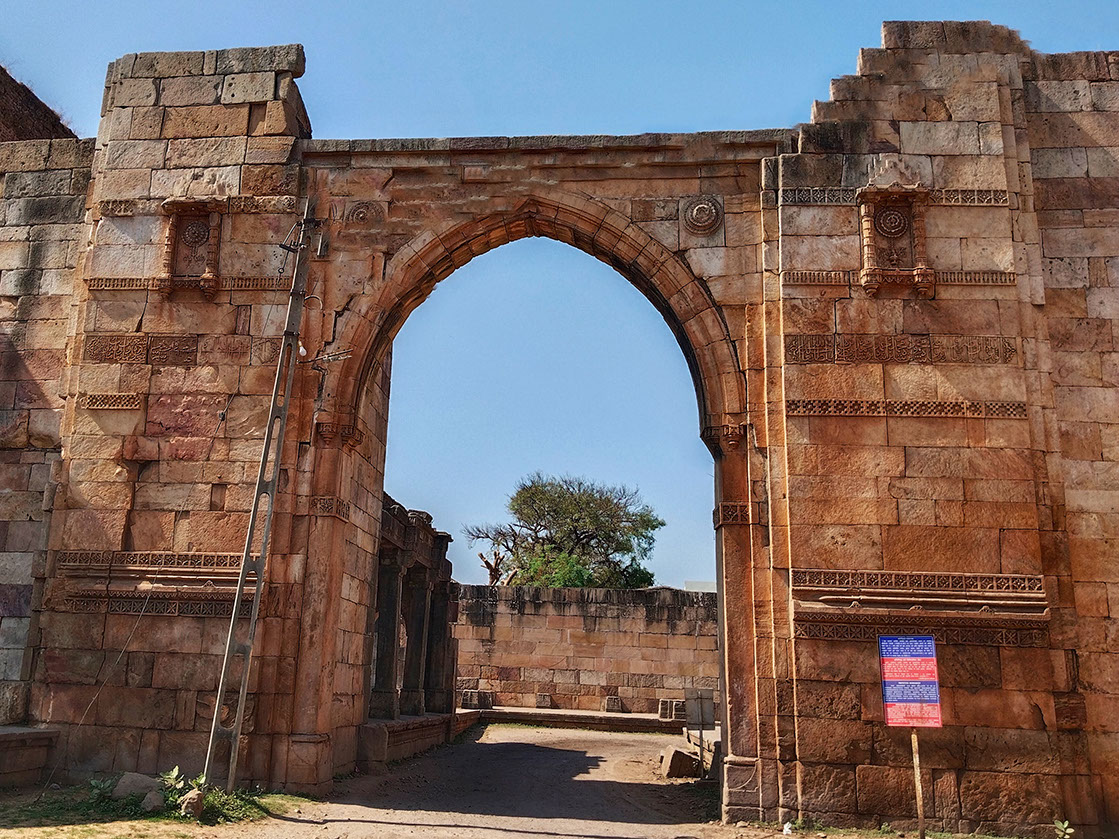
Gate leading to Saher-ki-masjid
After arriving here, I inquired about a guide at the ticket window. It surprised me that I was the only visitor. There are not many guides in Champaner. They called a guide and he arrived within 30 minutes from Halol. I usually refrain from hiring a guide at Gujarat's heritage sites since most of them have shallow knowledge and are always in a hurry. In contrast, when I visit a heritage site in Karnataka , Tamil Nadu , or Andhra Pradesh , I always hire a guide. Tourism in Gujarat is relatively new and people are only beginning to visit the state in recent years. Therefore, the culture of hiring a guide and getting deep into a subject matter has not yet developed. Since the majority of the guides have been given a crash course by the government, their interest level is quite low.
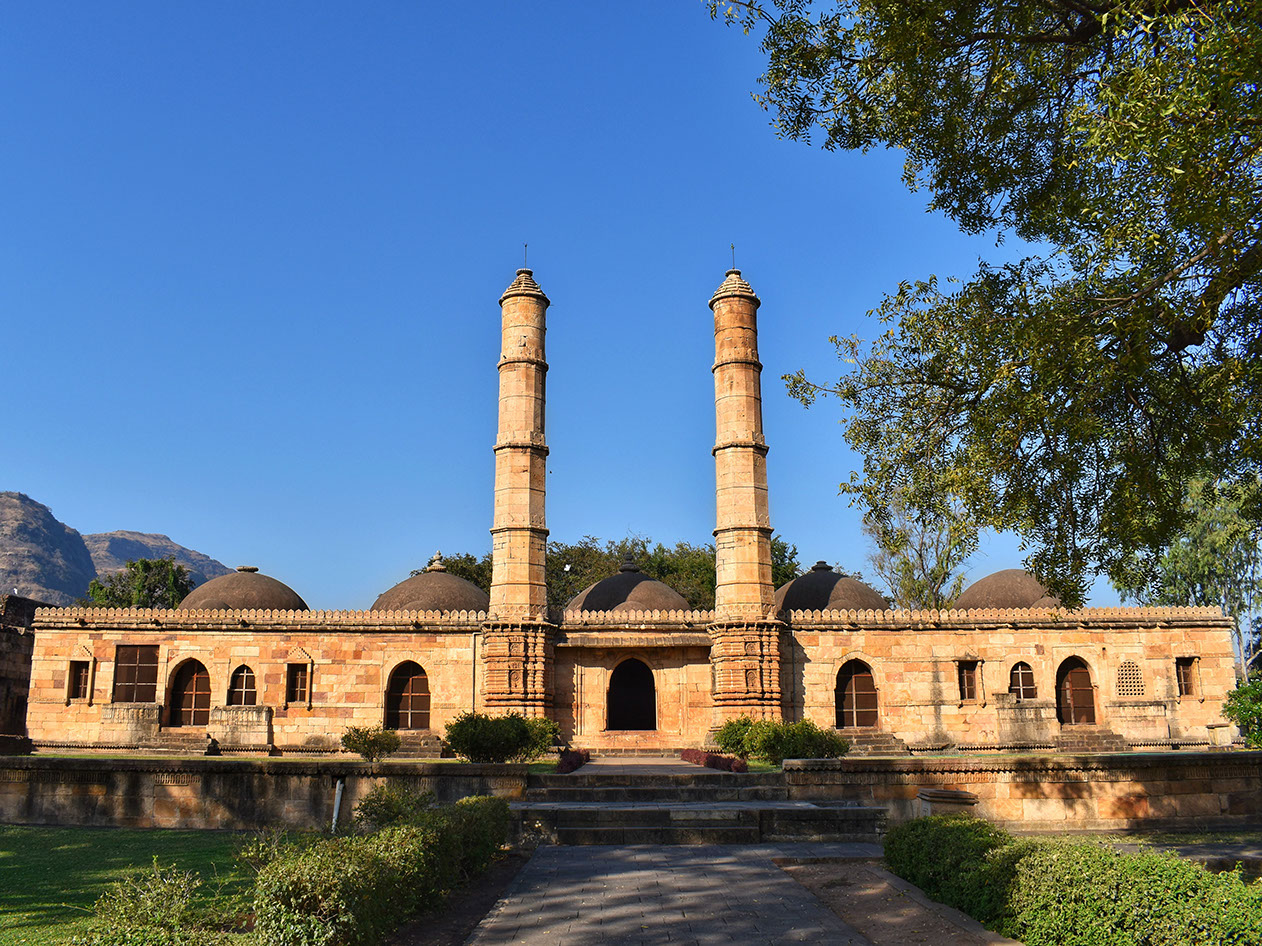
A front view of Saher-ki-Masjid
Since this was an impromptu visit, I did not have time to study Champaner beforehand. As a result, I was left with no choice but to hire a guide. Despite paying INR 1,500 for a 5-hour guided tour to Champaner, I was utterly dissatisfied with the quality of the tour. After the guide ended the tour, I was able to obtain much more accurate information and data from the locals and security personnel. I have tried my best to describe this mesmerizing place to the best of my understanding and research in order to save you the hassle of hiring a guide.
Saher-ki-Masjid (Mosque of the City) was a private mosque built only for the royal families and nobles of the Gujarat Sultanate. The first glance at the architecture of this mosque reminded me of my visit to Jama Masjid in the walled city of Ahmedabad , another UNESCO World Heritage Site in Gujarat. It stands as a testament to the fusion of Islamic and Hindu architectural styles.
Approaching the mosque, one is immediately struck by its imposing facade, adorned with intricate carvings and delicate latticework. The craftsmanship is breathtaking, showcasing the skill and artistry of the artisans of yore. As you step inside, a sense of tranquility washes over you, as if the walls themselves exude a serene aura.
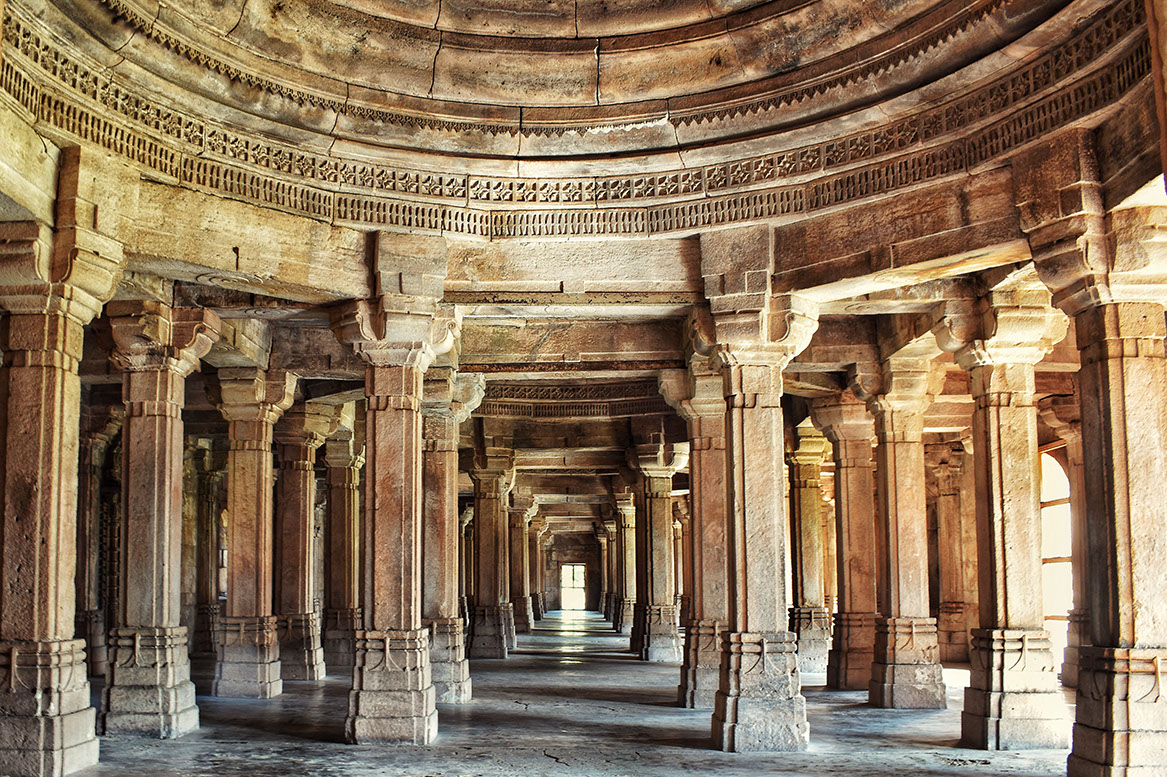
The prayer hall exhibits the elegance of ancient architecture through its symmetrical design
The mosque stands on an elevated platform, spanning 56x40 meters, boasting a grand prayer hall and five mihrabs. A magnificent central arched entrance, adorned with intricately carved minarets, grants access to the prayer hall. Uncommonly, there are also two arched entrances flanked by jharokhas on either side, exclusively designated for the women of royal families. Proceeding through any entrance leads to the center row, where a domed structure gracefully looms overhead.
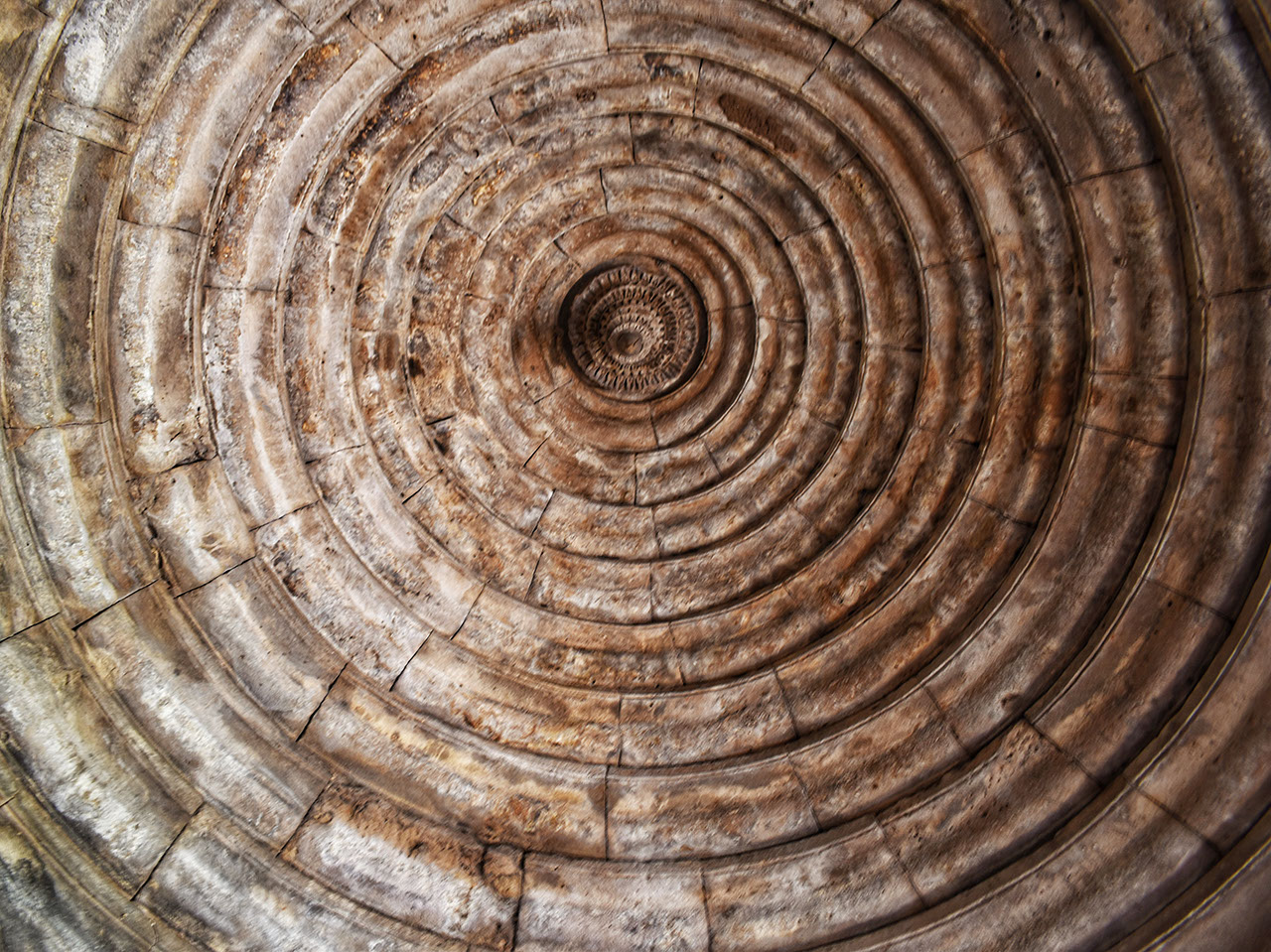
An interior perspective of the mosque's cupola (a dome with circular canals that provide ventilation)
The interior of Saher-ki-Masjid is a symphony of geometric patterns, calligraphy, and arches that stretch towards the heavens. The prayer hall is a spacious sanctuary, where light filters through the pierced stone screens, creating an ethereal atmosphere. The mihrab, or prayer niche, commands attention with its intricate detailing and elegant design.
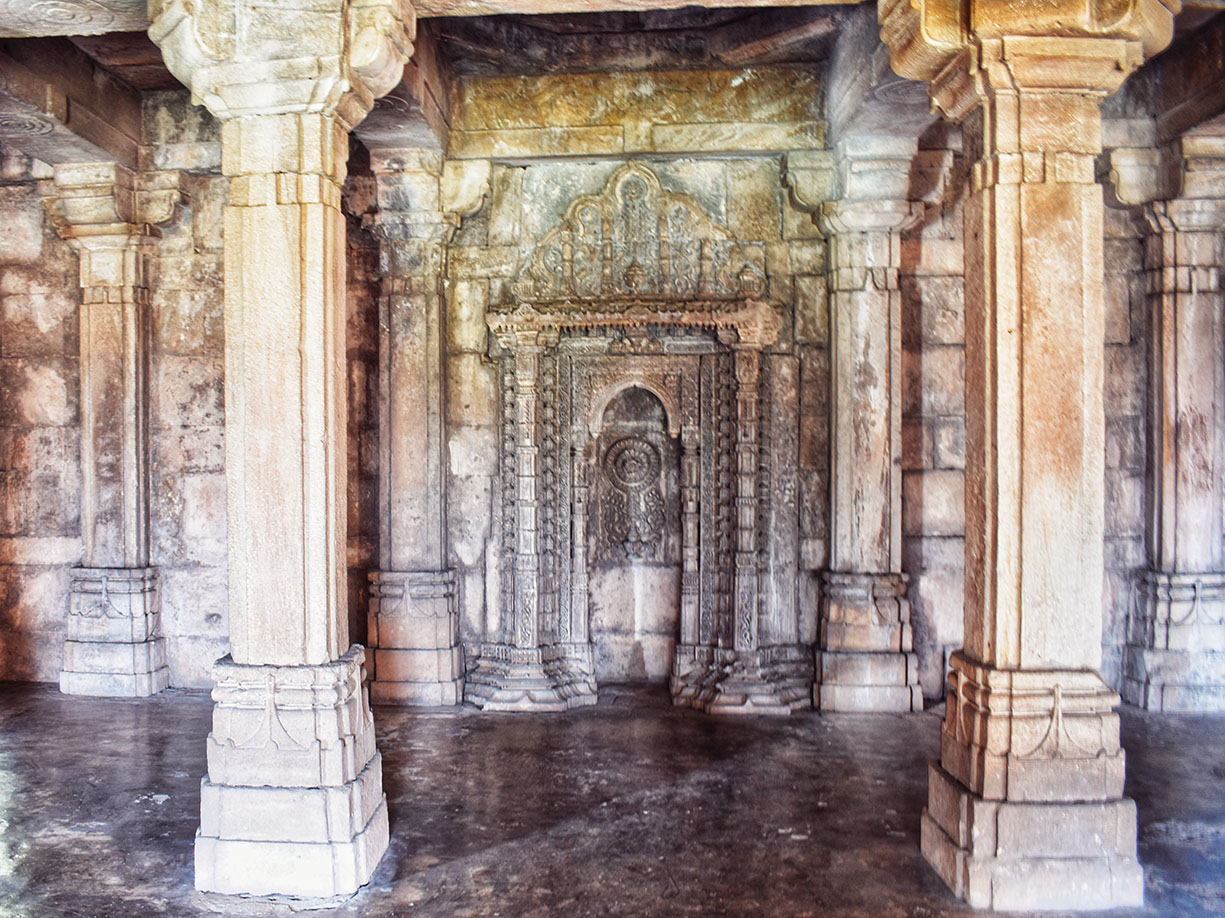
The central Mihrab indicates the direction to Mecca
The majestic Jami Masjid
Our next destination was the architecture masterpiece of the 15th century, Jami Masjid. You need to preserve your ticket as without that you won't be allowed to enter the mosque. As we approached Jami Masjid, I was immediately struck by its grandeur.
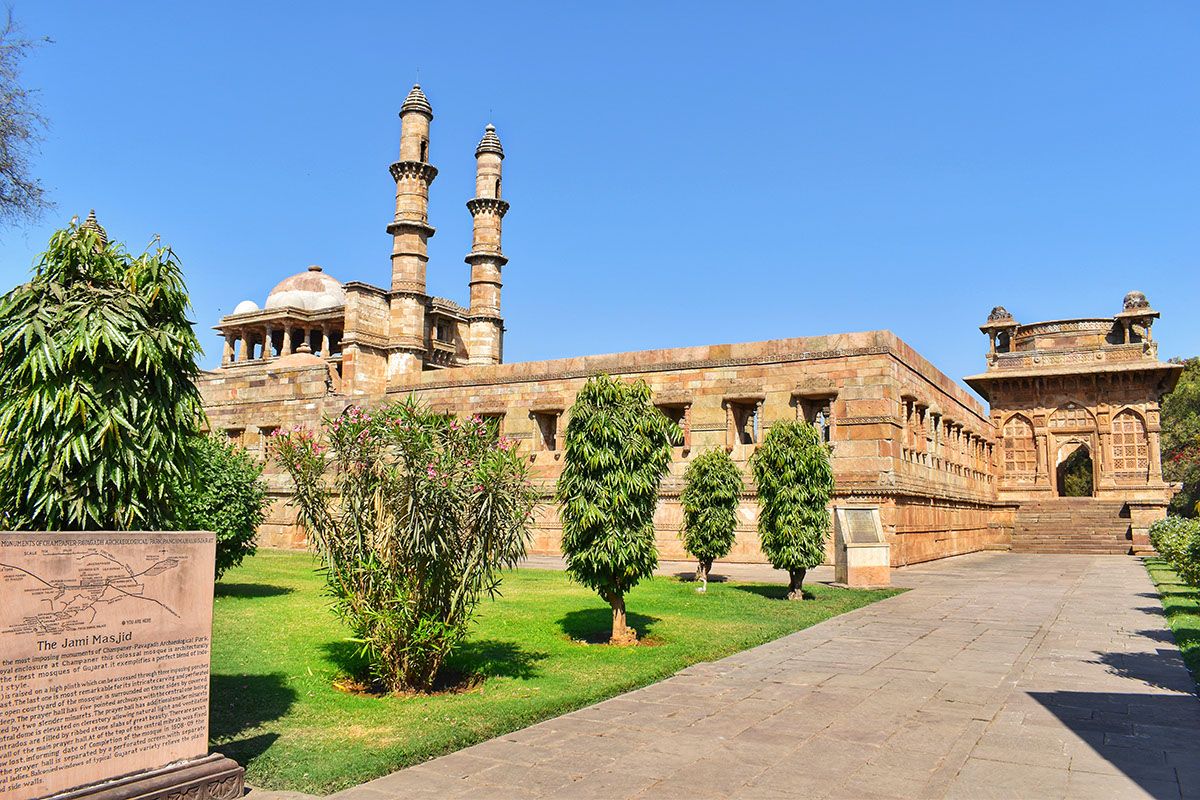
Taking in the grandeur of Jami Masjid as seen from the main entrance to the mosque
The construction of the Jami Masjid spanned over two decades, showcasing the meticulous craftsmanship and attention to detail that went into its creation. It started in 1484 and was completed in 1509 taking 25 years to build a sprawling complex.
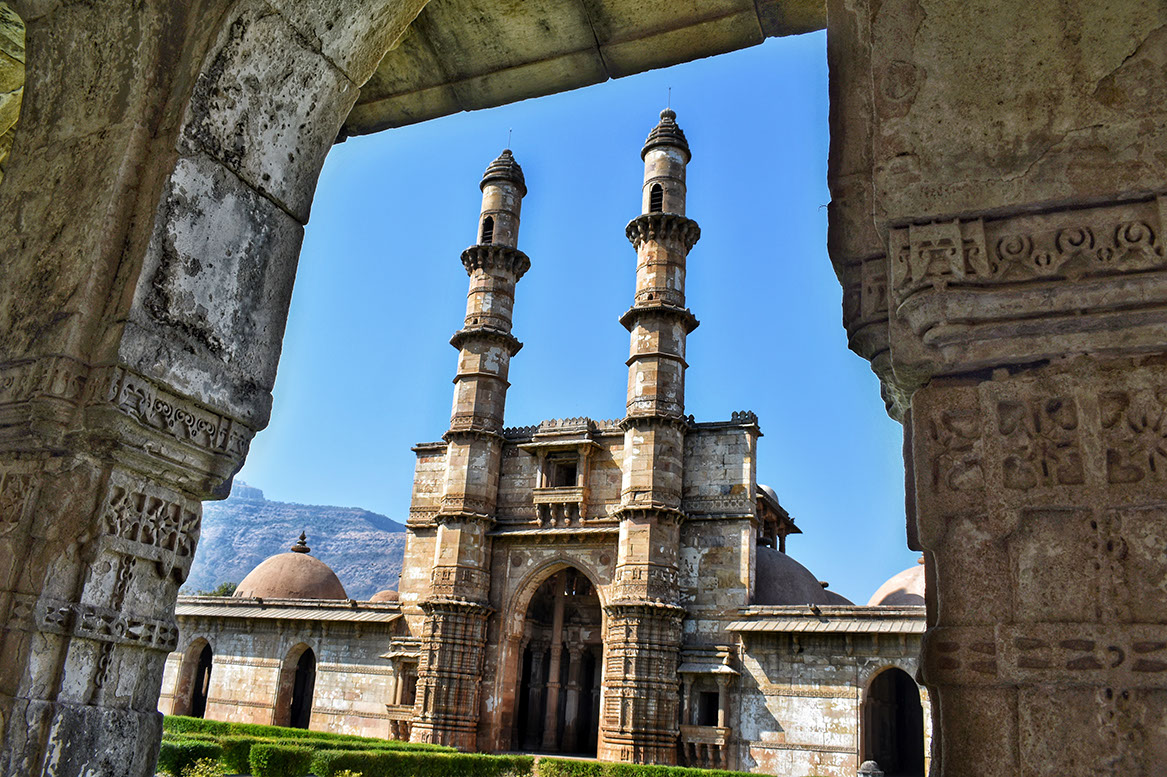
Observing the tall minarets from the corridor outside
What truly sets the Jami Masjid apart is its architectural fusion, seamlessly blending Islamic, Hindu, and Jain influences. The mosque's grand structure boasts a unique amalgamation of styles, with elements such as intricate carvings, ornate domes, and exquisite pillars that bear witness to the cultural diversity that thrived in Champaner. The architecture of Champaner is thought to have influenced Mughal architecture in India in the subsequent centuries.
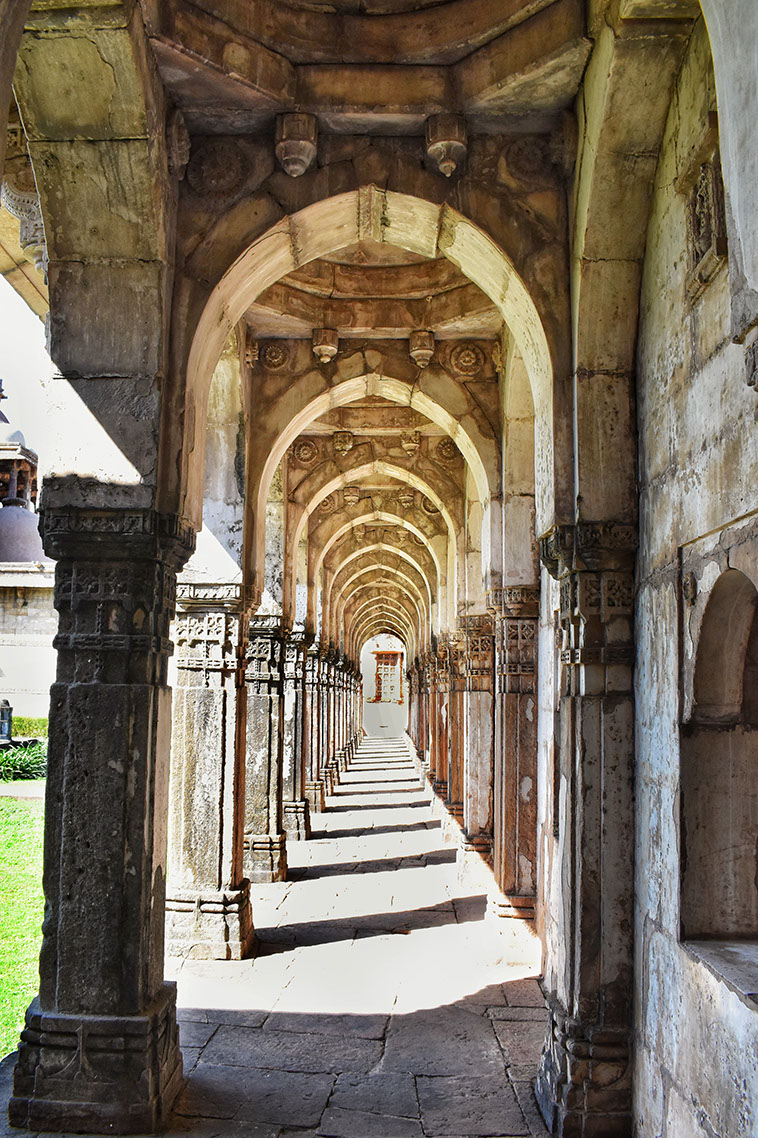
A tranquil corridor surrounds the courtyard
Approaching the mosque, one is greeted by multiple entrances, each exquisitely designed and adorned with intricate details. These entrances serve as portals, inviting visitors to immerse themselves in the splendor within. It is advisable to start your visit to Jami Masjid from Sopan Marg which is also known as the "Shahi Entrance" (Shahi means grand). There are three entrances to the mosque facing north, south and east. Sopan Marg is the east facing entrance and was meant for the common people to enter the mosque. Sopan Marg in Sanskrit means a flight of stairs to heaven. This is the most intricately carved entrance with perforated screens (known as jhalis). The adjacent walls have carvings of Asopalav at the plinth level which is known as Ashoka Toran in Hinduism.
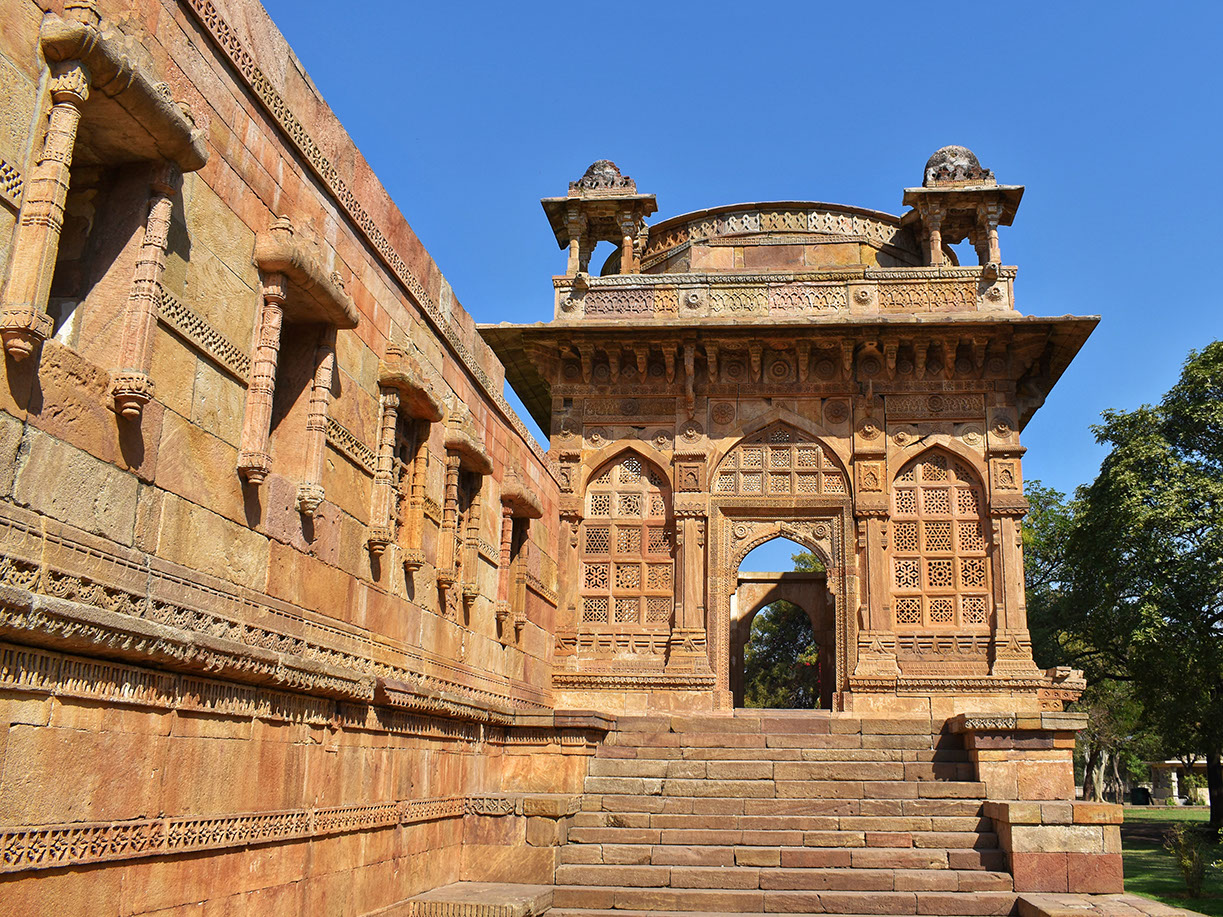
On the way to Sopan Marg - the mosque's east side entrance
Envision a world where the outer allure of the portico captivates your senses, enticing you to explore what lies within. As you venture along the enchanting Sopan Marg, your anticipation builds until you finally arrive at the majestic podium. Stepping through the threshold, I was instantly spellbound by the breathtaking interior of the portico. My mind was swept away as I beheld a mesmerizing symphony of intricate carvings adorning each facade. What made this sight even more extraordinary was the sheer uniqueness of the designs, with not a single repetition among the mesmerizing jhalis.
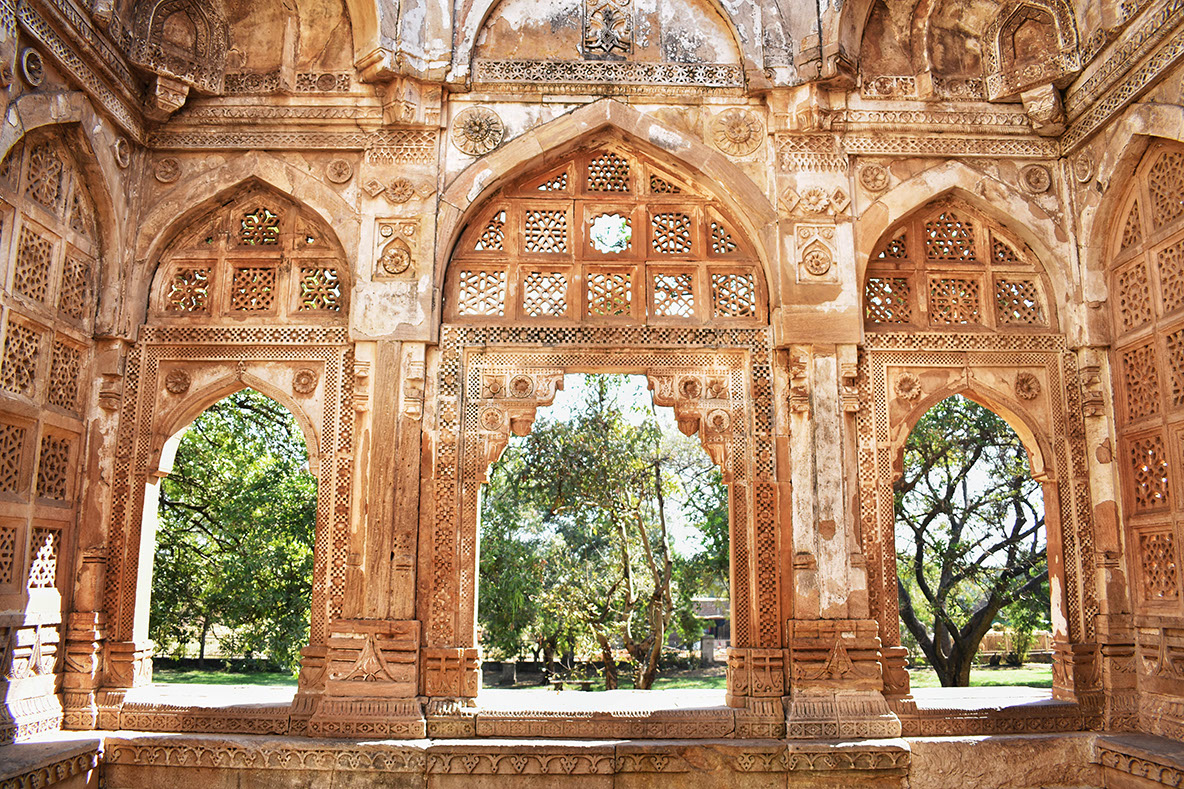
Unique designs of jhali decorate each facade of the portico
Amidst this architectural wonder, a large dome graced the portico, bearing the marks of time's passage. Damaged during the 2001 earthquake, it now embraced a celestial perspective, offering a tantalizing glimpse of the heavens through its open ceiling, as if inviting you to connect with the vastness above.
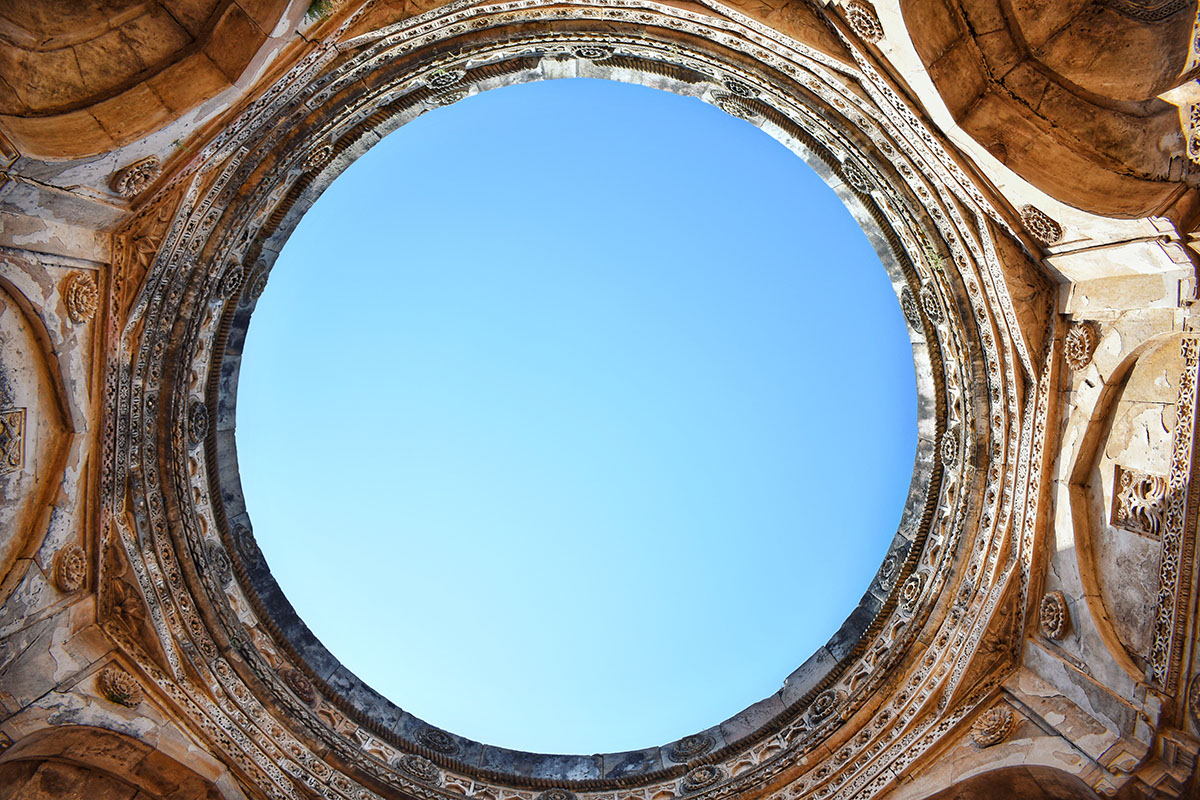
The damaged dome has left the roof of the portico open
Within the confines of the portico, I found myself immersed in a time-warp, where the minutes stretched like a suspended melody, carrying me 500 years into the past. Reluctantly, the guide's reminder broke the enchantment, beckoning us to continue towards the heart of the mosque. As I turned to the left, my gaze was instantly captivated by the sight of two colossal minarets soaring an impressive 30 meters into the heavens. Adorned with meticulously crafted designs and intricate motifs, the minarets stood as the crowning jewels of the architectural symphony, bestowing upon the entire composition a regal and awe-inspiring grandeur.
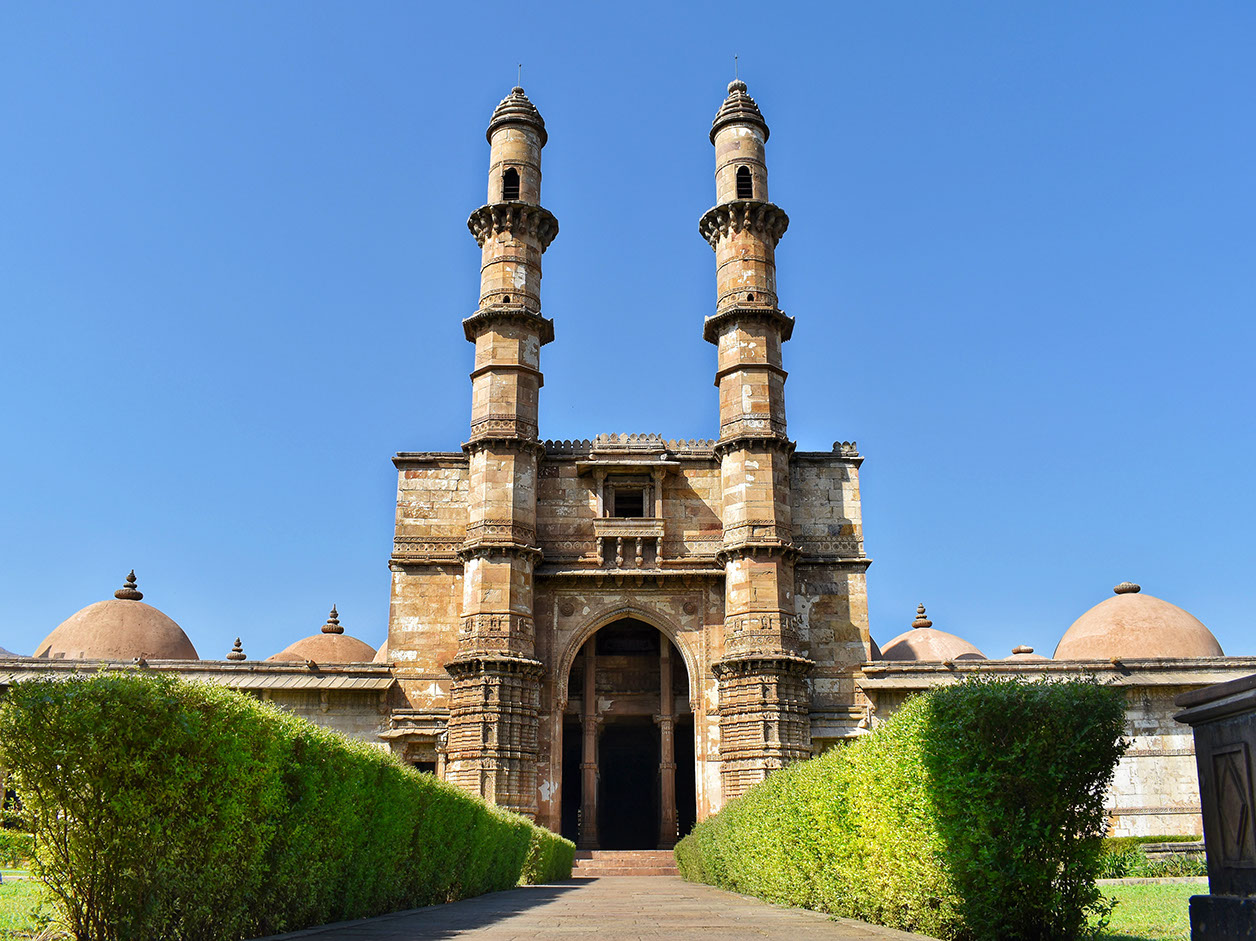
Typical Gujarat-style architecture with an oriel window flanked by two octagonal minarets
According to my guide, the mosque features a remarkable ensemble of 11 domes, with five on each side and a prominent central dome. Interestingly, these domes showcase motifs commonly associated with Hindu temples, such as pots and lotus insignia. What's even more intriguing is that the mosque's design was a collaborative effort, with contributions from architects representing Islam, Hinduism, and Jainism. There is a striking resemblance between the intricate carvings here and those found in the renowned Ranakpur Jain Temple. Additionally, the mosque's symmetrical architecture ensures a consistent and captivating view from any angle, revealing the stunning interior in all its glory.
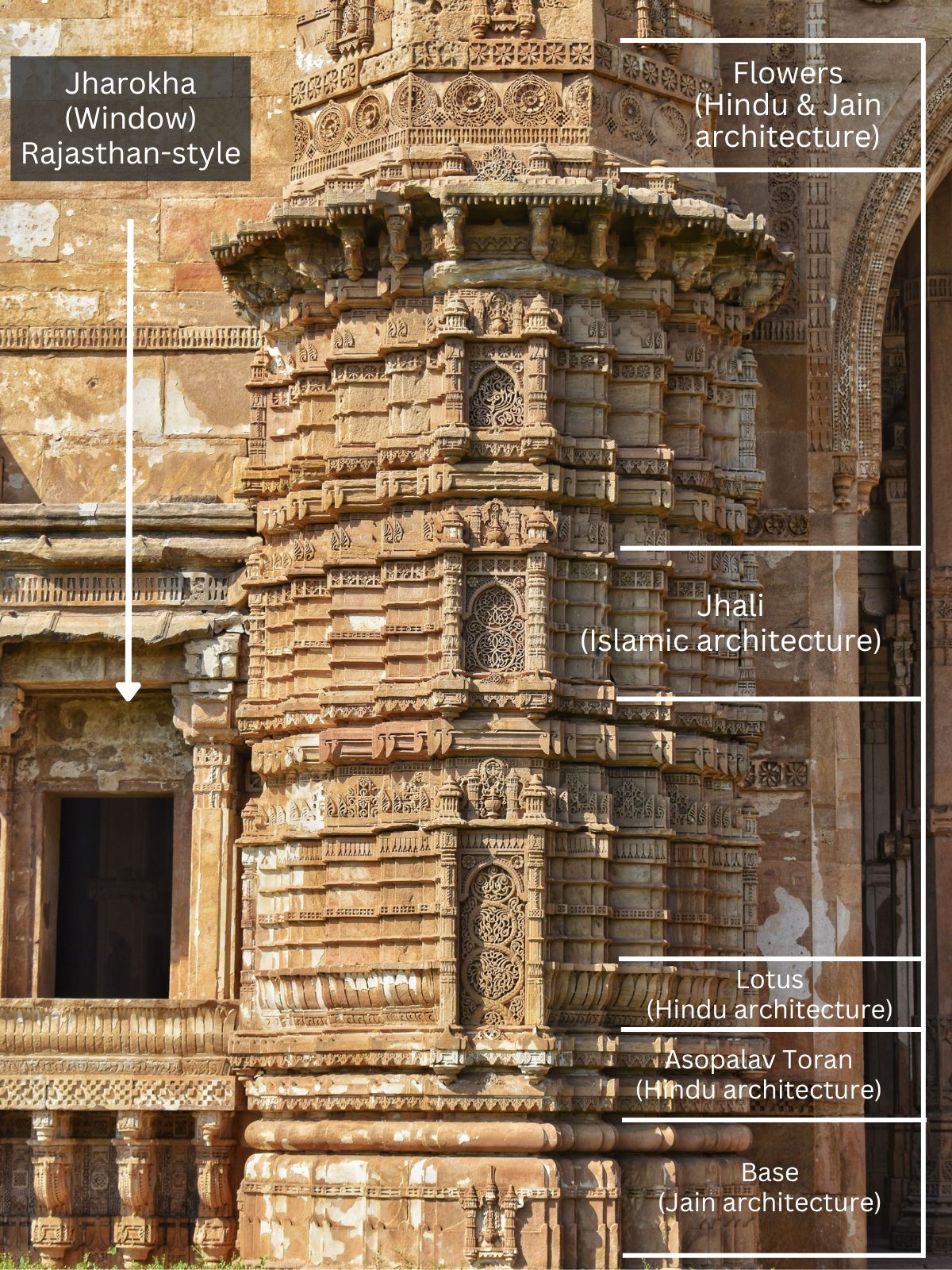
An intricate carving and unique jhali design at the base of the minaret combine various architectural styles
The mosque is crafted from sandstones meticulously interlocked together, without the need for cement or other bonding materials. Inside, the prayer hall is supported by an impressive array of 242 pillars. An interesting feature is the octagonal garbhagriha beneath the main dome, reminiscent of Hindu temples. The central dome, standing tall on its two-story structure, is elevated on the clerestory, welcoming ample natural light and ventilation. A sight to behold, the dome's inner beauty is enhanced by ribbed stone slabs, casting an enchanting allure when observed from below.
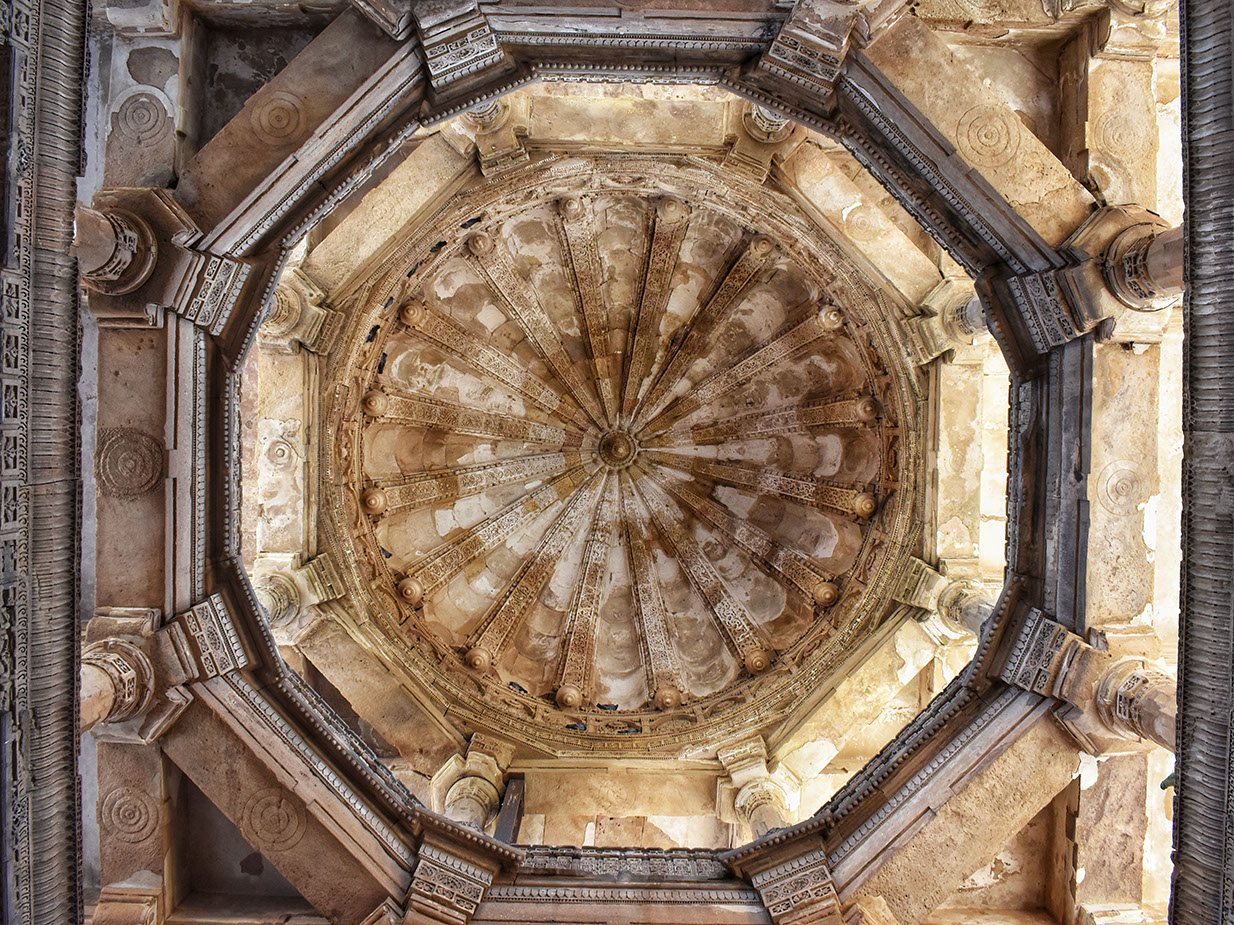
Mosque's beautiful two-storey central dome provides ventilation
As we progress towards the marble mihrab from the main prayer hall, we may unintentionally miss a breathtaking sight above us - a remarkable Kalpavriksha adorning the ceiling. In Jainism, the Kalpavriksha is a wish-granting tree, capable of fulfilling desires. It is believed that standing beneath this sacred tree in the mosque and making a wish ensures its manifestation. The carvings within the Kalpavriksha take the form of the "OM" symbol, symbolizing unity that holds deep significance in Hinduism and various other religions.
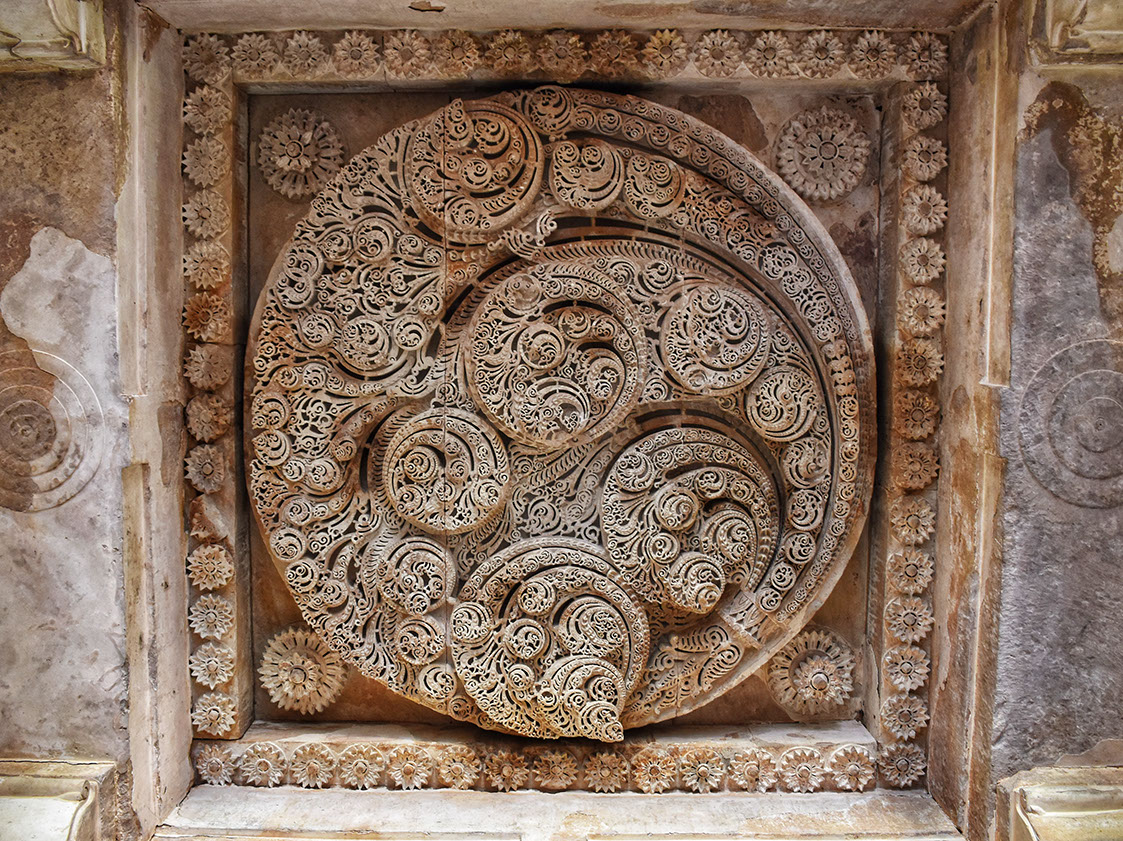
On the ceiling are fractal carvings in the shape of a Kalpavrishka
As you approach the far end wall, a captivating motif captures your attention. It is one of the mosque's seven mihrabs, distinguished by its exquisite marble construction. This design beautifully blends elements of Indo-Islamic architecture. Adorning the top near the ceiling is a toran (insignia), embellished with intricate depictions of elephants, flowers, bells, and pots - a familiar sight in Hindu temples. Notably, this mihrab stands apart as the sole marble creation, while the remaining ones boast sandstone craftsmanship.
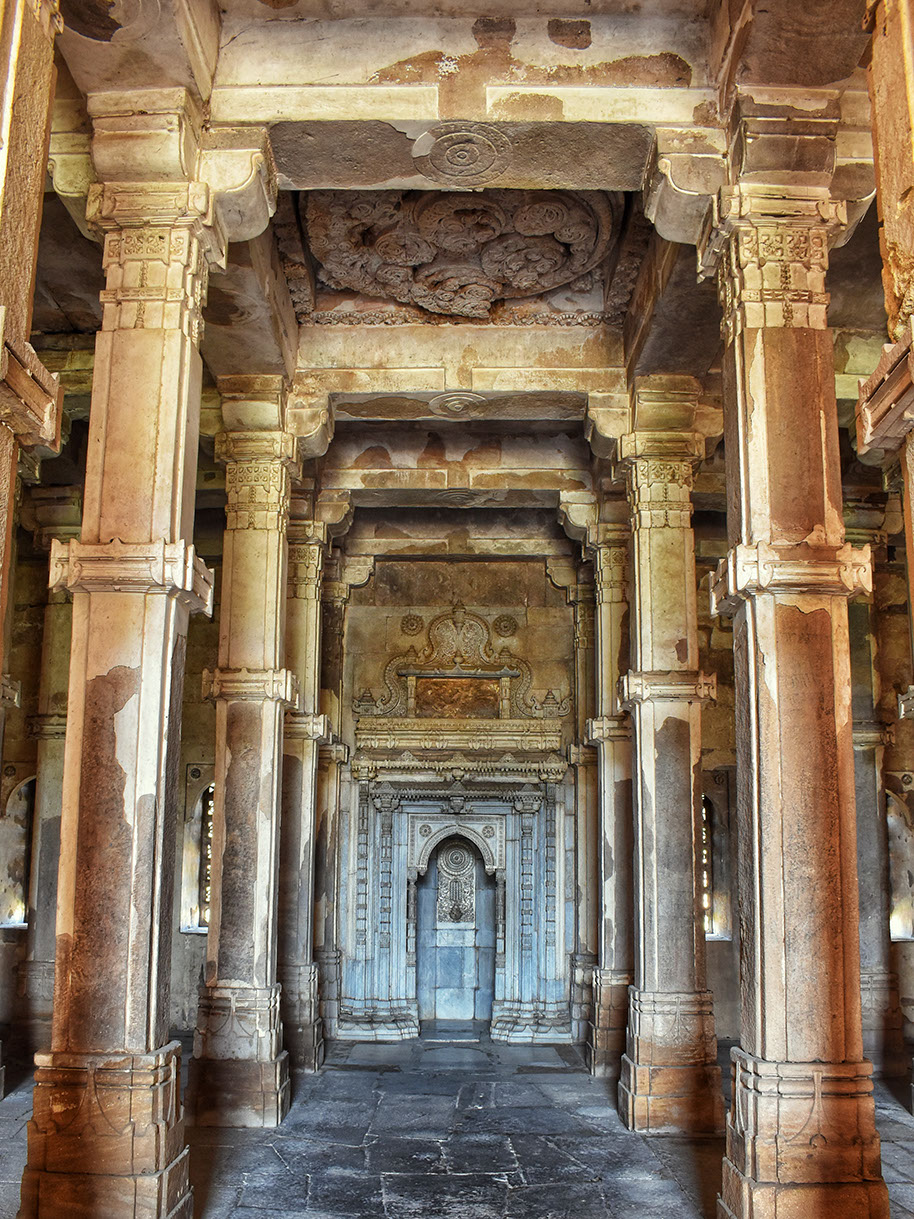
The central mihrab is made up of marble stones
When you take a closer look at the marble structure, you'll see that it has three different elements. At the top, there's a design of surya chakra, which is a Jain architectural element. In the middle, there are chains, which are a feature commonly found in Islamic architecture. And at the bottom, there's a pot, which is a part of Hindu architecture. These three elements come together to create a unique and diverse design in the mihrab.
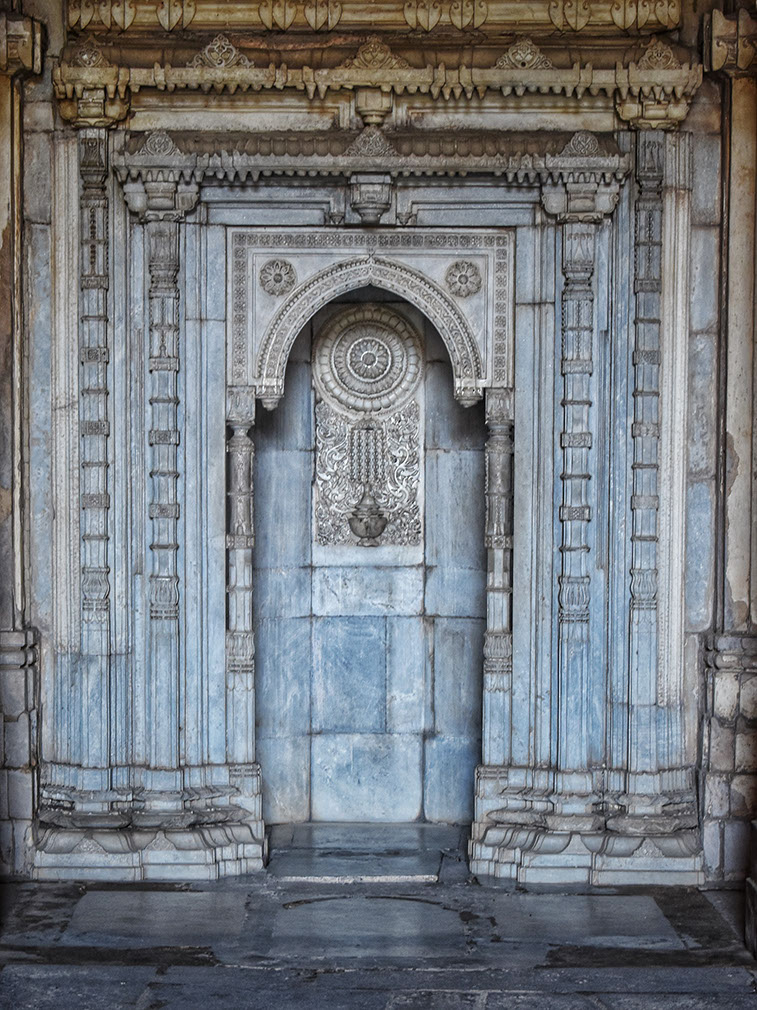
Featuring beautiful carvings in the marble stone, the central mihrab combines three architectural elements
The Jami Masjid has around 51 windows with unique designs of jhalis (screens). These windows bring in plenty of light from all directions into the prayer hall. One remarkable thing about these windows is that they also help to naturally cool the mosque. They transform the hot air outside into cool air as it enters, creating a refreshing environment inside. The jhalis are designed in different geometric shapes, adding to the beauty and uniqueness of the mosque's windows.
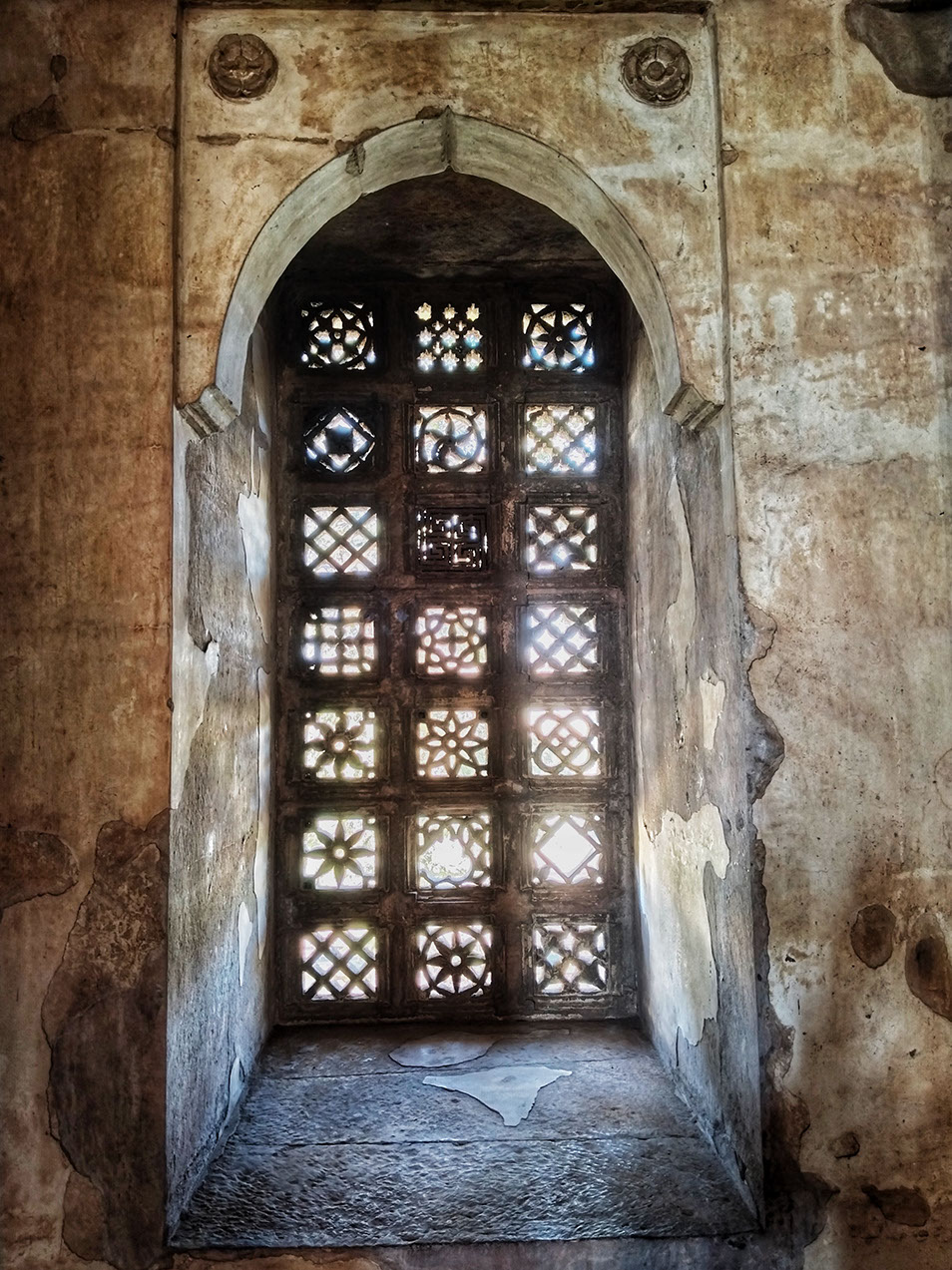
A mosque window has geometric patterns carved into its jhali
The entire mosque was coated with a plaster of paris polish, and some remnants of this polish can still be seen on the walls and pillars. This gave the mosque a shiny appearance, reminiscent of marble. While there are many Juma Masjids in India, this particular mosque was named "Jami" Masjid for a special reason. "Jamie" is an Arabic word meaning "unifier." This mosque was unique as it allowed royal women to enter and pray, breaking convention. A section of the prayer hall, known as Janan Khana or Muluk Khana, was reserved specifically for women and had a separate entrance. Another interesting feature inside the Jami Masjid was the "Maqsurah," an enclosure with jhalis placed near the mihrab. The Maqsurah was reserved for the Muslim ruler and his entourage, providing protection from assassins during prayer.
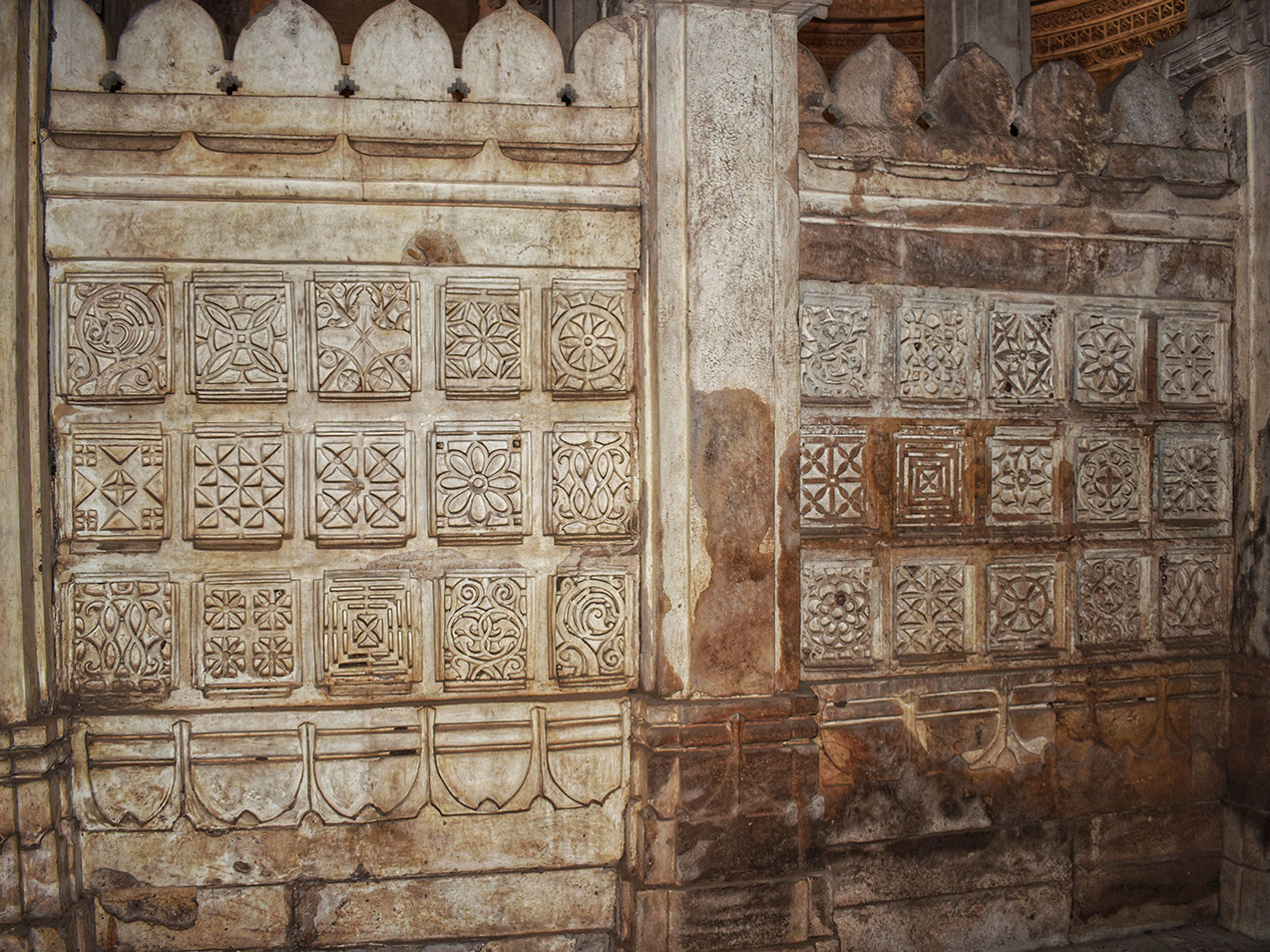
The prayer hall still retains traces of Maqsurah
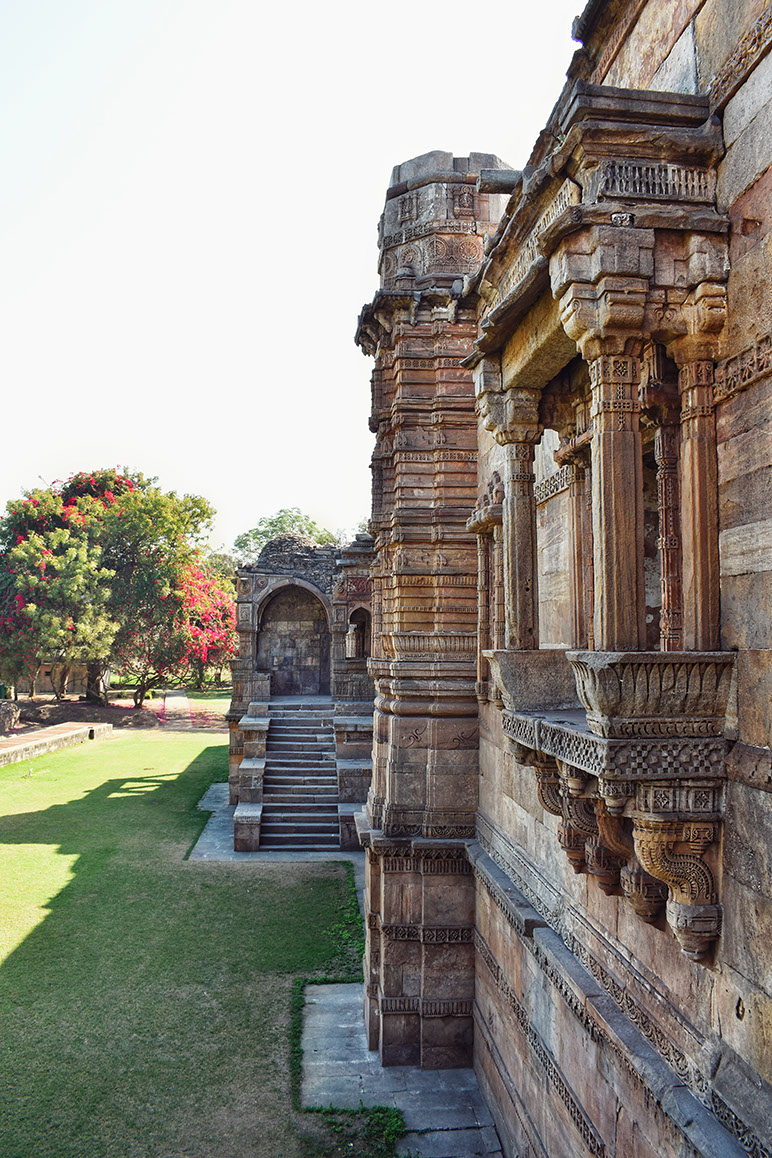
An entrance on the north side of the prayer hall was reserved for women from the royal family
Mahmud Begada, the builder of most monuments in Champaner, constructed them with the primary intention of facilitating prayer. Each mosque featured a designated area known as Wazuh Khana, where a sacred ablution tank was located. To ensure a continuous water supply to these tanks, Champaner employed a water preservation system. Rainwater flowing from the Pavagadh hills was collected and harvested in numerous step wells. Adjacent to the mosque, there is a stepwell that serves as a water source, continuously supplying water to the mosque through an underground channel.
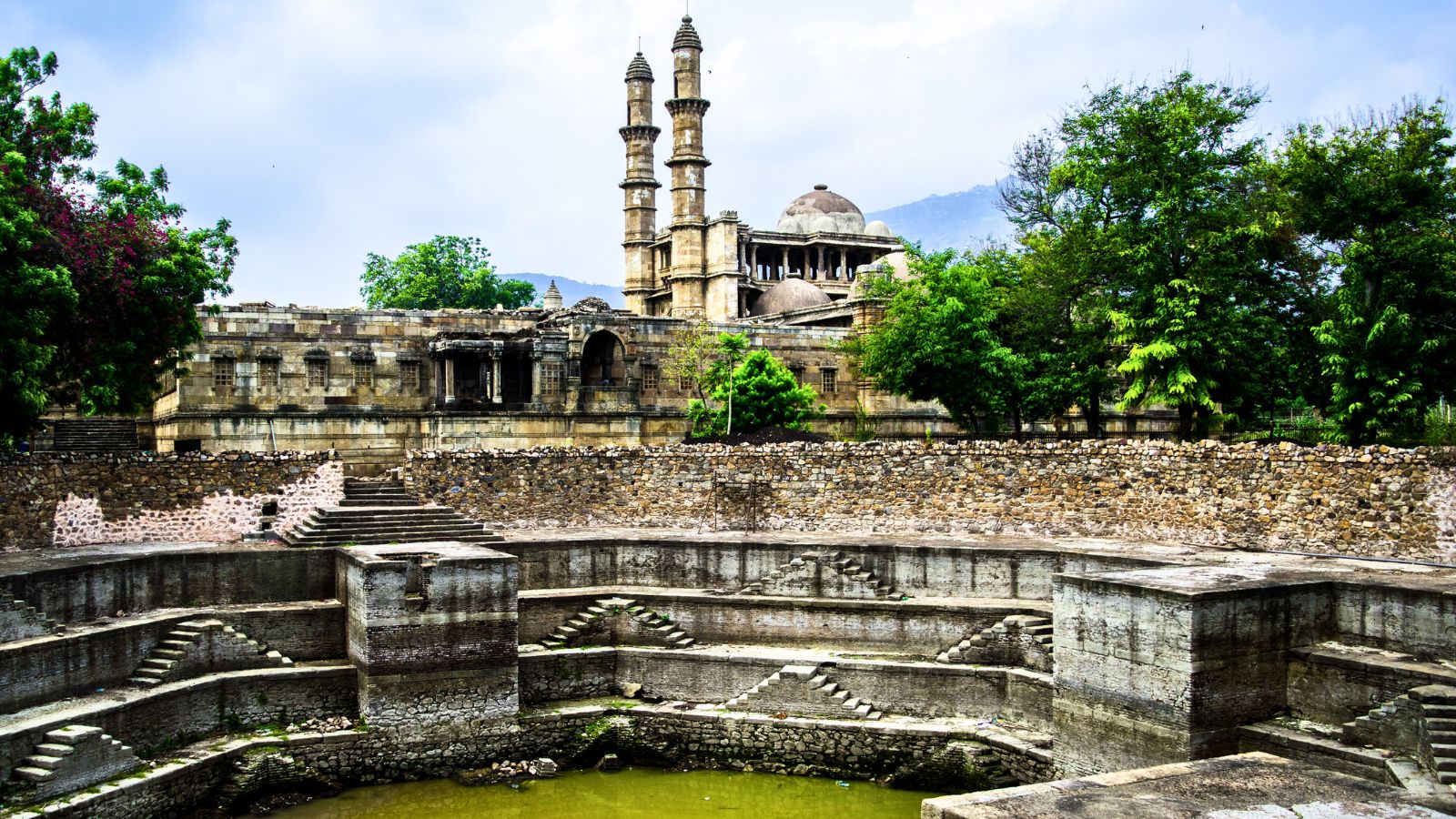
An octagonal stepwell north of Jami Masjid with steps every 5 feet and a depth of 20 feet
Kamani Masjid: a maze of arches
Nestled within the forested area, a short distance away from the main mosques in Champaner, lie the captivating ruins of Kamani Masjid. The Archaeological Survey of India (ASI) embarked on an extensive excavation project in 2008, finally completing it in 2015. The mosque had been almost swallowed by the surrounding sands, making the excavation and restoration a time-consuming endeavor.
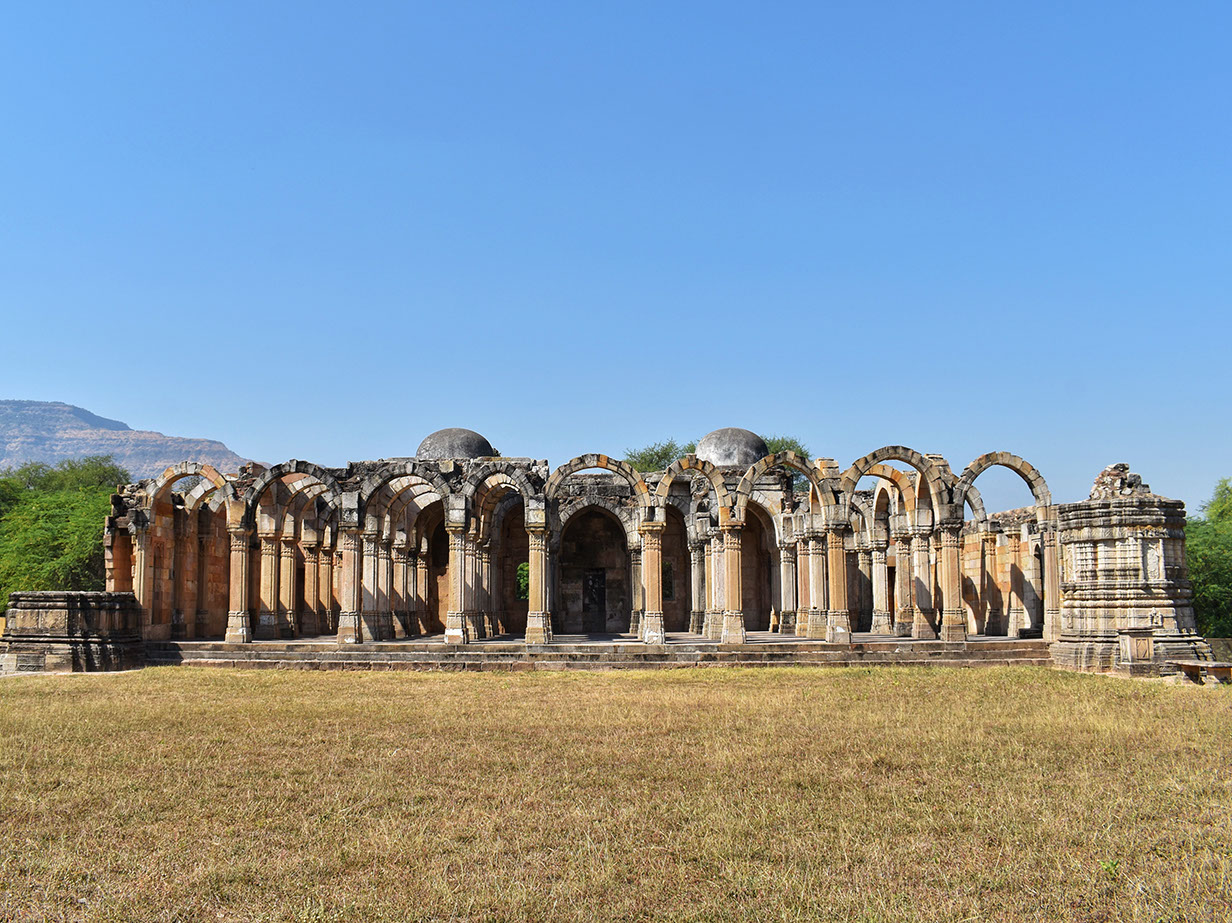
Kamani Masjid's exterior panorama
In its heyday, Kamani Masjid stood amidst a residential neighborhood, as evidenced by the discovery of various household artifacts during the excavation. This suggests that the mosque was intended to serve the local populace. Unfortunately, historical records are sparse, leaving even its original name a mystery. However, owing to its remarkable architecture featuring a pillared hall adorned with arches, it has been affectionately dubbed Kamani Masjid, derived from the Gujarati word "kaman" meaning arch. As of late, it has become a popular sightseeing place in Champaner.
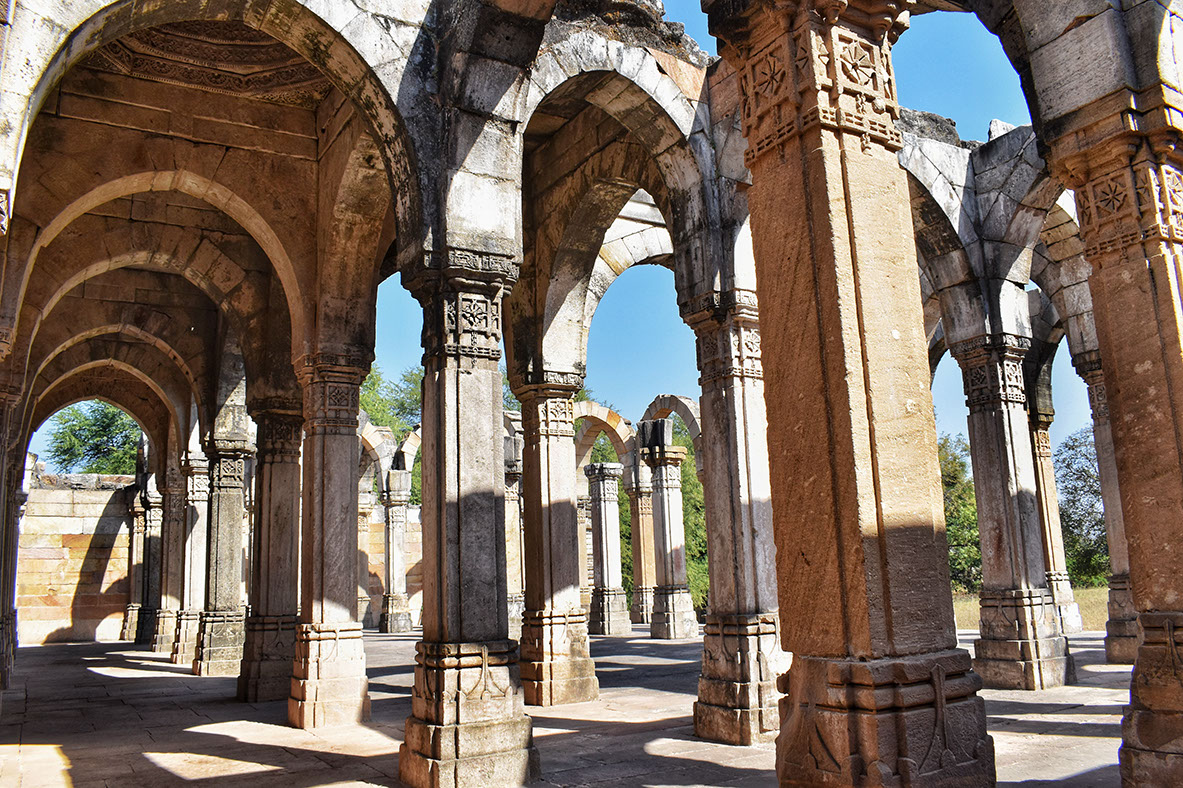
An interior shot of Kamani Masjid with arched pillars and destroyed domes
Kabutarkhana Pavilion: A home for messengers
Kabutarkhana, a charming two-story brick-structure, served a dual purpose during the reign of Mahmud Begada. Situated on the banks of a vast Vadatalav lake, with the majestic Pavagadh hills adorning the opposite side, this building enjoyed a refreshing breeze that provided respite from the sweltering summer heat. The first floor was designated for men, while the ground floor offered a tranquil retreat for the women of the royal families, who would visit to relax and immerse themselves in the scenic beauty surrounding the area.
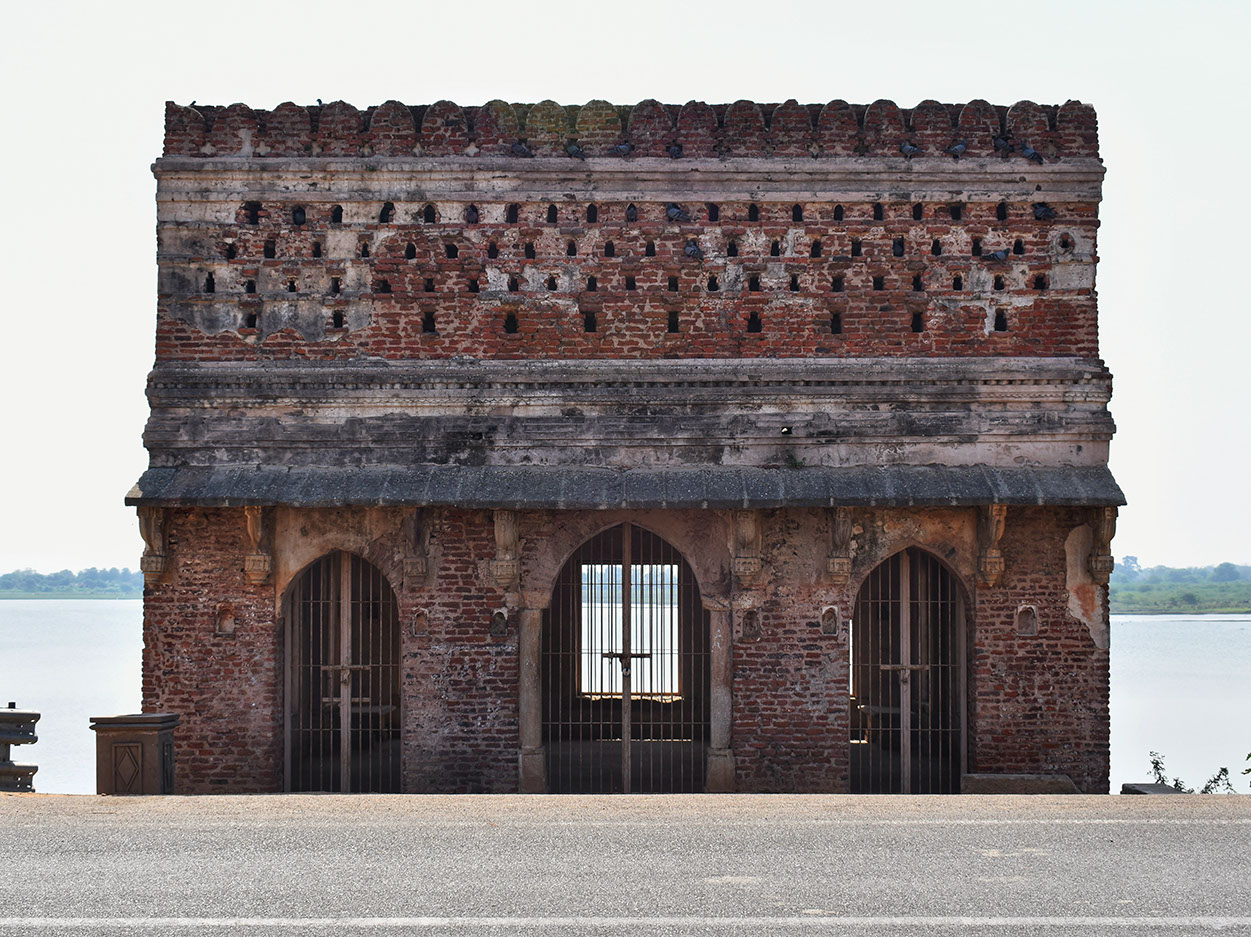
Ruins of Kabutarkhana on the shores of the lake
Notably, Kabutarkhana also served as a sanctuary for pigeons. In ancient times, pigeons were used as messengers for long-distance communication. As the Gujarati word for pigeon is "kabutar" and "khana" refers to a pigeonhole, the name Kabutarkhana aptly captures the building's association with these winged messengers.
Today, Kabutarkhana stands as a testament to the ingenuity of its design, offering visitors a glimpse into the historical significance of this multifunctional structure and the picturesque landscape that once captivated the royal families of Champaner.
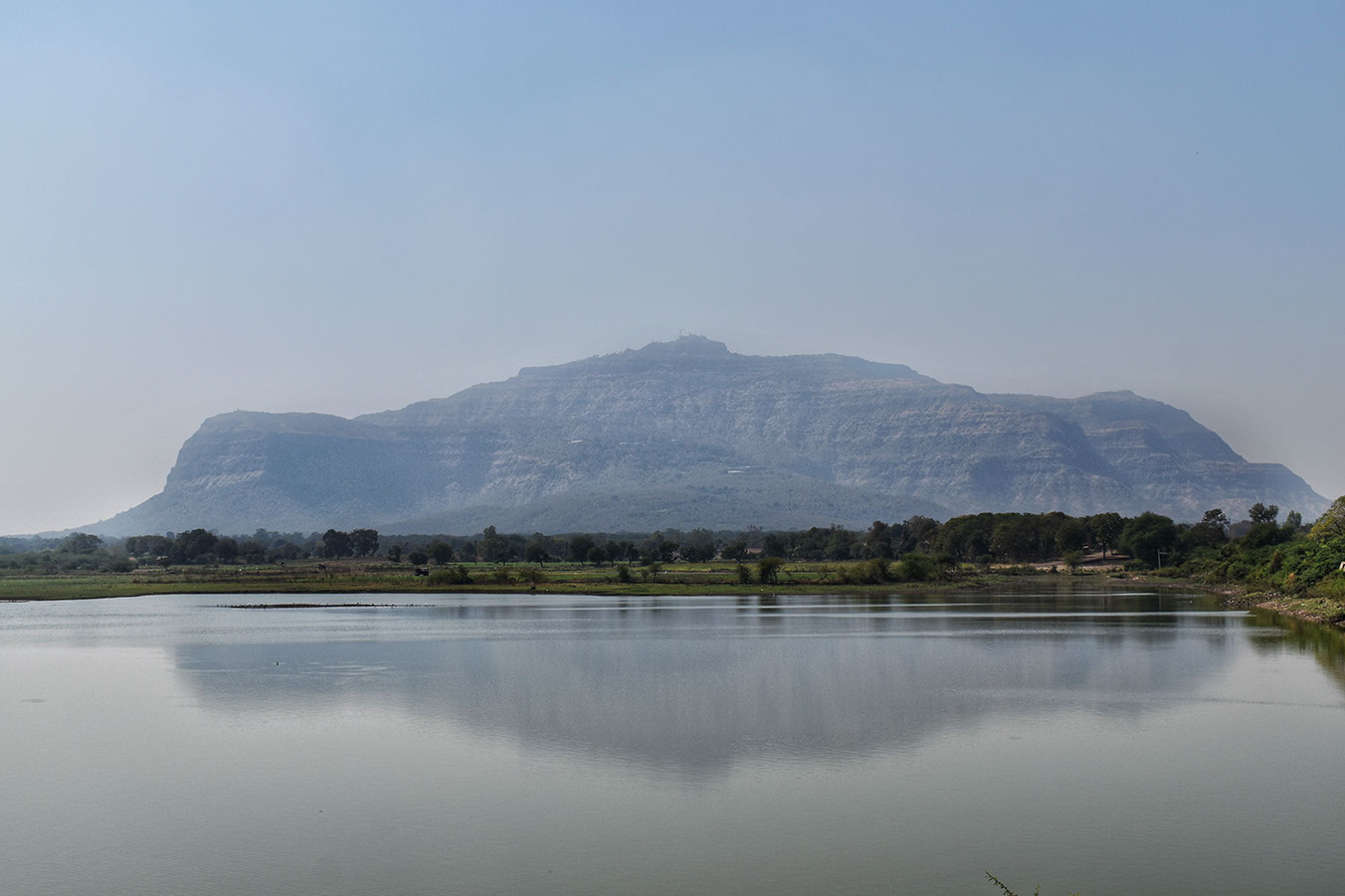
The tranquil surroundings of the Vadatalav lake with Pavagadh hills in the background
Khajuri Masjid: A bygone era
On the opposite side of Kabutarkhana, lies the mesmerizing ruins of Khajuri Masjid. Resembling Kamani Masjid in design, this mosque differs in its pillar structure, lacking the characteristic arches. With the roof and domes in a state of disrepair, Khajuri Masjid now stands as an open-air structure. The mosque derives its name from the abundance of palm trees that once adorned the area, as "khajur" translates to dates in English. Regrettably, limited historical information exists about this enigmatic mosque, leaving much of its past shrouded in mystery.
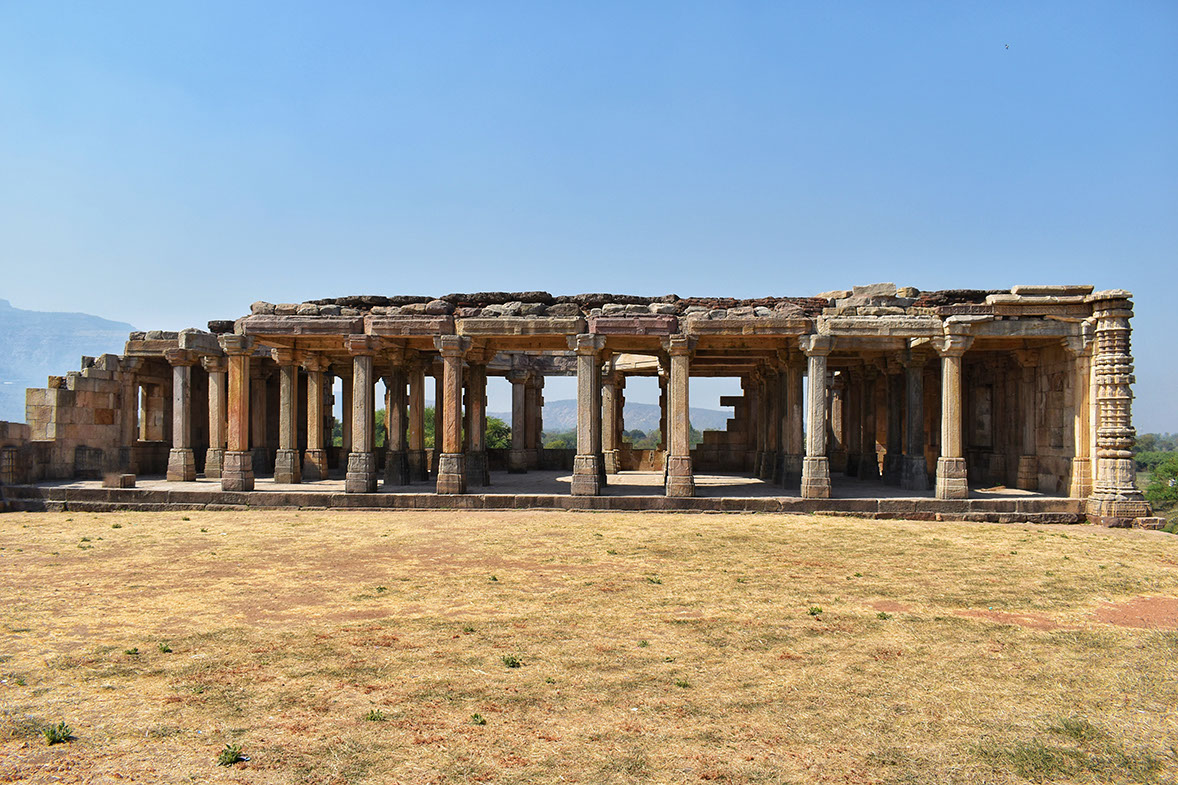
The ruins of Khajuri Masjid opposite to Vadatalav
Kevada Masjid: A flight of intricate dreams
Located in a secluded forested area, Kevada Masjid in Champaner unveils its hidden charm. As you approach, you'll be captivated by its ornate three-arched facade, showcasing intricate detailing. In this rectangular mosque, beautifully carved minarets rise gracefully and feature elaborate floral and geometrical designs.
One of the mosque's remarkable features is its mausoleum, a cenotaph that adds a touch of significance. The square-shaped cenotaph boasts a central dome adorned with fluted patterns, complemented by four corner domes, creating a visually stunning ensemble.
Inside the mosque, you'll discover intricately carved mihrabs, exuding an aura of craftsmanship. The niches showcase an interplay of floral and geometrical designs, evoking a sense of beauty and spirituality. Because Champaner tourism hasn't placed a signage board directing visitors to this mosque, it's off the tourist radar .
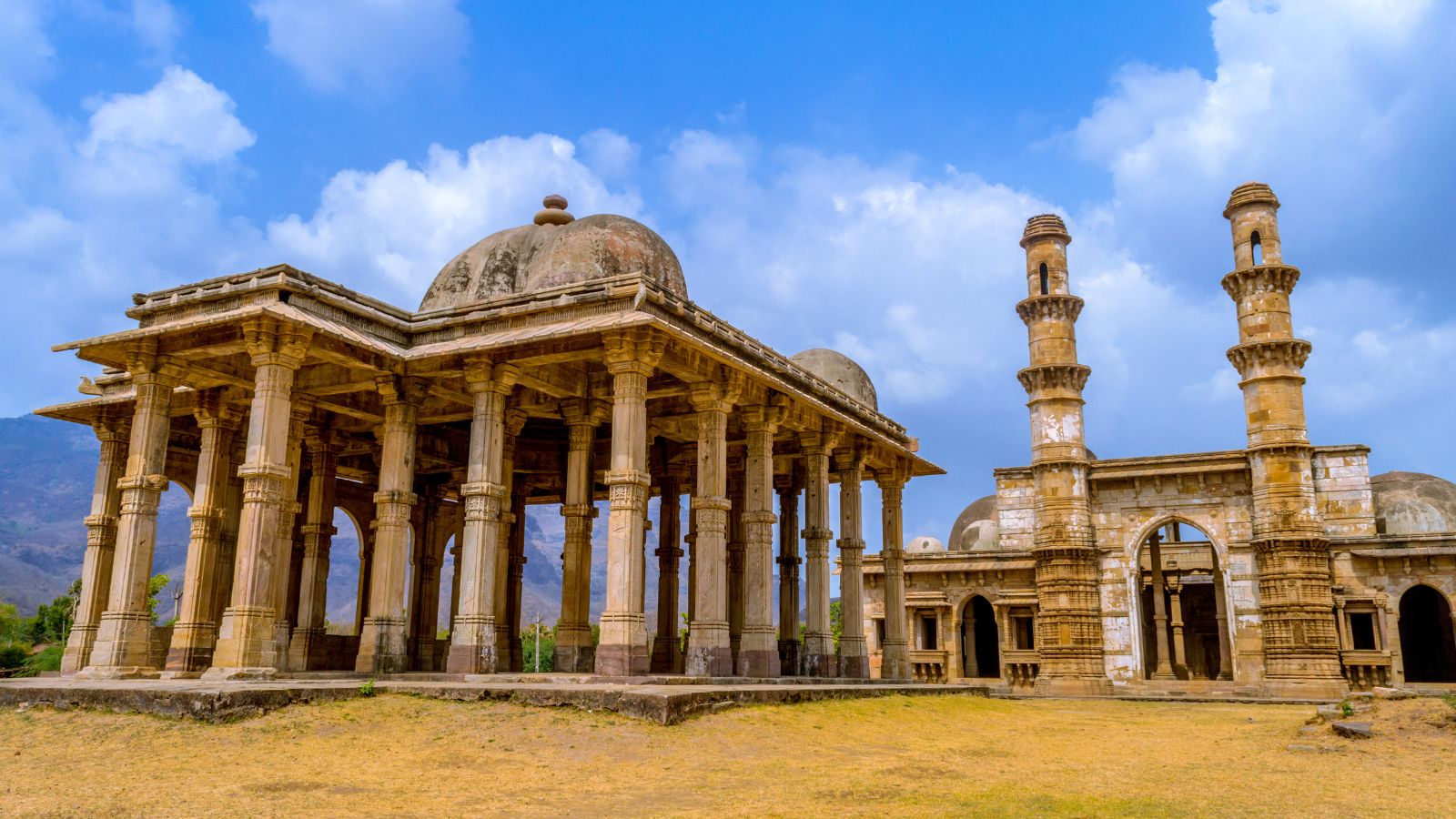
Kevada Masjid and the cenotaph in front
Nagina Masjid: A blossom of stone
Nagina Masjid in Champaner derives its name from its radiant beauty, as "Nagina" translates to "Jewel." The mosque stands on a raised plinth, offering a commanding view of its expansive open courtyard. Constructed entirely of pristine white stone, it exudes an ethereal charm.
As you enter, your eyes will be drawn to the three mihrabs, marking the direction of prayer. These intricately designed alcoves add a touch of elegance and spiritual significance to the mosque's interior. The minarets of Nagina Masjid, like those of its counterparts, showcase exquisite carvings with delicate floral motifs adorning the niches. These intricate details reflect the mastery of craftsmanship.
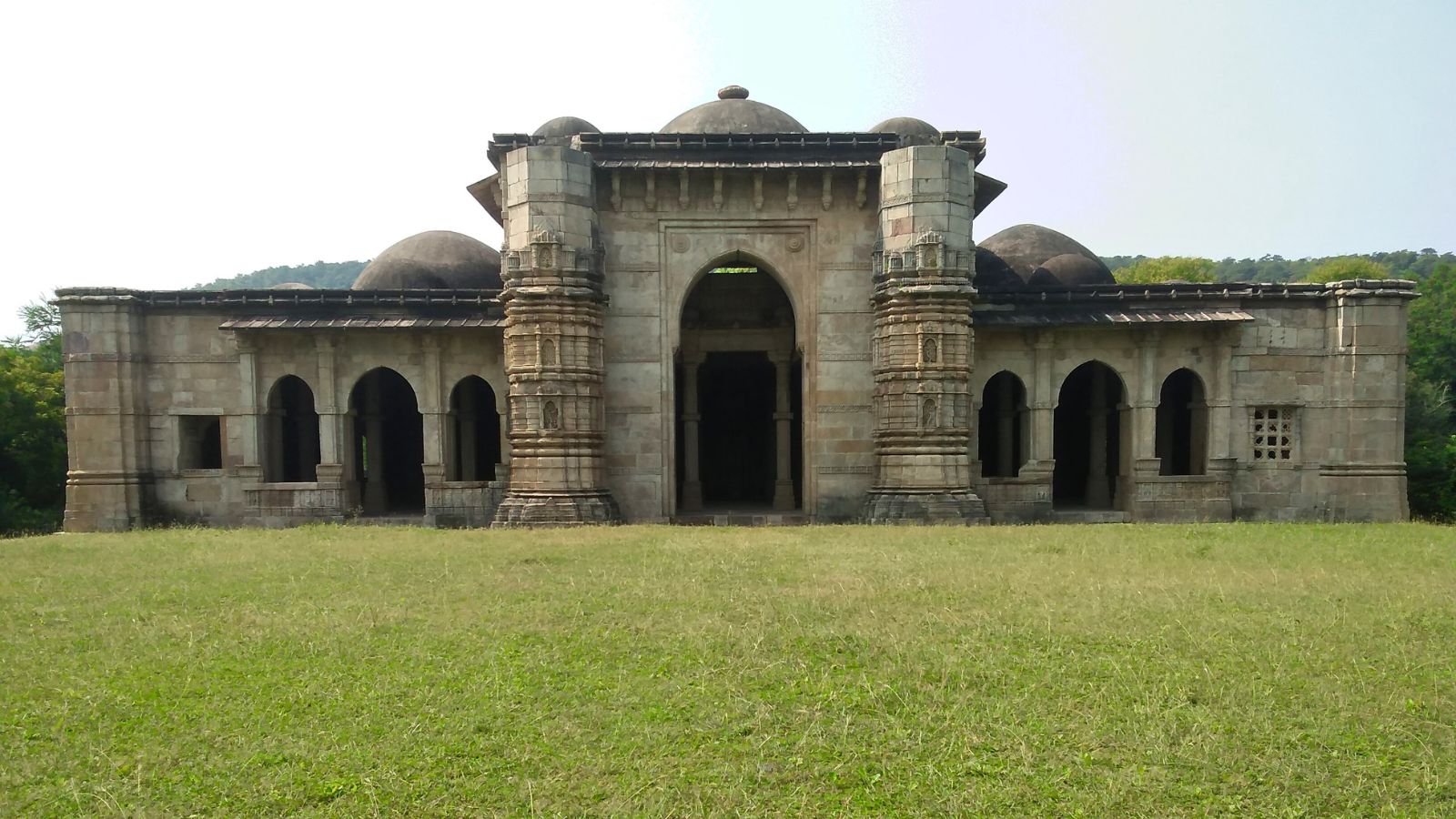
A view of the courtyard and the front of Nagina Masjid

Sat Kaman: The legacy of Champaner
With our visits to the prominent monuments in Champaner nearing completion, our attention turned towards a famous attraction atop the Pavagadh hills - Sat Kaman. Positioned near one of the gates on the Western side of the fort, Sat Kaman, also known as the Seven Arches, awaited our arrival. Constructed using local sandstone and employing keylocking techniques, these arches showcased remarkable craftsmanship. Each arch was formed by skillfully arranging trapezium-shaped stones, with a wedge-shaped stone crowning the top.
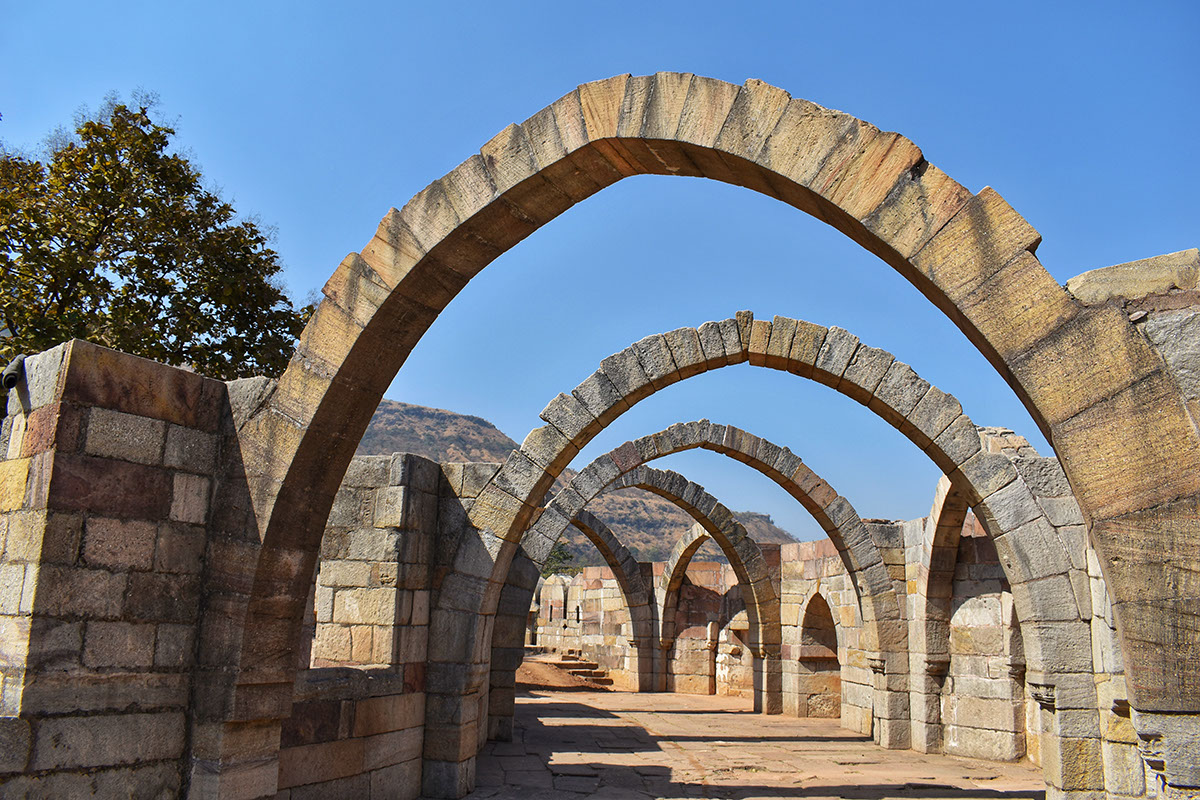
Champaner is synonymous with Sat Kaman
In the past, this area served as gate numbers 4 and 5 of the fort, although the walls surrounding the gates have since suffered damage. Originally, the purpose of Sat Kaman was to provide an elevated vantage point for the soldiers, allowing them to survey the entire expanse of Champaner city.
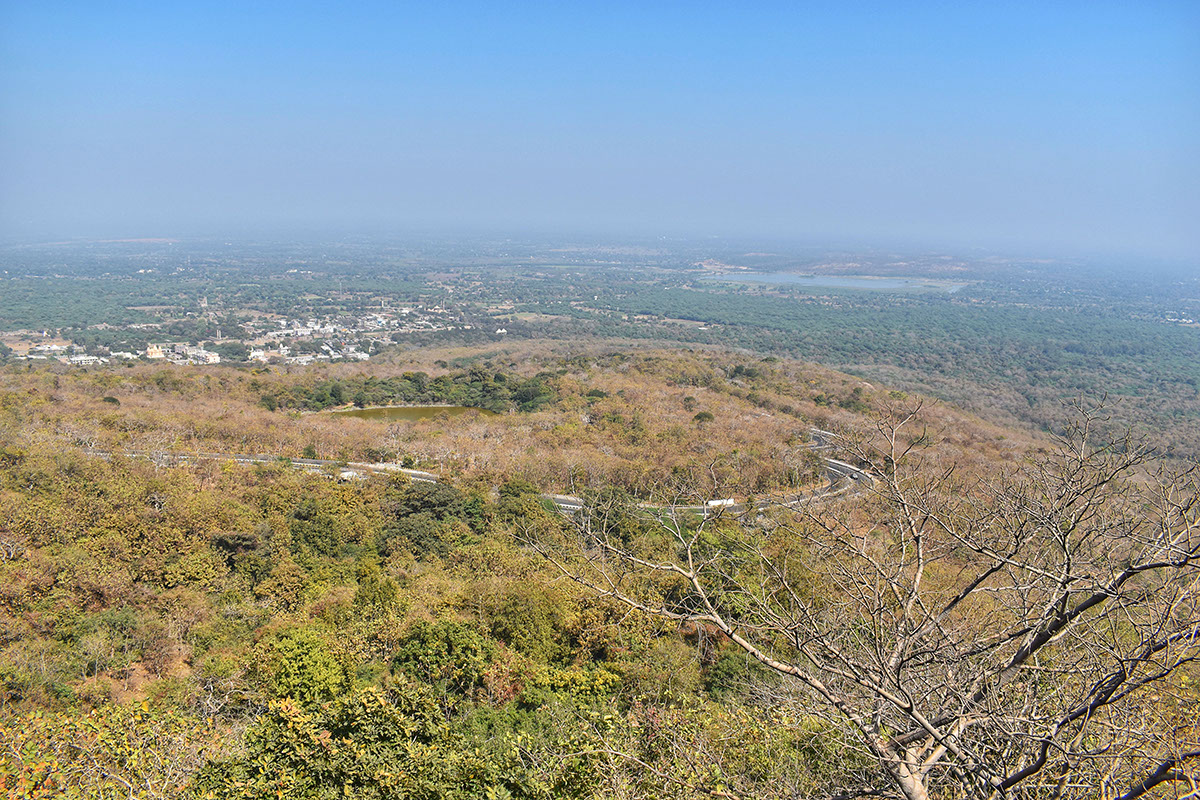
Champaner and surrounding area as seen from Sat Kaman
Helical Stepped Well: A journey to the center of the earth
As our time in Champaner drew to a close, we prepared to depart for Vadodara. My stomach was growling and I was craving some local Gujarati cuisine However, we couldn't resist exploring two intriguing monuments that lay along our route. The first of these captivating sites was the Helical Stepped Well, a magnificent structure designed to provide drinking water to the residents of Champaner. This well, reaching a depth of 180 feet, boasted an impressive construction of bricks and stones.
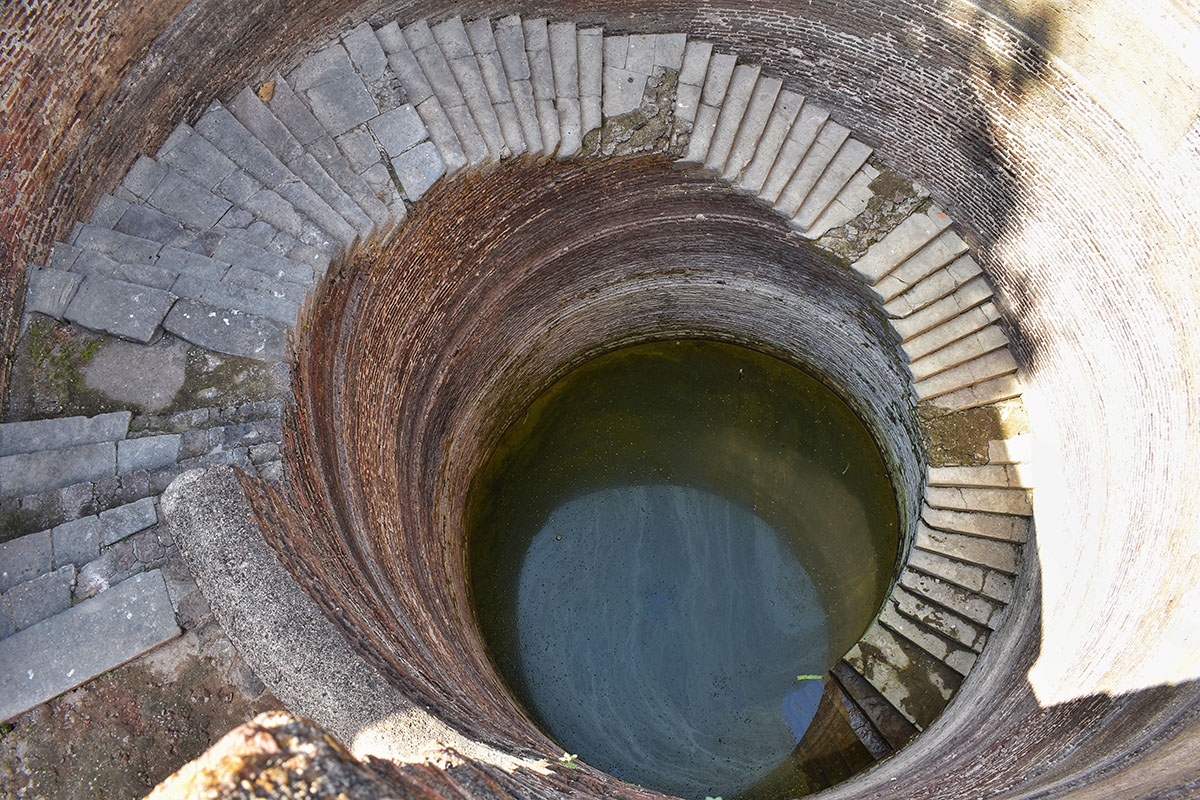
A view from above of the Helical Stepwell with spiral stairs leading to the water
Its distinctive feature was the spiral staircase, allowing visitors to descend into its depths. Each step spanned a width of 1.2 meters, ensuring safe passage. Surrounding this architectural marvel is a charming courtyard, adding to the overall allure of the Helical Stepped Well. The city of Champaner had a great water engineering and rainwater harvesting system, which made it known as "the city of a thousand wells."
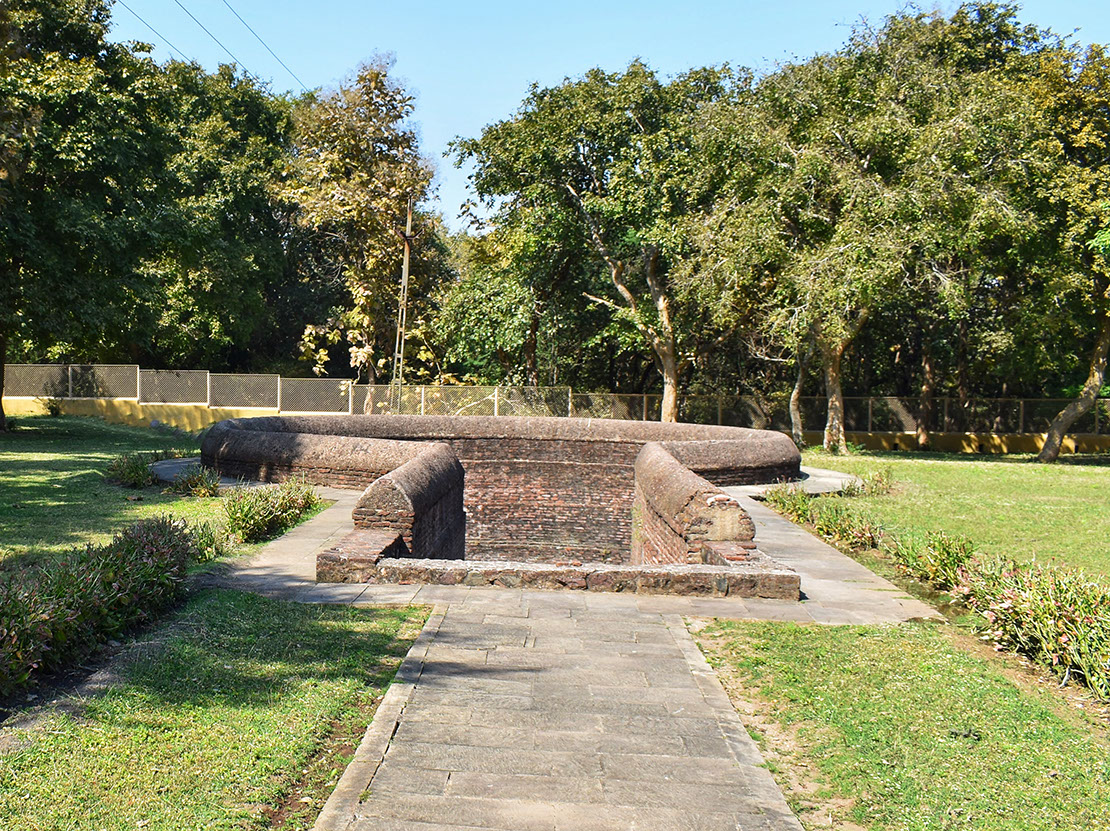
A beautiful courtyard surrounds the Helical Well
Sakar Khan's Dargah
As we approached the end of our journey, we arrived at a captivating monument undergoing its final stages of resurrection under the dedicated efforts of ASI. Standing proudly just before the main entry gate of Champaner, we encountered Sarkar Khan's Tomb, considered the largest tomb in the entire city. Its square-shaped structure, adorned with a grand dome and a facade graced by numerous windows, exuded an aura of magnificence. Stepping inside, I was greeted by an equally captivating interior featuring a spacious dome and intricate carvings adorning the supporting arch.
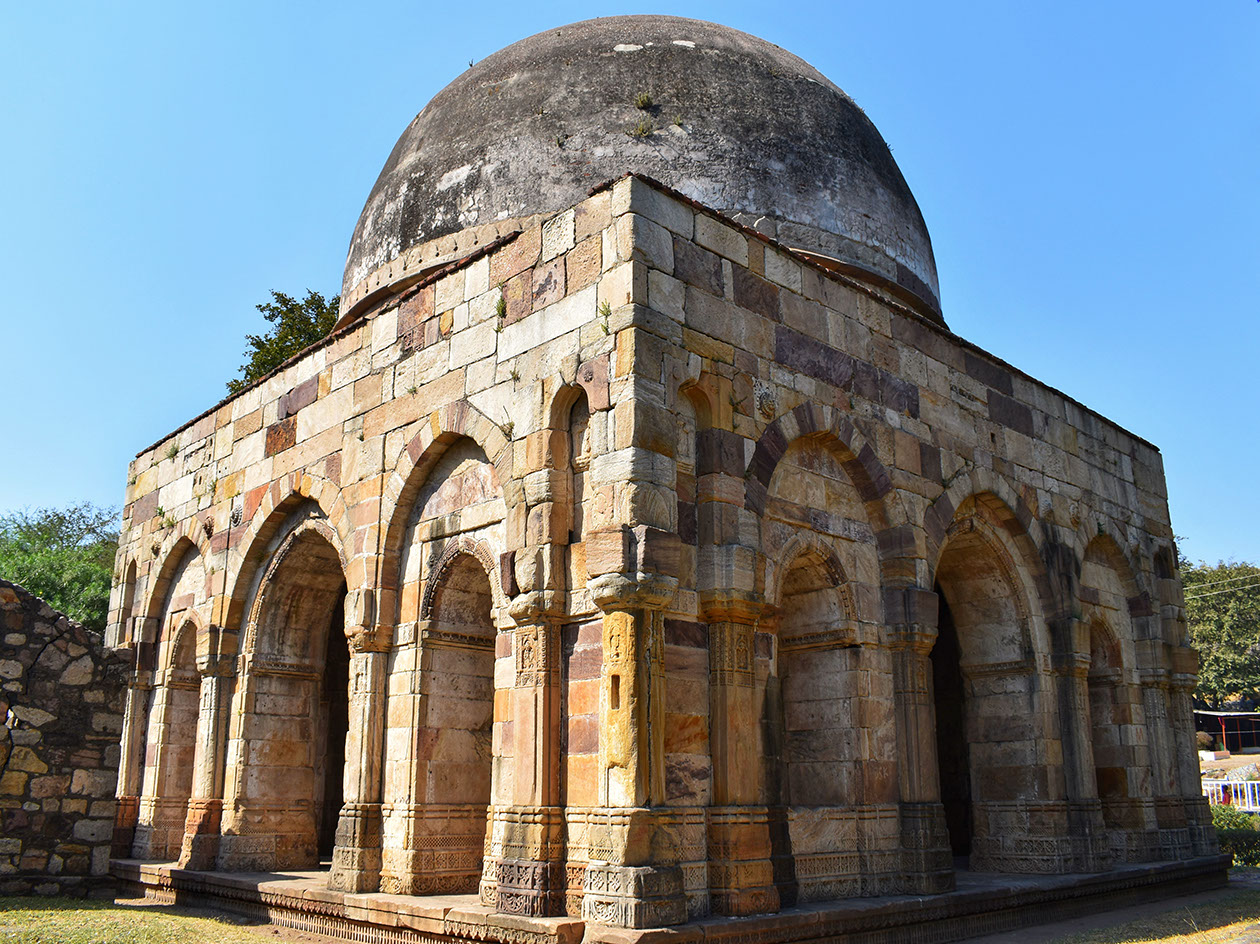
Sakar Khan's Dargah in Champaner's outskirts is a strikingly beautiful structure
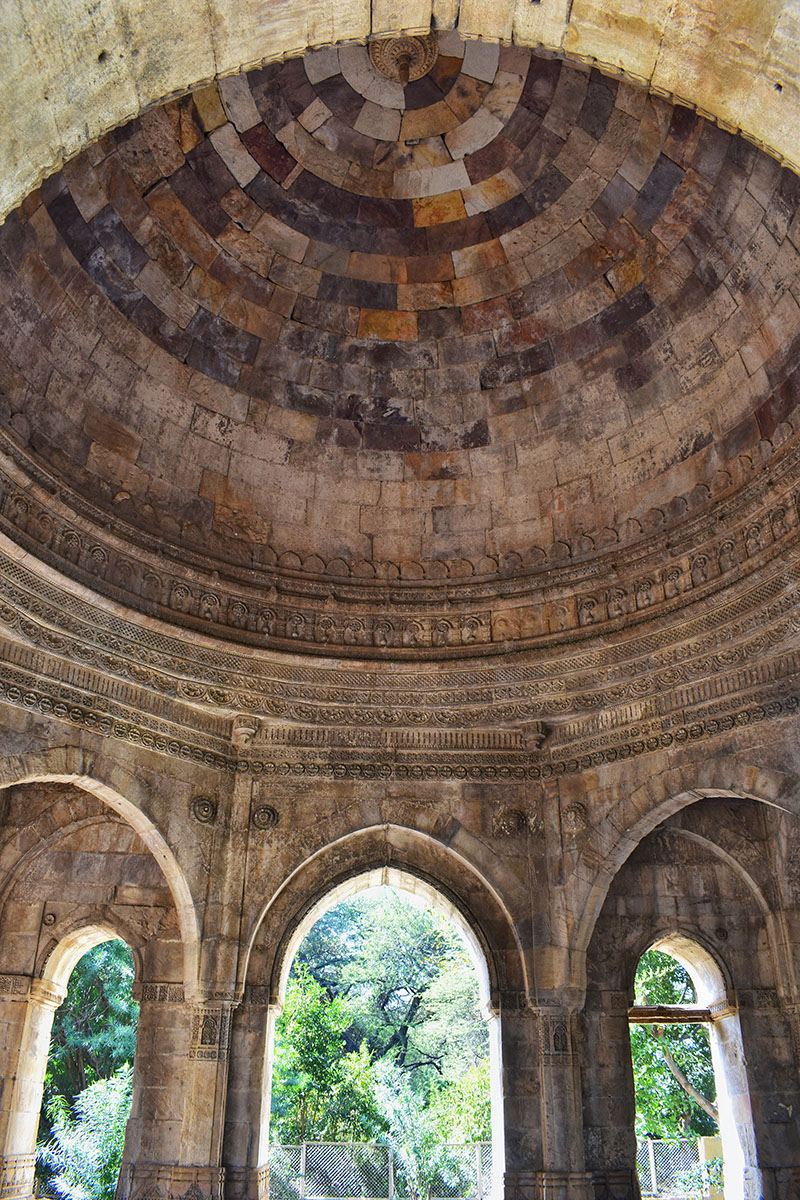
An interior view of Sakar Khan's Tomb with its colorful tile design
The untold story...
As I bid farewell to the enchanting city of Champaner, a wave of bittersweet emotions washed over me. It was a journey that unearthed hidden treasures, both in the form of majestic monuments and forgotten stories. Standing amidst the ruins, I couldn't help but feel a deep sense of longing and melancholy for this city, once a thriving capital, now lost in the mists of time. The whispers of its past echoed in my ears, urging me to cherish and preserve the remnants of this forgotten gem. Champaner, with its rich history and architectural marvels, reminded me of the ephemeral nature of human existence and the importance of preserving our heritage. As I walked away, a part of me remained intertwined with the ancient stones, vowing to keep the memories of Champaner alive and to share its tale with the world.
Frequently Asked Questions :
What is the best way to reach champaner.
The most convenient way to reach Champaner is by road. You can take a taxi or drive from nearby cities like Vadodara and Ahmedabad. Chamaner is 50 km from Vadodara and 150 km from Ahmedabad. Buses run regularly from Vadodara to Champaner. There are also flights and trains to Vadodara and Ahmedabad. Ahmedabad, an international airport, has better flight connections than Vadodara.
What are the accommodation options in Champaner?
Champaner, being a small place, does not have decent hotels for accommodation. However, the best option for lodging would be Vadodara. There are a wide range of hotels in Vadodara to suit every budget, ranging from luxury hotels to budget accommodations. You can find well-known hotel chains, boutique hotels, and even homestays in Vadodara.
What is the Champaner-Pavagadh Archaeological Park?
Champaner-Pavagadh Archaeological Park is a UNESCO World Heritage Site in Gujarat, India. It encompasses the historical city of Champaner and Pavagadh Hill. In addition to its rich cultural heritage, the park also features Indo-Islamic architectural styles. The city preserves several ancient temples, mosques, forts, and step wells, which provide an insight into the religious significance and remnants of the medieval city. The park provides visitors with an opportunity to learn about the region's fascinating history and architecture.
What are the must-try local dishes in Champaner?
As Champaner lacks decent dining options, it is recommended to travel nearby to Vadodara or Halol to experience the culinary delights. A Gujarati thali is a must-try, which includes a variety of vegetarian dishes prepared in a traditional manner. Gujarati cuisine is known for its flavorful curries, snacks like dhokla and khandvi, and sweets like jalebi and shrikhand. You can savor the flavors of Gujarat in Vadodara's many restaurants and eateries that serve delectable local dishes.
How much is the entrance fee to Champaner-Pavagadh Archaeological Park?
The entrance fee to Champaner-Pavagadh Archaeological Park is INR 40 for Indian nationals and INR 500 for foreigners. It is advisable to carry the required amount in cash as credit or debit cards may not be accepted at the ticket counter. The entrance fee allows visitors to explore the park and its various historical monuments.
What are the visiting hours of Champaner-Pavagadh Archaeological Park?
Champaner-Pavagadh Archaeological Park is open daily from 8:30 am to 5:00 pm. During these hours, visitors have ample time to explore the park and its fascinating historical sites. Plan your visit accordingly and give yourself enough time to appreciate the beauty and history of this UNESCO World Heritage Site.
Can we go camping in Champaner?
The Champaner-Pavagadh Archaeological Park does not permit camping. The park is primarily intended for the exploration of historical and archaeological sites. There may, however, be camping options available in the surrounding area or nearby campsites outside of the park.
Are there any guided tours in Champaner?
There are no official guided tours offered by Gujarat tourism in Champaner. There are, however, a few private guided tours from Vadodara and Ahmedabad.
Which nearby attractions are recommended along with Champaner?
There are several nearby attractions you can explore when visiting Champaner. One of the must-visit attractions is the Kalika Mata Temple located on the Pavagadh Hill. Enjoy panoramic views of the surrounding landscape by taking a scenic ropeway ride to the hilltop.
Disclaimer: This blog may contain affiliate links. At no extra cost to you, we may get a small commission if you buy anything. All products and services we endorse have been personally used or come highly recommended to us. These incomes allow us to keep the community supported and ad-free.
Things To Consider
Best time to visit, art & culture, off the beaten track, travel checklist, about the author.

Rahuldev Rajguru
An entrepreneur for a better part of my life, I have traveled across 6 continents to 62 countries and lived in 6. Travel is my passion and has always been a vital part of my life. I regularly embark new adventures around the world. My travel has exposed me to diverse cultures, traditions and people. My love for adventure and exploration has taken me to many unique destinations, creating one-of-a-kind experiences. I have spent a substantial amount of time in third-world countries hence gaining knowledge and understanding of this region in particular. Globetrotting has given me immense experiences and expertise in travel while meeting amazing people from across the world. Through my stories, I aspire to share insightful experiences and information that could help other travelers make the most of their travel experiences.
Rate the Story
Related stories.
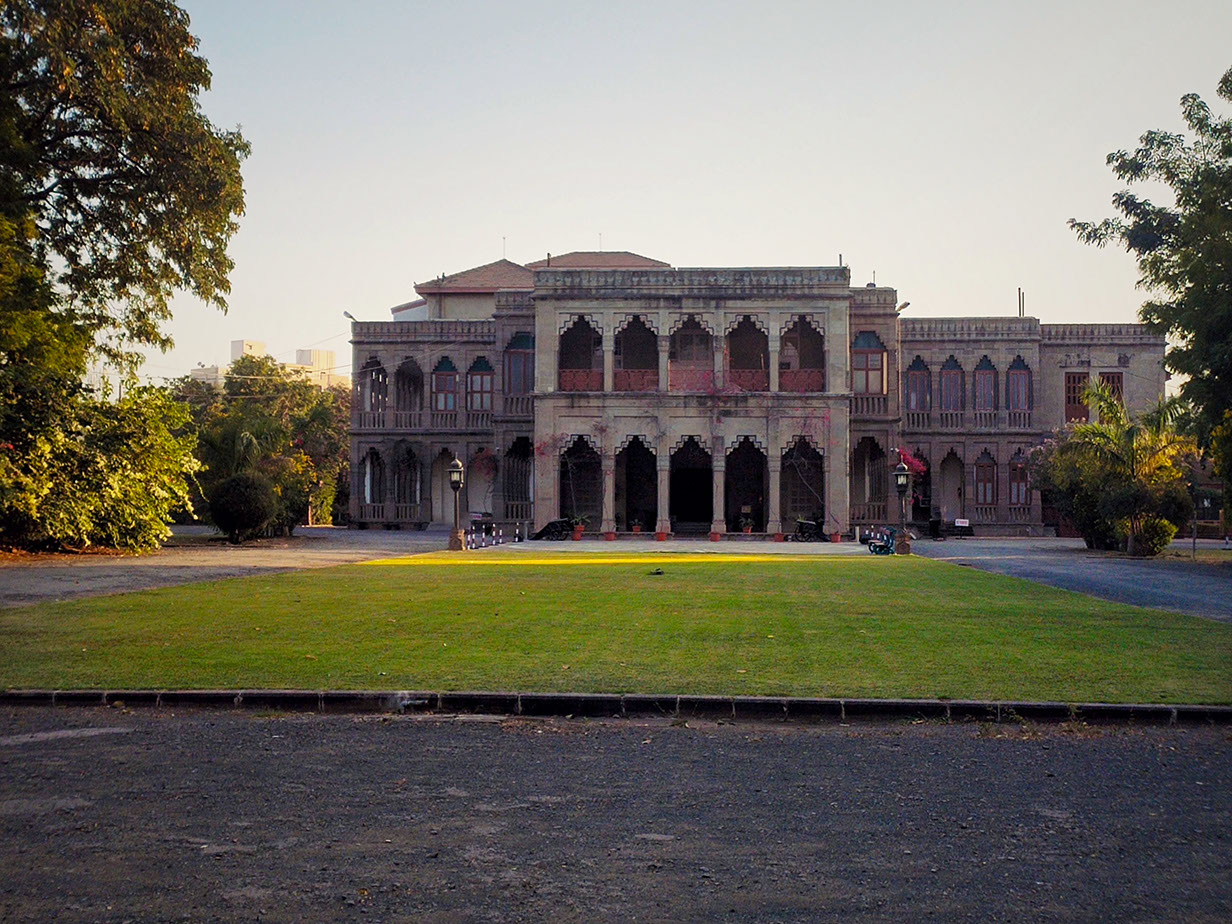
The Erstwhile Princely State of Bhavnagar
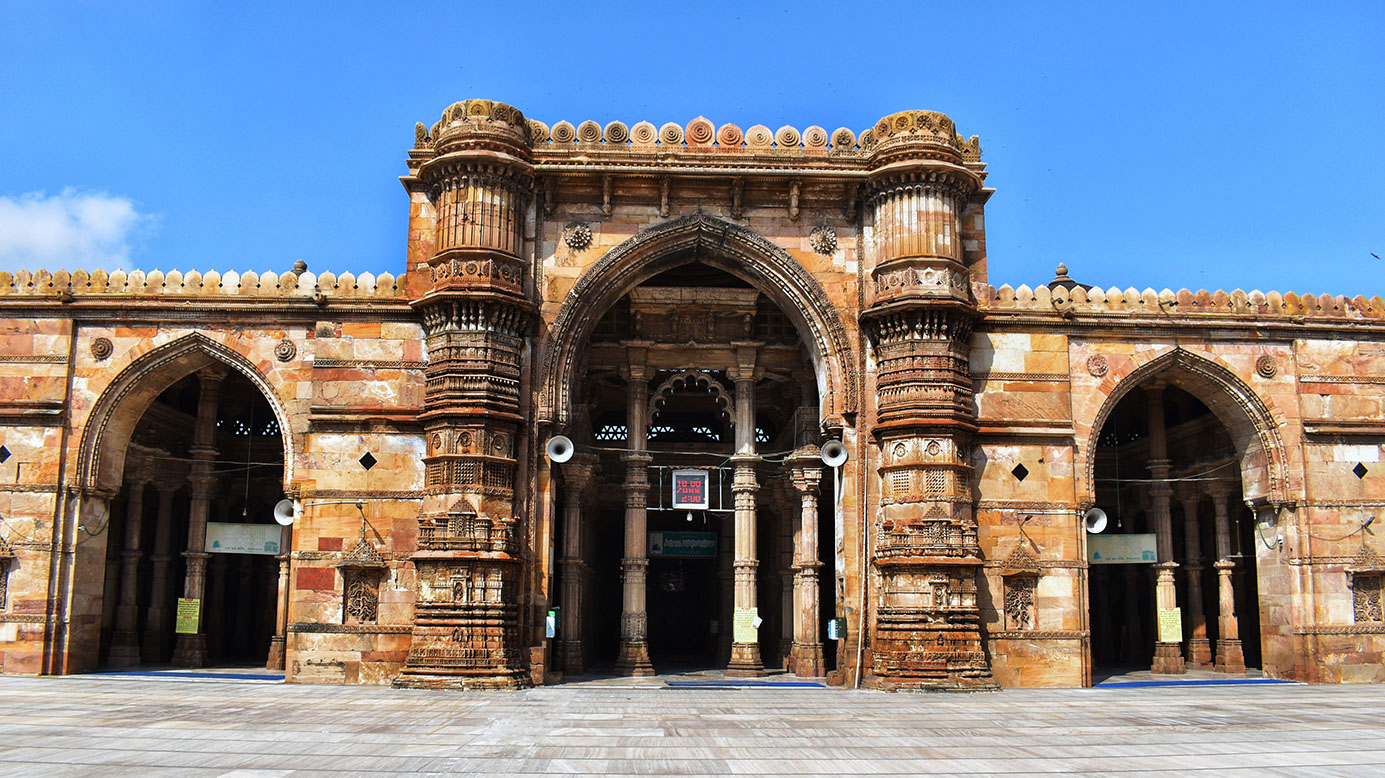
A Journey from Mandir to Masjid
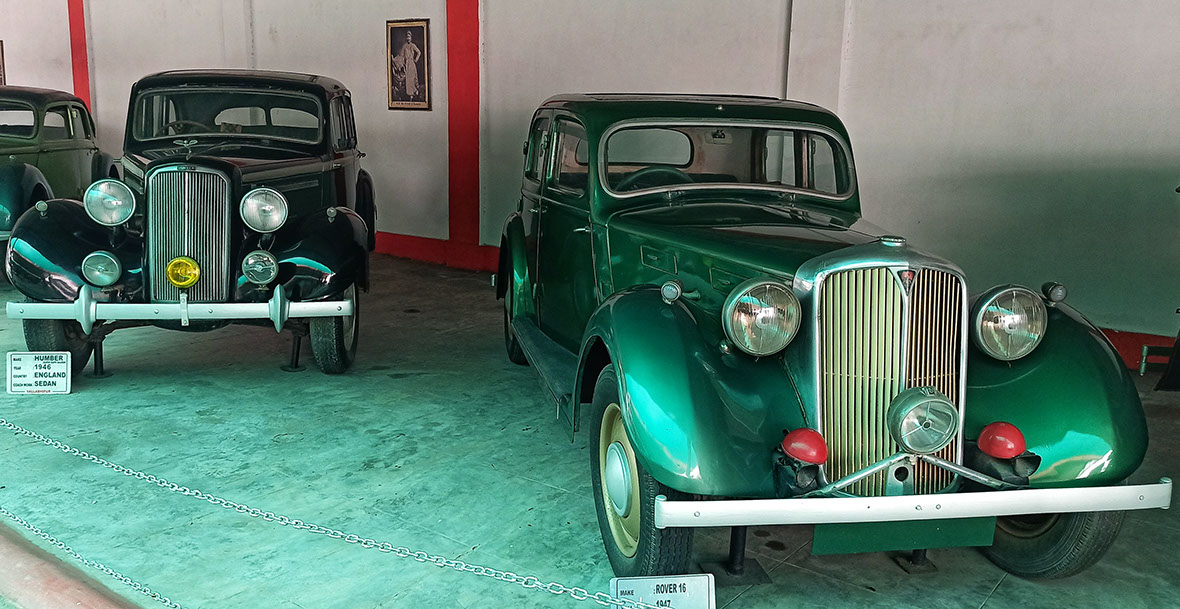
Wonderland of Vintage Cars
Please share your comment.
Subscribe to my monthly newsletter for all of my travel updates and blogging/influence tips!

We bring together a diverse travel community through storytelling. With a treasure trove of travel stories, we share personalized travel experiences and start conversations that inspire fellow travelers.
Top Destinations
- United States
- Other Destinations
Travel Resources
- Food & Drink
- Story Glimpse
- Travel Itinerary
- Travel Plannig
- Travel Tips
- Travel Route
- Things to Do
- Things to Know
- Travel Guide
- Other Resources
- About Turuhi
- Contributors
- Travel With Me
- Collaborate with us
- Privacy Policy
- Terms of Use
© 2024 Turuhi . All Rights Reserved
Message from

Hi, I'm Rahul, founder of Turuhi. I have been traveling for 20 years.
Finding real and authentic travel experiences can be challenging. My goal is to help you save money on travel and experience the world like a local.
I'll send you hand-picked travel stories, tips and tricks!
Travel - Experience - Share
- Philippines
- Netherlands
- Switzerland
- United Kingdom
- South America
- New Zealand
- Adventure Travel
- Culture & Heritage
- Sustainable & Responsible Travel
- Travel Products & Services
- Travel Tips
- Food & Restaurants
- Hotel & Resorts
- Travel Resources
- Published Work And Features
- Work with Us / Contact Us
- Search for: Search
Incredible Champaner Pavagadh Archaeological Park, Gujarat
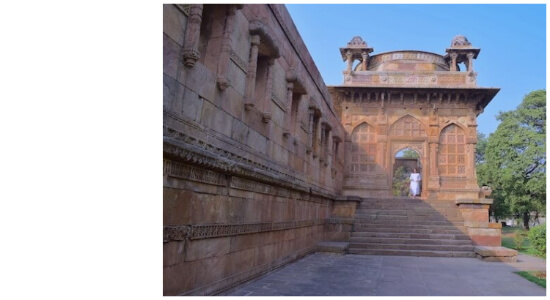
The Champaner Pavagadh Archaeological Park in Panchmahal District, Gujarat is a UNESCO World Heritage Site with more than 100 monuments.
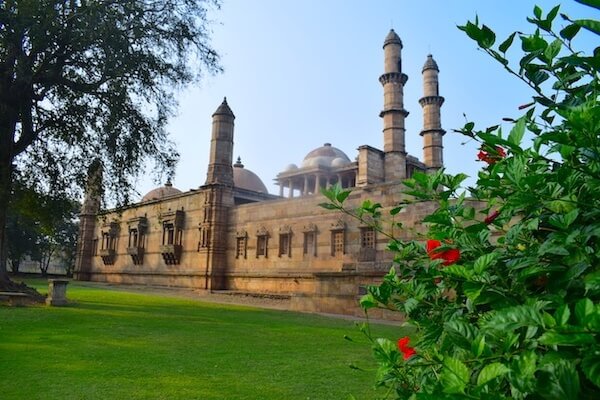
The state of Gujarat is a mesmerizing treasure trove of Heritage, It has 4 UNESCO World Heritage sites currently, including the Champaner Pavagadh Archaeological Park . There are 3 sites on the tentative list. Apart from the Champaner-Pavagadh Archaeological Park Panchmahal , the other UNESCO World Heritage Sites are Rani Ki Vav in Patan, Dholavira, and the heritage city of Ahmedabad . The tentative list features Vadnagar, Modhera Sun Temple , and the Wild Ass Sanctuary of the Little Rann of Kutch .
The Champaner Pavagadh Archaeological Park, Gujarat , is relatively lesser known than the other heritage sites. Read on for all you need to know about Champaner-Pavagadh Archaeological Park in Panchmahal District, Gujarat, India . We hope that this blog post serves as a Guide to Champaner-Pavagadh Archaeological Park .
The site is the only complete and unchanged Islamic pre-Mughal city – UNESCO
Table of Contents
Champaner Pavagadh Archaeological Park – List Of Monuments According To ASI
A large portion of the Champaner-Archaeological Park lies unexcavated. However, according to some sources, there are more than 100 monuments currently within the Champaner-Pavagadh Archaeological Park . The Archaeological Survey of India (ASI) lists these monuments. The site is scattered with the remains of monuments dating from around the 8th century to the 16th century. The site was inscribed as a UNESCO World Heritage site in 2004.

Here is a list of the monuments protected by the Archaeological Survey of India (ASI) in Champaner Pavagadh Archaeological Park, Panchmahal, Gujarat .
- Jami or Jama Masjid in Champaner
- Kevda Masjid and the Cenotaph in Champaner
- Nagina Masjid and the Cenotaph in Champaner
- Shaher Ki Masjid in Champaner
- Ek-Minar Masjid in Champaner
- Kabutarkhana Pavilion in Champaner
- Fortress and Wall in Champaner
- Helical Stepped Well in Champaner
- Sakar Khan’s Dargah in Champaner
- Three cells inside the citadel wall between Mandvi or Custom House in Champaner
- Tomb with a big dome in the centre and small corner domes on the way to Khajuri Masjid near Wada Talao
- Lila Gumbaz in Champaner
- Kamani Mosque in Champaner
- Bawaman Mosque in Champaner
- Atak Gate on Pavagadh Hill
- Budhiya Gate on Pavagadh Hill
- Gulan-Bulan Gate on Pavagadh Hill
- Moti Gate or Sadanchah Gate on Pavagadh Hill
- Buland Darwaza
- Sat Manzil on Pavagadh Hill
- Navlakha Kothar on Pavagadh Hill
- Makai Kothar on Pavagadh Hill
- Jain Temples on Pavagadh Hill
- Lakulish Temple on Pavagadh Hill
Champaner-Pavagadh Archaeological Park – A UNESCO World Heritage Site
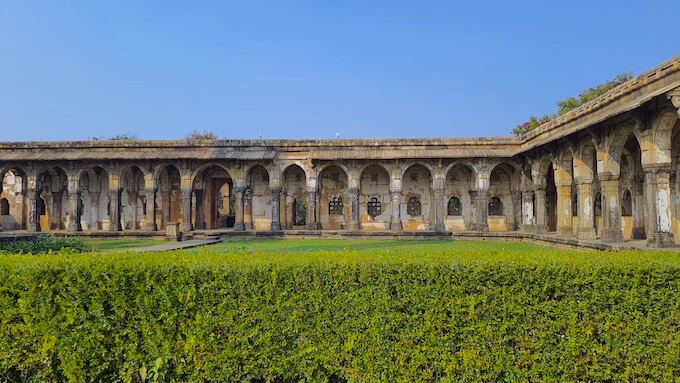
Here are some interesting facts about Champaner Archaeological Park – prior to it being inscribed as a UNESCO World Heritage Site in 2004. The first excavations at the site started only in the year 1969. Excavations were first carried out in Champaner and Pavagadh by a team from the Archaeology and History department of the Maharajah Sayajirao University of Baroda between 1969 and 1977.
The initial survey which focused more on the foothills of Pavagadh discovered the remains of an urban settlement, circular in shape. The settlement extended was spread over an area of about 6 square kilometres. According to the initial analysis the city had been well-planned and consisted of sectors with well-connected roads. The roads all led towards the Royal enclosures.
The excavations also revealed the existence of shop-like structures constituting markets, fairly well-preserved mosques, and cenotaphs. The most amazing of the finds were of course the existence of a complex system of water harvesting. A series of lakes, ponds, tanks, step wells, ring wells, and cisterns, complemented each other to provide water to the medieval city.
The archaeological evidence pointed to the fact that the city was well-provided with basic civic amenities. Also, the fact that the city was divided into sectors, pointed to the fact that society was then probably divided based on social, economic, and political, status.
The initial excavations did the spadework to establish Champaner and Pavagadh as glowing examples of Indian heritage. It also brought into focus the need for conserving this precious heritage. The efforts of all stakeholders culminated with Champaner-Pavagadh becoming the first site in Gujarat to get the UNESCO World Heritage Site tag in the year 2004, during the 28th session that was held in Suzhou, China.
History of Champaner-Pavagadh – Champaner Archaeological Park
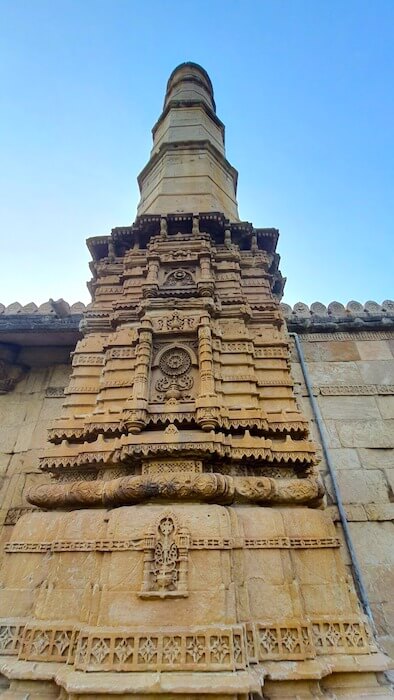
Historically speaking, the region around Champaner and Pavagadh dates back to pre-historic times . Stone tools and other evidence found in the vicinity, link the region to the Paleolithic and Mesolithic periods . The earliest known dynasty to have ruled over the region is that of the Maitrakas, who ruled between 470-776 CE. The discovery of copper coins and other evidence provide historical authenticity to this fact.
Copper plates of the Maitraka King Dhruvasena III, dated to around 653 CE have been discovered in Kapadvanj. According to these copper plates, the Maitrakas ruled over Shivbhagapura, which is believed to be the present-day Shivrajpur, located about 12 kilometres from Champaner.
The strategic importance of the location of the Champaner and Pavagadh region attracted many a dynasty to its fold. The region was a bridge between Gujarat and Malwa, which meant any army desirous of attacking Malwa, had to have control of this region. Thus it is no wonder, that various dynasties vied for power in the region, and these included the likes of the Rashtrakutas, the Gurjara Pratiharas, the Parmaras of Dhar, and the Chalukyas of Anhilwas Patan.
It is believed that the region of Pavagadh and Champaner came under the sway of the Khichi Chauhan Rajputs from Mewar, around 1300 CE. An inscription found in a stepwell called Nahani Umarvan near Champaner gives a genealogy of the Khichi Chauhan Rajputs and mentions 13 rulers of the dynasty. The inscription also points out that the 5th ruler of the dynasty, named Palhansila, established their hegemony over the region. The inscription also traces the lineage of the Khich Chauhan dynasty to the legendary Prithviraj Chauhan of Rajasthan .
The Khichi Chauhan rulers ruled over Champaner and Pavagadh till about the middle of the 15th century when they met their nemesis in the form of the Sultan of Gujarat, Mahmud Shah I, also known as Mahmud Begada.
The Gujarat Sultanate had been eyeing the fort of Pavagadh and Champaner since the beginning of the 15th century. There were unsuccessful attempts made to capture the kingdom by Sultan Ahmed Shah I, the founder of Ahmedabad , in 1418 and 1431. It was then the turn of his son, Muhammad Shah II to attack Champaner and Pavagadh in the year 1450. However, the Gujarat Sultanate again faced defeat, as the then-ruling king Gangadas fought valiantly and also sought the assistance of Sultan Mahmud Khalji, who was then the ruler of Malwa.
Mahmud Shah I was the Sultan in the year 1483, and he planned to fulfil the dreams of his father and grandfather. In the month of April 1483, his army laid siege to Champaner and Pavagadh. The siege lasted 20 months and ended in the fall of the last king of the Khichi Chauhan dynasty, Patai Jai Sinh.
Mahmud Shah I shifted his capital from Ahmedabad to Champaner and called it Muhammadabad. The move was a tactical one to further his designs against Malwa, which was his next frontier of conquest. Mahmud Shah I, by now had earned the name, “Mahmud Begada,” which meant, “Mahmud of Two Forts.” The two forts being referred to were those of Champaner and Junagadh which he had conquered.
Champaner flourished and prospered under the rule of Mahmud Begada. He ordered the building of religious structures, military fortifications, and a host of public utility projects for the welfare of the people were taken up. These included roads, bridges, water harvesting systems, and gardens.
However, all good things do come to an end, and the gradual decay of the Kingdom of Champaner and Pavagadh began, with the emergence of the Mughals on the Indian history scene. In the year 1534, Humayun attacked and plundered Champaner, a blow from which it never recovered.
The capital of the Gujarat Sultanate was shifted back to Ahmedabad. This seemed to be the signal for a series of conquerors to lay their sights on Champaner. Mahmud III, Shah Mirza, followed by Krishnaji Kadam successively captured the region, and finally, the Scindias of Gwalior took over, before handing the kingdom to the British in the year 1853.
Mahmud Begada made Champaner the capital of the Gujarat Sultanate and called it Muhammadabad, he also called it Shahar Mukarram – The Illustrious City
Champaner UNESCO World Heritage Site – Best Places to visit in Champaner | Important Monuments
Here are the main monuments that you must visit at the Champaner Pavagadh Archaeological Park .
Jami Masjid
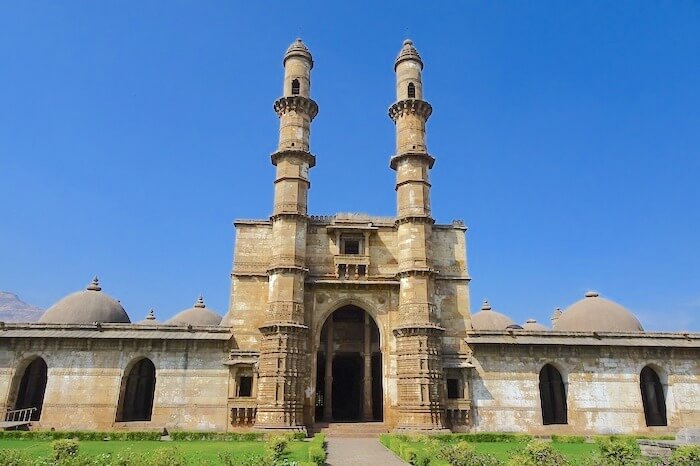
One of the most beautiful architectural legacies of Mahmud Begada is the Jami Masjid or Jama Masjid . An exquisite example of Indi-Islamic architecture the monument is well preserved, and its grandeur comes across strikingly.
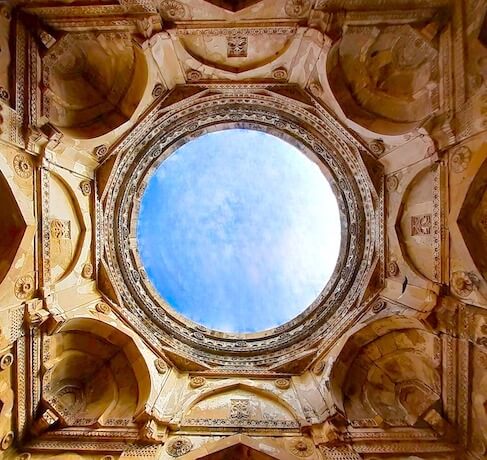
An inscription that was found in the mosque indicated that the structure was built between 1508-1509 CE. The mosque is ornamented with a central dome supported by 172 pillars.
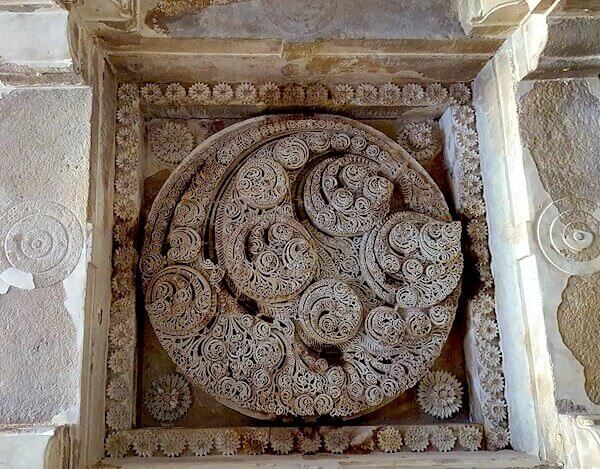
There are seven Mihrabs inside the central hall and the arched entrance is flanked by two elegant pillars on either side. Exquisite jali or stone-screen work and intricate carvings greet you at every corner of the Jami Masjid.
Shahar Ki Masjid
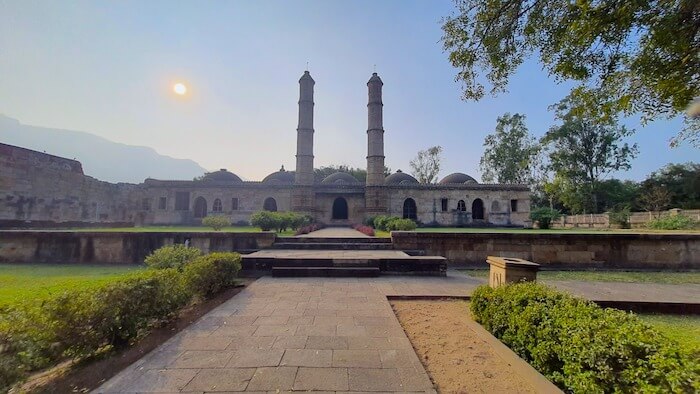
The Shahar Ki Masjid or City Mosque is another beautiful example of Indo-Islamic architecture that flourished before the Mughal Period. This was a mosque which was built for the use of the members of the royal family and other noblemen.
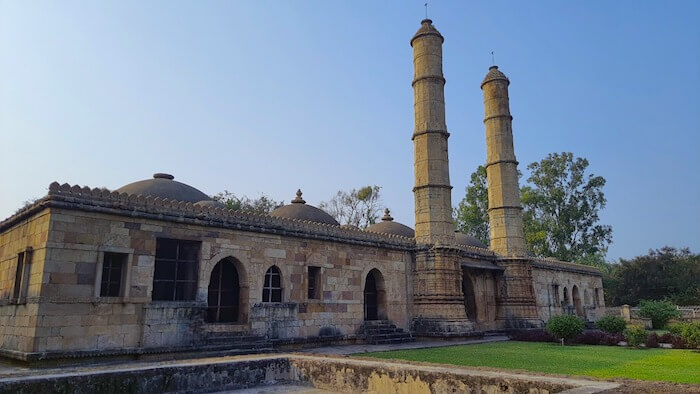
The mosque is an elegant and simple structure as compared to the more elaborate and ornate Jami Masjid. However, its beauty lies in its simplicity. It consists of 5 Mihrabs topped by 5 domes. It has five arched doors that are flanked by beautiful windows. Two minarets pierce the sky from near the main entrance to the mosque.
Kevada Masjid
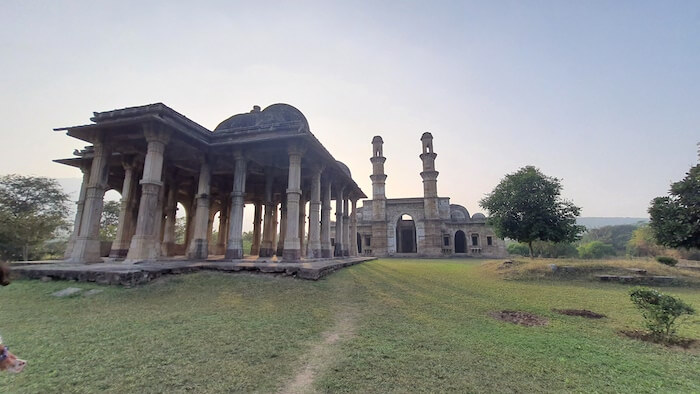
The Kevada Mosque is a fine example of the exquisite architecture of the period. The mosque whose central dome has unfortunately collapsed still retains its original charm.
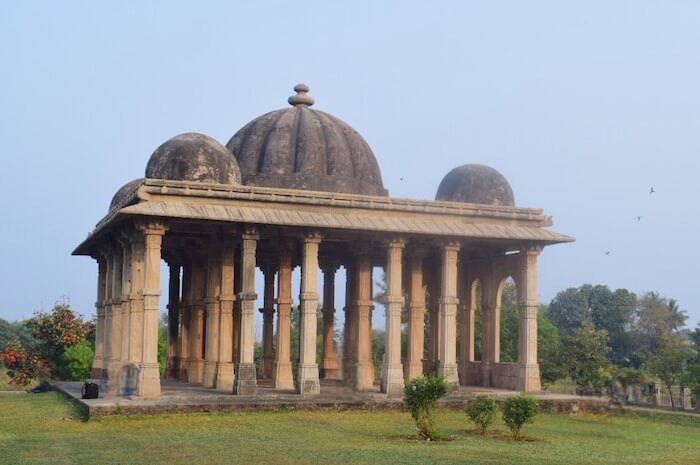
It is an intricate mosaic of pillars, niches, ornamental windows, and minarets. In front of the Kevada Mosque stands a large cenotaph which is in itself a beautiful structure with domes and cupolas.
Nagina Masjid
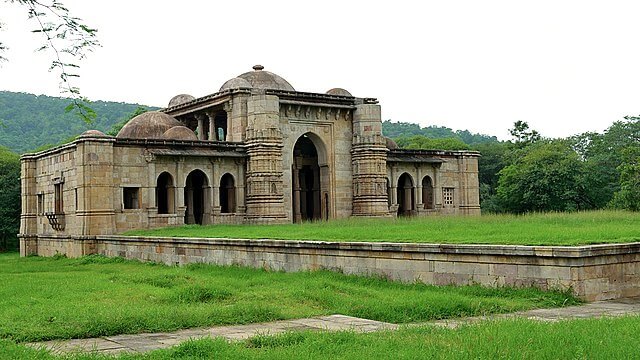
The Nagina Masjid has a central arched entrance topped by a central dome. It is flanked by a dome on either side. The structure is supported by 80 pillars and is made up of 10 cupolas. The Nagina Mosque is characterized by fine carvings bearing floral motifs.
Lila Gumbaj

The Gumbaj Ki Masjid is a smaller mosque. What remains of the structure today gives an idea of its form in its heyday. It consists of a central dome flanked by a dome on each side. The Lila Gumbaj too is characterized by intricate carvings of floral and other geometric motifs.
Ek Minar Ki Masjid
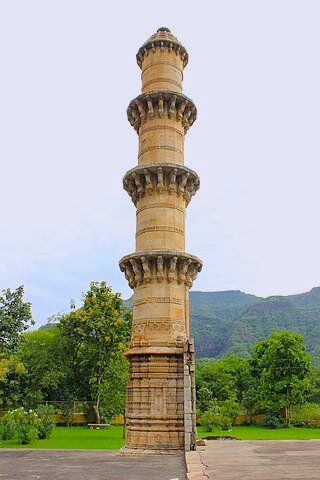
This is a mosque that has a solitary minaret, hence the name, Ek Minar Ki Masjid . This mosque is believed to have been built by Bahadur Shah, between 1526 to 1532. It was during the reign of Bahadur Shah, that Champaner first fell to the onslaught of the Mughal, Humayun. He did regain control over Champaner, however the deterioration of the once, grand empire was on an unstoppable trajectory.
Amir Manzil
The Amir Manzil Complex consists of the ruins of what was once the living quarters of the royal family of Champaner. It was made up of residential rooms, gardens, water channels, tanks and cisterns, stables, and more.
Based on archaeological evidence gathered by the team from the Archaeology Department of M.S. University, Baroda, it has been surmised, that the royal residents must have lived here for more than a century, at the least. Many precious and significant items like silver, terracotta, iron and copper items have been recovered from the site. These include coins, rings, and also Chinese porcelain items.
Helical Stepwell

Champaner was equipped with an advanced water-harvesting system. Its network of wells had earned it the sobriquet, “ City of Thousand Wells .” The region consisted of several natural lakes and ponds. Primarily among them were the Media Talao, the Tailia Talao, and the Dudhia Talao. Stepwells came up as a measure of harnessing natural water resources for daily utility.
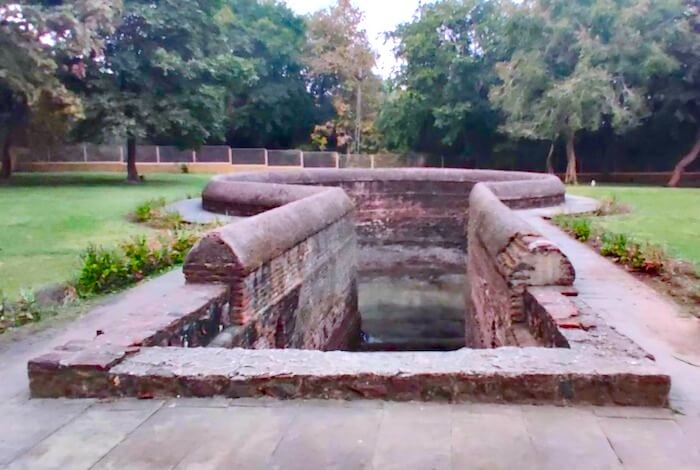
The Helical Stepwell which was built in the 16th century stands as an example of the many step-wells that made up an intricate system of water harvesting in Champaner. The Helical stepwell is fairly utilitarian and devoid of any sort of ornamentation. However, the spiral staircase that descends from ground level to the water presents a dramatic sight.
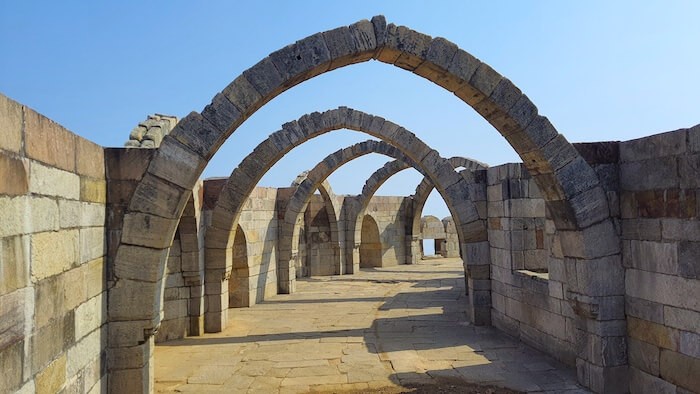
Saat Kaman is part of what was once a military structure. It is located at a vantage point that commands a view of the valley below and must have been impregnable in the past. The structure has a unique architectural design which consists of radially arranged arches which are seven in number. The number of arches is what lends the name, Saat Kaman to the structure. It literally translates as Seven Arches .
A Mint or Tankshala was established in the year 1484 by Mahmud Begada on Pavagadh Hill. This was one of the four mints that served the Gujarat Sultanate at that time. The other three mints were located at Ahmedabad, Ahmednagar, and Junagadh. It is believed that silver and copper coins were minted at the Pavagadh mint between the years 1485 to 1537.
Lakulisa Temple
The Lakulisa temple is believed to be the oldest of the structures existing within the Champaner Pavagadh Archaeological Park. It is believed to belong between the 10th and 11th centuries. The ruins of the Lakulisa temple are found on the Mauliya plateau of Pavagadh Hill.
The Lakulisha temple was a temple to Lakulisha who had some credit with the establishment of the Pashupata sect of Shaivism, though some quarters argue that Lakukisha was only the first formal teacher of the Pashupata sect. The temple though in ruins gives an idea of the structure and the iconography depicted on it. Some of the figures carved in the temple are those of Dakshinamurthi, Lakulisha, Surasundaris, Gajendra Moksha, Indra, and Ambika.
Mahakali Temple
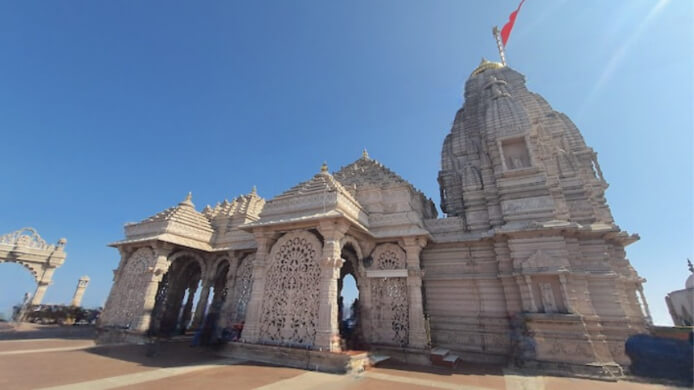
The Mahakali temple of Pavagadh is one of the most historical and important landmarks within the Champaner Pavagadh Archaeological Park. The temple deity was the family deity of the Khichi Chauhan dynasty that ruled over Pavagadh for many centuries. The Mahakali temple even finds a mention in the 15th-century Sanskrit drama called Gangadas Pratap Vilasa Natakam.
According to legend, the toe of Sati is believed to have fallen here and hence it is regarded as a Shakti Peeth. However, there is also a belief, that the hill of Pavagadh is itself the toe of Sati.
Jain Temples
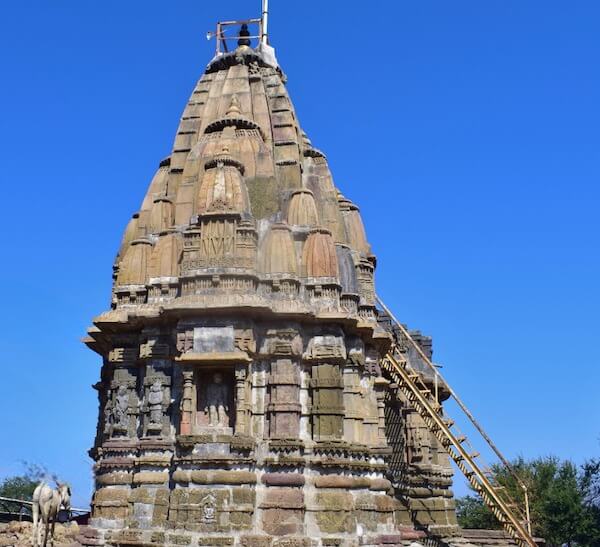
Pavagadh has not only been a sacred place for Hindus, but it has also been an important religious centre for Jains. There are many Jain temples dating back to the 13th and 14th centuries in Pavagadh. The temples belong to the Digambar Jain sect and include temples to Adinath, Parshwanath, and Chandraprabha.
Best Time To Visit Champaner Pavagadh Archaeological Park
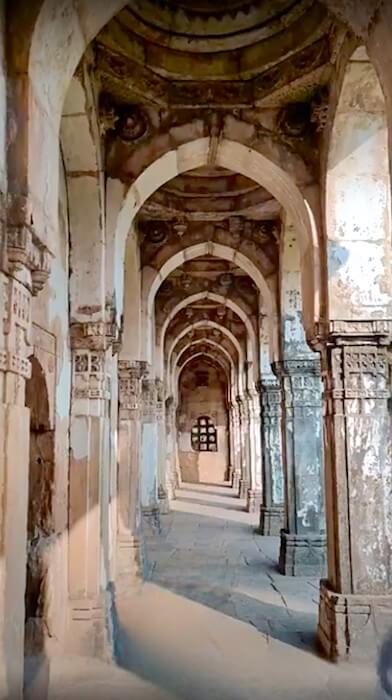
You can visit the Champaner-Pavagadh Archaeological Park throughout the year. However, the best time would be in the winter months between September to February. Summers are quite strong and sightseeing may not be very comfortable.
Images of Champaner-Pavagadh Archaeological Park
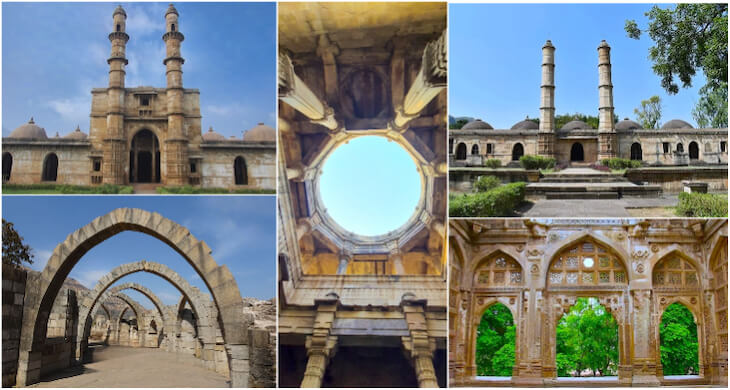
Here is a collage of Champaner Pavagadh Archaeological Park photos.

We hope these images from the Champaner-Pavagadh Archaeological Park convey in some small measure the enduring beauty of its monuments.
How To Reach Champaner Pavagadh Archaeological Park

Champaner Pavagadh Archaeological Park Location is about 49 kilometres from the city of Vadodara in Gujarat. The Archaeological Park is located in the city of Champaner, in the Panchmahal district of Gujarat, India. Click here for directions to reach Champaner Pavagadh Archaeological Park from Ahmedabad or Vadodara.
- Champaner-Pavagadh Archaeological Park is about 146 kilometres from Ahmedabad
- Champaner Pavagadh Archaeological Park is about 49 kilometres from Vadodara
- Surat is about 197 kilometres from Champaner-Pavagadh Archaeological Park
- Champaner-Pavagadh Archaeological Park is about 458 kilometres from Mumbai
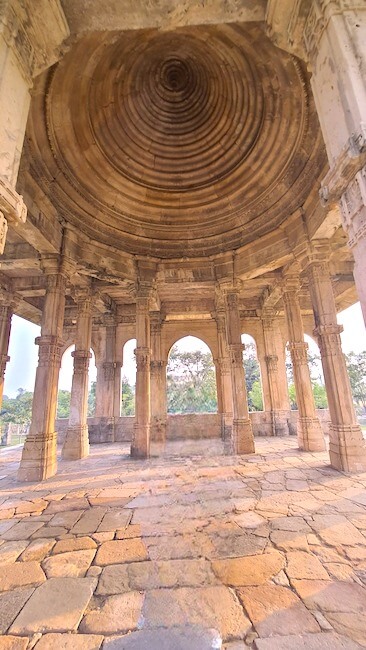
Reaching By Air The nearest airport to Champaner is the Vadodara Airport at a distance of about 43 kilometres. There are flights to and from Delhi , Bangalore , Mumbai , Hyderabad , and Chennai. However for more flight options, one can fly to Ahmedabad and then travel by road to Champaner and the Panchmahal District.
Reaching By Train The Panchmahal District is well connected by rail. The major railway station is Godhra, with trains to and from places like Delhi , Amritsar , and Mumbai . For more options, one can travel to Vadodara or Ahmedabad by train and travel to Champaner or any other place in the Panchmahal District by road.
Reaching By Road Gujarat has a well-connected road network that joins its various districts. One can travel across the state by buses run by G.S.R.T.C (Gujarat State Road Transport Corporation). You can take public transport from Ahmedabad or Vadodara, hire a cab, or drive down to Champaner, or any other place in the Panchmahal District. If you are planning a visit to Champaner or Pavagadh or any other place in Panchmahal , you can book your flight tickets right here through Cleartrip or Makemytrip or CheapAir or Priceline and fly to Ahmedabad or Vadodara. If you are thinking of a road trip , do check out the rental car options.
Where to stay in Champaner | Best places to stay in Champaner

There are a number of heritage resorts and other hotels in and around Champaner. You also have the option of staying in Vadodara and making a day trip to Champaner. There are many resorts and hotels to choose from for your stay in Champaner or Jambughoda. These include the Bhanu The Fern Forest Resort & Spa and the Jambughoda Palace which is a heritage hotel.
To book any of these hotels or any other hotel in the Panchmahal District or anywhere else you can book the best hotels in Panchmahal District, India right here – TripAdvisor or Cleartrip or makemytrip or goibibo or Booking.com or HotelsCombined or Agoda and save a lot by getting the best deals on booking your stay.
Tips To Visit Champaner Pavagadh Archaeological Park
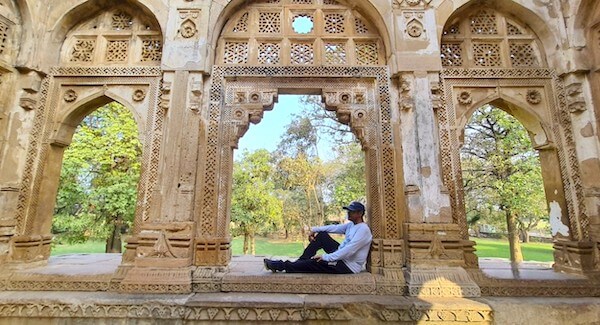
Here are some of the things to know before visiting Champaner Pavagadh Archaeological Park. These points are sure to stand you in good stead when you plan your visit to Champaner.
- Be aware that there are more than 100 monuments within the archaeological park
- You would need to be prepared for a bit of walking while visiting Champaner and Pavagadh
- Keep aside at least one day only for Pavagadh
- Once you have finished seeing the sights of Pavagadh, you can focus on the monuments in Champaner
- We recommend a minimum of 3 days for covering the Champaner-Pavagadh Archaeological Park
- Make sure you are equipped with sun protection gear and proper footwear
- Champaner Pavagadh Archaeological Park timings are generally from 8:30 AM to 5:00 PM
- Champaner Pavagadh Archaeological Park Ticket Price is nominal and currently INR 35 for Indian citizens, SAARC Nationals, and BIMSTEC Nationals, for other nationals it is INR 550
- You can book your tickets online for the Champaner-Pavagadh Archaeological Park at the ASI website of the Ministry of Culture at this link
- Carry your refillable water bottle
- Click photographs and create memories around the monuments
- Start early and preferably hire a cab to commute
- There is an entry ticket for the monuments
- Hire a guide to know in detail about each of the monuments
- Click here to check out good restaurants in the area
- The weather between September to February is cool and the best time to travel
- One would require a minimum of 2 days to 4 days to cover all the places of interest
- Booking a cab either from Vadodara or Ahmedabad would be ideal for visiting the places within this region
Champaner UNESCO World Heritage Site – FAQ
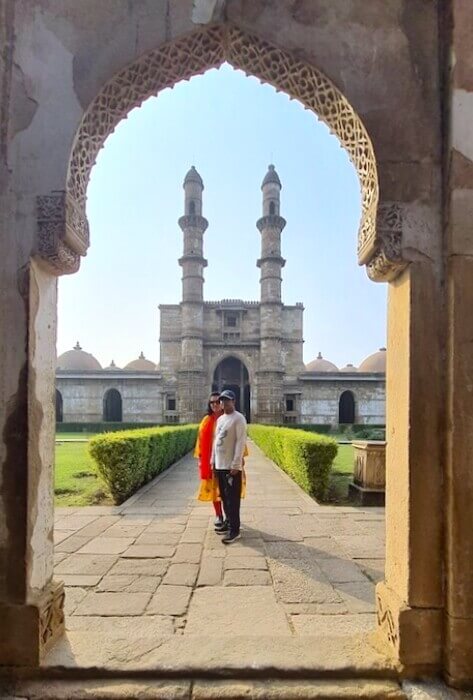
How to get around Champaner Archaeological Park?
The best option is to have your own vehicle to get around as it will offer more convenience and flexibility. The other option is to hire a local autorickshaw or jeep to ferry you across the archaeological park.
In which year was, Champaner declared a world heritage site?
The Champaner Pavagadh site was inscribed as a UNESCO World Heritage Site in 2004, at the 28th session of UNESCO in China.
Why is Champaner-Pavagadh Archaeological Park famous?
According to UNESCO itself, the site is the only unchanged pre-Mughal city. The site has over 100 monuments ranging from the 10th century till about the 16th century.
Why did UNESCO select Champaner as a World Heritage Site?
UNESCO selected Champaner-Pavagadh as a world heritage site based on its various criteria. The main reason was that it felt that the site was the only unchanged pre-Mughal city.
Who built Champaner-Pavagadh Archaeological Park?
Champaner as a city was believed to have been first established by Vanraj Chavda, and later it was made the capital of the Gujarat Sultanate by Mahmud Begada. Champaner-Pavagadh was designated as a UNESCO World Heritage Site and the Champaner-Pavagadh Archaeological Park was established in 2004.
Is Champaner open now?
The opening timings of Champaner-Pavagadh Archaeological Park are generally from 8:30 AM to 5:00 PM.
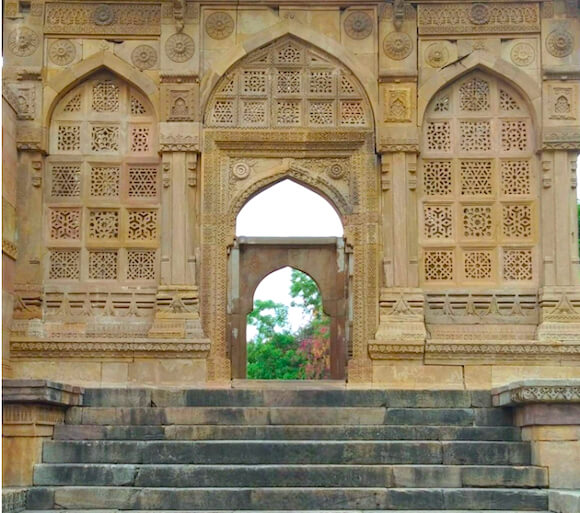
We hope you were as fascinated, reading about the Champaner-Pavagadh Archaeological Park and the history of the region, as we were in writing about it. Do let us know if you have any queries. We hope that the information we have shared here helps you plan your own trip, and this post serves as a Champaner-Pavagadh Archaeological Park Travel Guide , on your trip.
Subscribe to our blog to be notified whenever a new post is up. Follow us on our social media channels to stay abreast of our travels and travel stories. Our visit to Champaner Pavagadh Archaeological Park, Panchmahal District in Gujarat was part of a familiarization trip organized by India Tourism Mumbai – Ministry of Tourism, Government of India and Panchmahal District Administration . The views and opinions expressed in this blog post are our own. #ExplorePanchmahal #IncredibleIndia #DekhoApnaDesh #Gujarat #travel #panchmahaltour #exploringpanchmahal #ChampanerPavagadhArchaeologicalPark
Are you planning a last-minute Holiday? Below are some useful resources to help you book flights, hotels, and tours! And also clothes, luggage and accessories for your trip!
Flights – Cleartrip or Makemytrip or IndiGo or Cheapair or Priceline
Tours – Click to book top tours around the world . Book tours and activities here .
Experiences – Book your next unforgettable experience here , with flexible bookings and free cancellations. Reserve tours and activities now and pay later.
Hotels – Click to book the best hotels/resorts . Choose the best stay options with TripAdvisor or Cleartrip or makemytrip or goibibo or Booking.com or HotelsCombined or Agoda
Travel Insurance – Click to book Travel Insurance that covers a range of travel insurance and safety services including medical emergencies, lost luggage, trip cancellation and more
Visas and Travel Documents Application – Click here for Online Travel Visa Check
Online Passport Photo – Get Your Passport Photo Online here

Do You Love Traveling?
Do you want to know how to travel the world? We have put together a very useful travel resources page with the best travel tips . Go check it out now. Thanks for visiting our site Voyager - imvoyager.com and taking the time to read this post! If you wish to collaborate/work with us then reach us at [email protected] We’d love it if you’d comment by sharing your thoughts on this post and share this post on social media and with your friends. Follow our journey on our social media channels: Facebook X Instagram Pinterest YouTube
Start dreaming about your next adventure with Tripadvisor . Book your next unforgettable experience here with flexible bookings and free cancellations.

60+ Million Users Trust TripAdvisor With Their Travel Plans. Shouldn't You?

Explore these posts:
5 thoughts on “incredible champaner pavagadh archaeological park, gujarat”.
Appreciate you sharing this beautiful place with us! The architecture is really amazingly done. We too fancy visiting Unesco World Heritages and are always in awe of how culture is preserved.
The monuments preserved in this place are from renowned historical places 😍🤗 definitely this is like a heritage sight and next time when I come to Gujrat, will definitely visit here ❤️
Guajrat has many historical places to visit, I remember my visit to Rani ki Vav. Thanks for sharing this site, I will visit in my next India trips
We are planning a north Indian trip in May. I hope the climate would be favorable. Adding Champaner Pavagadh Archaeological Park to the list of historic monuments that we want to visit.
Your article is like a visual treat you can visit the place without leaving the house the pictures are amazing and so vibrant Thank you for sharing this
Leave a Comment Cancel Reply
Your email address will not be published. Required fields are marked *
This site uses Akismet to reduce spam. Learn how your comment data is processed .
Privacy Overview
Hotel Champaner

View prices for your travel dates
- Excellent 7
- Very Good 8
- All languages ( 20 )
- English ( 19 )
- Italian ( 1 )
" Go Luxury Delux Room - I like room number 505 "

" take upper floor rooms in winter and below rooms in summer... "
" Too good location "

" Choose rooms on higher side. it will give better view from gallery. "

" pls get a room backside for the superb view "
Own or manage this property? Claim your listing for free to respond to reviews, update your profile and much more.
Hotel Champaner - Reviews & Photos
- Privacy-Policy
Gujarat Darshan Guide
Gujarat Tourism, Stay, News, Culture
Champaner – Pavagadh Archaeological Park
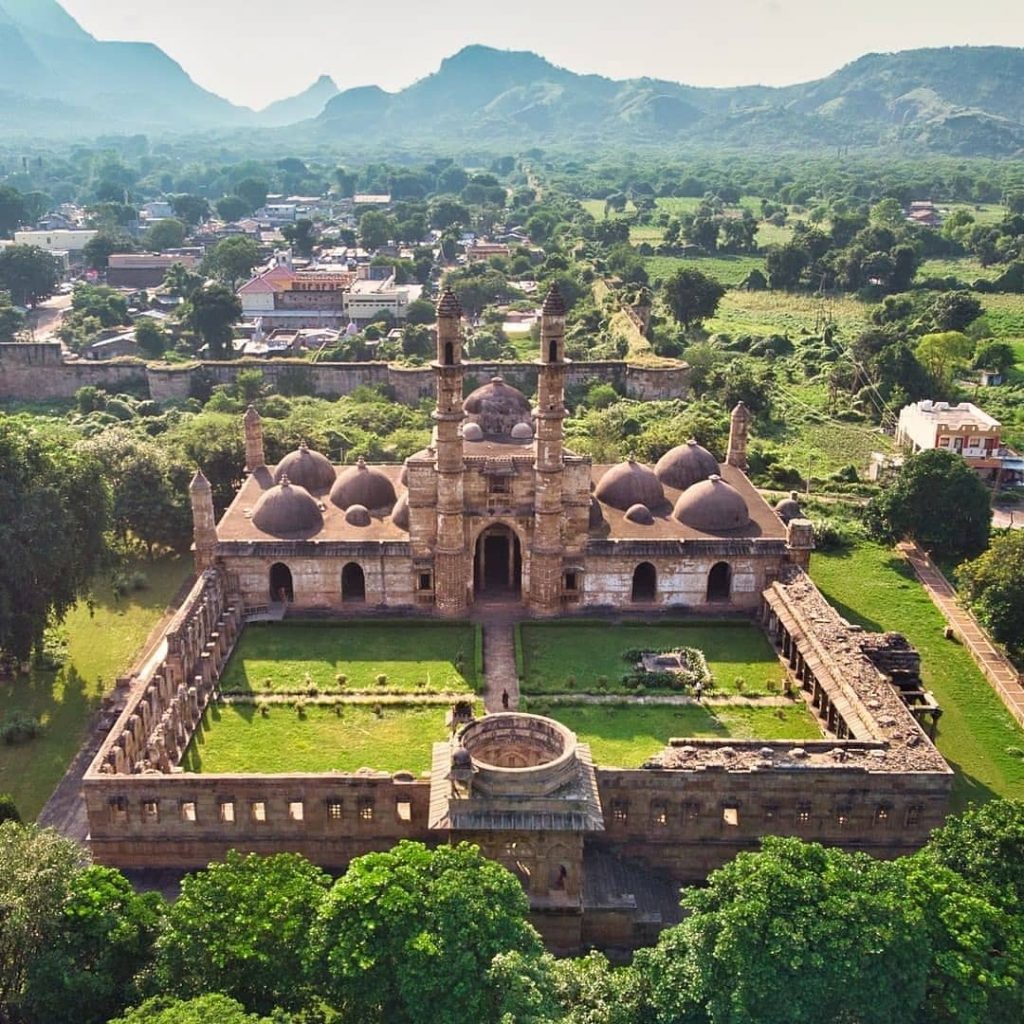
Table of Contents
Champaner – The Historical city Panchmahal Vadodara
Champaner is a historical city in the state of Gujarat, in western India. It is located in the Panchmahal district, 47 kilometers from the city of Vadodara. The city of Samu Lala was briefly the capital of the Sultanate of Gujarat.
Champaner was founded by Vanraj Chavda, the most prominent king of the Chavda Dynasty, in the 8th century. He named it after the name of his friend and general Champa, also known later as Champaraj. By the later 15th century, the Khichi Chauhan Rajputs held Pavagadh fort above the town of Champaner. The young Sultan of Gujarat, Mahmud Begada, deciding to attack Champaner, started towards it with his army on 4 December 1482. After defeating the Champaner army, Mahmud captured the town and besieged Pavagadh, the well-known hill-fortress, above Champaner, where king Jayasimha had taken refuge. He captured the Pavagadh fort on 21 November 1484, after a siege of 20 months. He then spent 23 years rebuilding and embellishing Champaner, which he renamed Muhammadabad, after which he moved the capital there from Ahmedabad.
Champaner is today the site of the Champaner-Pavagadh Archaeological Park, which UNESCO designated a World Heritage Site in 2004.
There are some places in champaner to visit.
- Maa Mahakalika Temple
- Jama Masjid
- Saher Masjid
- Nagina Masjid
- Kevda Masjid
- Lal Gumbaj Masjid
- Kamaani Masjid
- Bawaman Masjid
- Khajuri Masjid
- Jain Temple
- Udan Khatola at Manchi
- Amir Manzil
- Champaner Fort
- Citadel Of Mahmud Beghada
- Hissar I Khas
- Khapra Zaveri Palace
- Sikandar Shah S Tomb
- Virasat Van
- Khuniya Mahadev (Best to visit during monsoon season to enjoy waterfall near khuniya mahadev)
Pavagadh Fort
This is one of the most important tourist destinations in Champaner. During the Solanki reign, it used to be a palace. It now stands only in parts that are reminiscent of the ancient Hindu Lakulisa Temple and other Hindu and Jain temples of the Nagara style. It is situated atop Pavagadh Hill and is now preserved under the Archaeological Department of India
Champaner-Pavagadh Archaeological Park
This famous park is a historical rich concoction of unexcavated archaeological living and past cultural heritage properties like chalcolithic sites and remains of the 16th century capital state of Gujarat. This site is a mirror to the 8th-14th century Gujarat and it takes you back to the past through the various water installations, vagaries, residential precincts, fortifications and religious buildings of the contemporary period. The most important shrine of this park is the Kalikamata Temple which attracts a considerable number of tourists every year.
Jambughoda Wildlife Sanctuary
This sanctuary, located in the Panchmahal district of Central Gujarat, is home to a wide variety of plants and animals. Targol Round, a small part of the sanctuary, shares its space with the Vadodara district. This is a dense forest filled with fascinatingand magnificent species of trees like teak, bamboos and others. Two water reservoirs, one at Kada, the other at Kargol, amp up the aesthetic value of this place. The habitat is shared by animals such as leopards, wild boar, blue bulls, sloth bears, four-horned antelopes and jackals.
Sikander Shah’s tomb
Sikander Shah was the ruler of Champaner and was murdered by a man named Imad-ul-Mulk in 1526 AD. He and his brothers are buried here. It is a simple yet regal structure covered by fluted domes. Its architectural style is a remarkable mixture of craftsmanship and aesthetics. It is open all days of the week from 8 am to 6pm.
Masjids of Champaner
Champaner houses several famous mosques which stand testimony to time since the Mughal reign. Most of these date back to the 15th century. Some of these mosques are:
Nagina Masjid , situated on a high plinth which is placed in front of a wide open field. The center hall is surrounded by standing cenotaphs on three sides. The nearest cenotaph is beautifully carved with niches and columns.
Jama Masjid , the central mosque of Champaner is flanked by two 30m minarets at the entrance. The pillared courtyard and two-storied open arcades are intricately carved with jaalis and details.
Kevada Masjidhas cenotaphs near its tank for ritualistic reasons and also has carved mehrabs
Lila Gumbai ki Masjid lies on a raised platform, has a huge central dome that was once colored, and also has a hanging kalash in the central praying hall.
Sahar ki Masjid is located just next to the royal entrance and is believed to be the private mosques of many Sultans with domes overall its three entrances.
Helical Step well
This famous one-of-a-kind well has a spiraling narrow staircase along the walls of the well give it an unusual appearance. It is a 16th-century creation designed by one of the Champaner rulers as a part of the efforts to spur better water management in the period. November to February is the ideal time to pay a visit to this unique creation.
Very nice brother
Thanks brother for supporting…keep supporting…
Leave a Reply Cancel reply
Your email address will not be published. Required fields are marked *
Save my name, email, and website in this browser for the next time I comment.
- Gujarat hotels
- Hotels in Halol
Champaner Hotel- Gujarat Tourism
- View top recommended Hotels in Halol, Gujarat
Manchi Haveli, Gujarat 389360, India, Halol , Gujarat
8 People liked this hotel
Information about Champaner Hotel- Gujarat Tourism
Swimming Pool
Has Outdoor Pool
Free use of nearby fitness center
24 hour Front Desk
Meeting Rooms
Room Service
Air Conditioning
Elevator/lift
Family Rooms
Handicap Accessible
Located in the heart of Hālol, Champaner Hotel- Gujarat Tourism is a hotel with bar, swimming pool, outdoor pool and a 3.9 guest reviews rating.
Champaner Hotel- Gujarat Tourism has one of the most exquisite menus in the city, the on site restaurant treats guests to really fine dining. Guests can also unwind at the bar and enjoy an exotic drink.
Champaner Hotel- Gujarat Tourism has family friendly rooms that are well-spaced and are centrally air conditioned. High speed complimentary Wi-Fi access, flat screen TV, mini bar, tea & coffee making facilities.
Got a question? We have answers
Like this one but not totally sure yet?
Book rooms in Champaner Hotel- Gujarat Tourism online
Rooms , 1 Night
Total Price: ₹ 0

VALENTINE'S DAY SPECIALS
₦13,000 - ₦20,000 avg/night

Standard Room
loading rooms . . .
₹1,591 avg/night
0 rooms selected
Share on Whatsapp
You can claim a refund for the difference if you happen to find your reservation cheaper on another website.
Driving Instructions to Champaner Hotel- Gujarat Tourism
Find the quickest route to this hotel's address. We'll send you directions to Champaner Hotel- Gujarat Tourism - just enter your email address or phone number below:
Please enter a valid email address
Please enter a valid phone number
Driving Instructions have already been requested
Driving instructions have been sent to your email address and phone number
Driving instructions have been sent to your email address
Driving instructions have been sent to your phone number
Frequently asked questions about Champaner Hotel- Gujarat Tourism
Ask a question about champaner hotel- gujarat tourism.
Typically responds within 24 hours
Do you need to know anything about Champaner Hotel- Gujarat Tourism?
Be the first to ask a question
No FAQ.structured_faq
Reviews of Champaner Hotel- Gujarat Tourism
Based on 0 Guest Review s
Cleanliness
Service Quality
Contact Champaner Hotel- Gujarat Tourism
Timbu Reservations (Skype)

Nearby Hotels to Champaner Hotel- Gujarat Tourism in Halol
View other hotels in gujarat.

Jambudi, Gujarat 389..., Halol, Gujarat
₹1,532
Average price per night

Opp. Harmony Hotel,,..., Halol, Gujarat
₹2,752.29

Vadodara-Halol Highw..., Halol, Gujarat
₹2,000

Halol-Godhara Bypass..., Halol, Gujarat
₹2,105

Above bank of baroda..., Halol, Gujarat
₹799

2nd Floor, Hotel Nil..., Halol, Gujarat
₹1,591
See hotels near Halol
Have nice pictures of champaner hotel- gujarat tourism share them with us, unavailability schedule.
Hotel Champaner

View prices for your travel dates
Reviews we perform checks on reviews. tripadvisor’s approach to reviews before posting, each tripadvisor review goes through an automated tracking system, which collects information, answering the following questions: how, what, where and when. if the system detects something that potentially contradicts our community guidelines , the review is not published. when the system detects a problem, a review may be automatically rejected, sent to the reviewer for validation, or manually reviewed by our team of content specialists, who work 24/7 to maintain the quality of the reviews on our site. our team checks each review posted on the site disputed by our community as not meeting our community guidelines . learn more about our review moderation..
- Excellent 7
- Very Good 8
- All languages ( 20 )
- English ( 19 )
- Italian ( 1 )
" Go Luxury Delux Room - I like room number 505 "

" take upper floor rooms in winter and below rooms in summer... "
" Too good location "

" Choose rooms on higher side. it will give better view from gallery. "

" pls get a room backside for the superb view "
Own or manage this property? Claim your listing for free to respond to reviews, update your profile and much more.
HOTEL CHAMPANER - Reviews, Photos (Pavagadh, India - Gujarat)
Explore Champaner

Plan Your Trip to Champaner: Best of Champaner Tourism
Essential champaner.
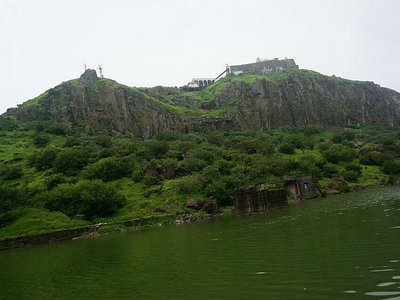
Champaner Is Great For
Art & history.
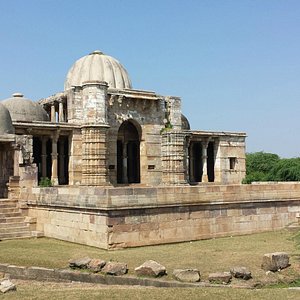

IMAGES
VIDEO
COMMENTS
While in Champaner Heritage Resort, there is a lot one can do — spend lazy afternoons by their pool, and go for nature walks and village visits. Arounds. Champaner-Pavagadh is the only UNESCO World Heritage Site located in Gujarat. The archaeological park is home to 114 monuments of which the Jami Masjid is the most famous.
Registered office: Udyog Bhavan, Block No. 16, 4th Floor, Sector-11, Gandhinagar - 382 010. Tel:079-23977219, 079-23977229. Fax: Not In Use Toll Free Number:1800 203 1111 E -mail: [email protected]
Hotel Champaner, Pavagadh, Gujarat: See 20 traveller reviews, 23 user photos and best deals for Hotel Champaner, ranked #1 of 1 Pavagadh, Gujarat hotel, rated 4 of 5 at Tripadvisor. ... We planed our trip to Jambughoda and surrounding place including chhota udeipur and decided to stay at Hotel Champaner at Manchi, Pavagadh. Since it was a first ...
The majestic charm of our havelies goes all the way to our rooms and suites. Each of our guest accommodations is reminiscent of the understated grandeur of Gujarat's rich heritage. We thoughtfully combine for you an authentic cultural experience of staying in a heritage property and all the modern luxuries to pamper you.
Champaner Heritage Resort, Halol - best luxury resorts near Pavagadh. With Superb accommodation options & amenities located near Pavagadh ... Champaner is a historical town in Gujarat that preserves its iconic heritage and glory. The resort lets you experience it all and much more within its palaces and gardens. Royal Suites.
About the Place: A UNESCO Heritage site, Champaner and Pavagadh are often clubbed together as one of the most engaging historical attractions of Gujarat.Pavagadh stands on top of the hill that looks over the sprawl of monuments at the base in Champaner. The duo makes a rich heritage site dotted with forts, mosques, monuments, tombs, arches, temples, step-wells and fortresses from 8th to 14th ...
Hotel Champaner Macchi ,Pavagadh. At. Manchi, Pavagadh, Taluka Halol, Dist, Panchmahal, Gujarat, India. Show on Map. The Hotel Champaner Macchi ,Pavagadh provides a great place for travelers to relax after a busy day. The Hotel Champaner Macchi ,Pavagadh offers a pleasant stay in Panchmahal for those traveling for business or leisure. Show More.
The Champaner Heritage Resort is a 50 km drive from Vadodara and if you are looking for a quiet overnight trip, to explore how the mid-century royals in Gujarat lived somewhat humbly, this is a great option. It took us less than 2 hours to drive from Vadodara to Champaner and the roads were smooth and the drive extremely scenic.
The area also has ropeway facilities, which transport tourists from Pavagadh Hill to Manchi Haveli. Jami Masjid. ... You can also look at other stay options like Mountain Heritage Resort and Champaner Hotel by Gujarat Tourism. Getting There. Vadodara is the closest airport to Champaner. The city is also well-connected through railways and roads.
Value. Travellers' Choice. Nestled amongst beautiful mango orchards, Champaner Heritage Resort sprawls lazily across 40 acres of greenery surrounded by hills and Dev Dam. A luxury resort in Gujurat with exceptional charm, architecture and style is located at the foothills of Pavagadh and near the backwater of Dev dam.
Hotel Champaner, Pavagadh, Gujarat: See 20 traveler reviews, 23 candid photos, and great deals for Hotel Champaner, ranked #1 of 1 hotel in Pavagadh, Gujarat and rated 4 of 5 at Tripadvisor.
Entry Fees to Champaner Pavagadh. Entry fees are 10 INR for Indians and 250 for Foreigners (Children up to 15 are free). Still photography is free. Ticket offices open at 8 am. If you do get there earlier, the fences are low enough to climb over - and of course pay for the ticket later.
Champaner Pavagadh offers a range of accommodation options to suit different preferences and budgets. Here are a few options to consider for your stay in this captivating destination: 1. Heritage Hotels and Resorts: Experience the charm of bygone eras by staying at a heritage hotel or resort in Champaner Pavagadh. These accommodations are often ...
A few interesting facts that you should know about Champaner are: Champaner's original name was Muhammadpur, and it was the capital of the Sultanate of Gujarat for a short period of time. Champaner is as old as the 8th century. It was named Champaner by the king after the name of a general Champa aka Champaraj.
Champaner is believed to be the last surviving ancient city with islamic architecture that predates the mughal era. During the 16th century, the Mughal Empire, under Emperor Humayun, sought to expand its territories and influence in India. Humayun, in his campaign against Gujarat, besieged Champaner in 1535 and looted the coffers.
The state of Gujarat is a mesmerizing treasure trove of Heritage, It has 4 UNESCO World Heritage sites currently, including the Champaner Pavagadh Archaeological Park.There are 3 sites on the tentative list. Apart from the Champaner-Pavagadh Archaeological Park Panchmahal, the other UNESCO World Heritage Sites are Rani Ki Vav in Patan, Dholavira, and the heritage city of Ahmedabad.
Hotel Champaner, Pavagadh, Gujarat: See 20 traveller reviews, 23 user photos and best deals for Hotel Champaner, ranked #1 of 1 Pavagadh, Gujarat hotel, rated 4 of 5 at Tripadvisor.
This hotel is being managed by Gujarat Tourism so i was not hopeful about my stay there but surprisingly the stay was comfortable. Cottages are spacious and having all facilities. Do no expect the 3 star or 5 star facility. At a place like Pavagadh such hotels are hard to find. Hotel is very near to the mandir. Walking distance from Ropeway.
It is a 16th-century creation designed by one of the Champaner rulers as a part of the efforts to spur better water management in the period. November to February is the ideal time to pay a visit to this unique creation. Champaner is a historical city in the state of Gujarat, in western India. It is located in the Panchmahal district, 47 ...
See pictures, verified reviews, rooms and get great discounts for Champaner Hotel- Gujarat Tourism only on Timbu.in! MENU. You can call us to book your hotel 000 000 000 0000 Call us. Timbu Reservations ₹ Choose your preferred currency for the hotel rates: ... Champaner Hotel- Gujarat Tourism. Manchi Haveli, Gujarat 389360, ...
Hotel Champaner, Pavagadh, India - Gujarat: See 20 traveller reviews, 23 candid photos, and great deals for Hotel Champaner, ranked #1 of 1 hotel in Pavagadh, India - Gujarat and rated 4 of 5 at Tripadvisor.
14. Religious Sites. Helical Step Well. 6. Points of Interest & Landmarks. Lila Gumbaj ki Masjid. 9. Religious Sites. Champaner Tourism: Tripadvisor has 301 reviews of Champaner Hotels, Attractions, and Restaurants making it your best Champaner Tourism resource.
The nearest major railway head is at Vadodara, which is 53 km away from Champaner. It is connected with other railheads in India. By Road: This is the cheapest option to reach Champaner from an accessible destination. Buses run by the Gujarat State Government are available from Ahmadabad and Vadodara. Photo Courtesy: Poonam Agarwal